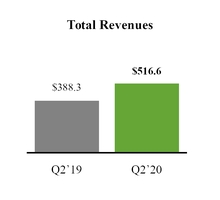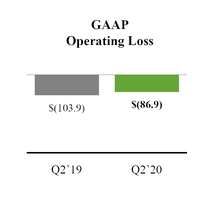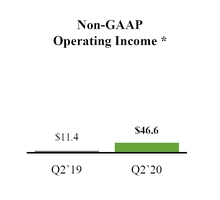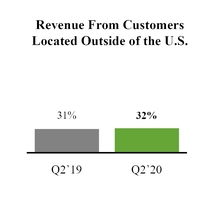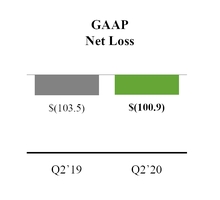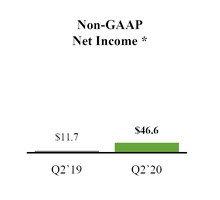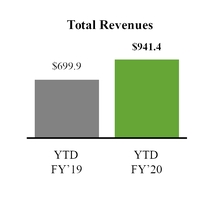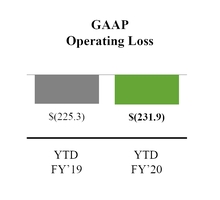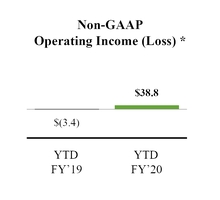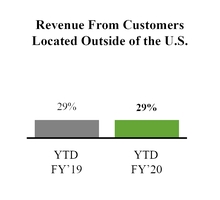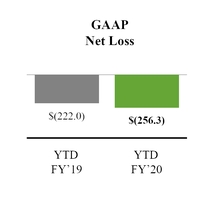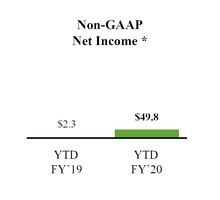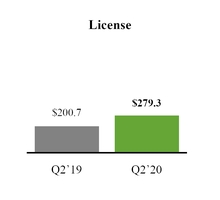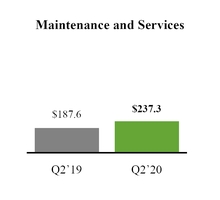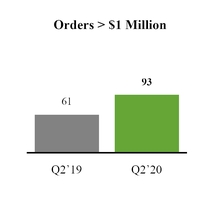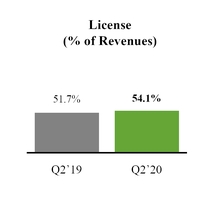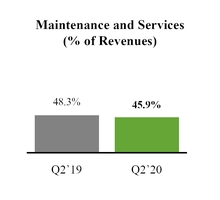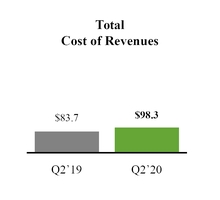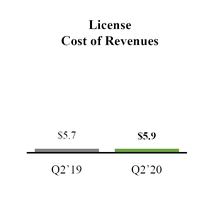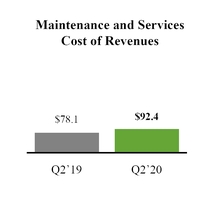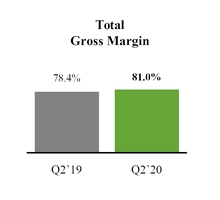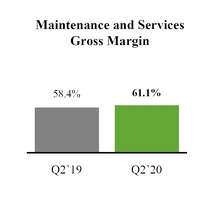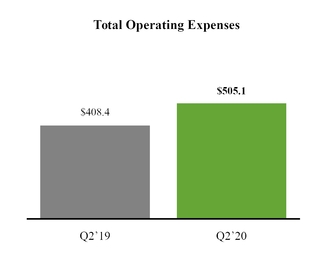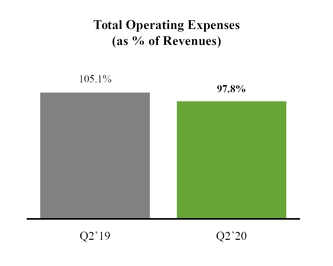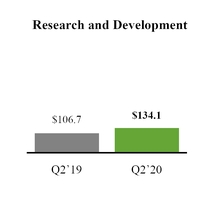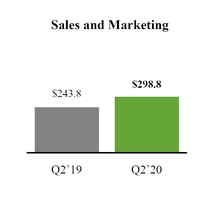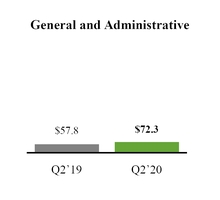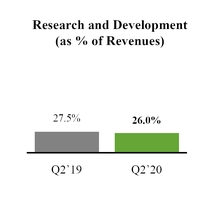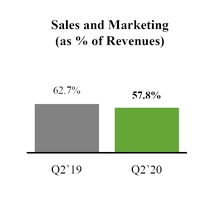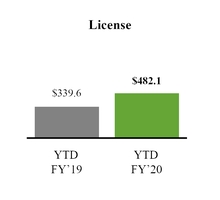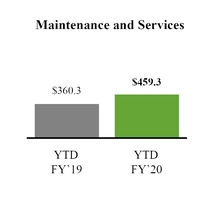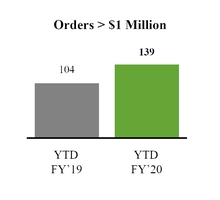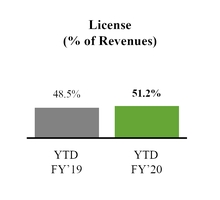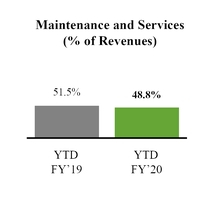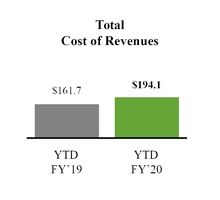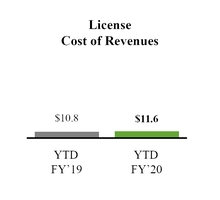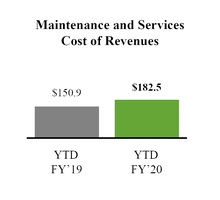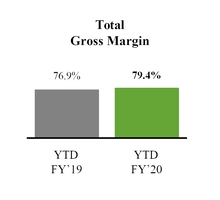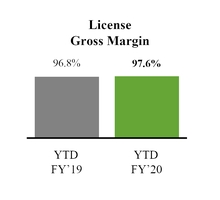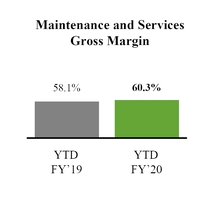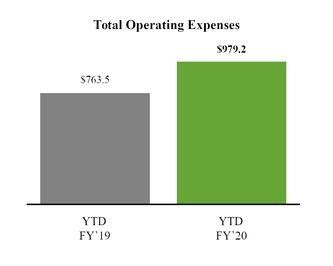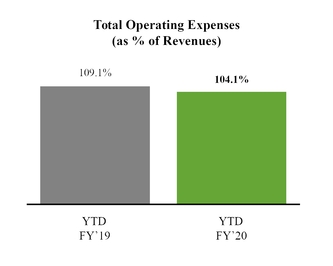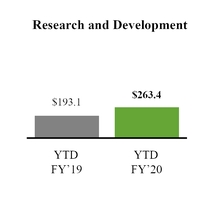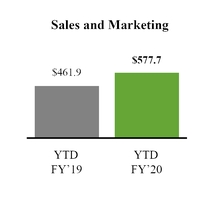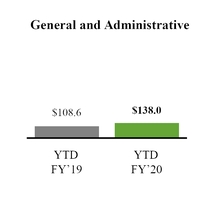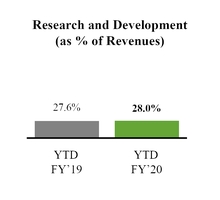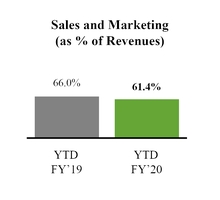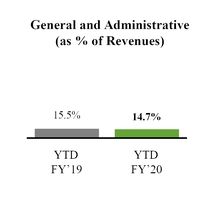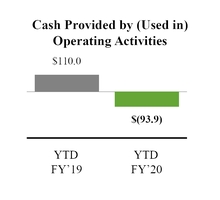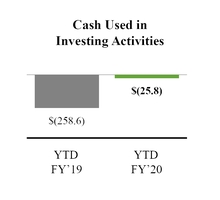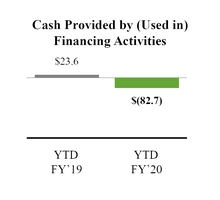UNITED STATES
SECURITIES AND EXCHANGE COMMISSION
Washington, D.C. 20549
FORM 10-Q
☒ QUARTERLY REPORT PURSUANT TO SECTION 13 OR 15(d) OF THE SECURITIES EXCHANGE ACT OF 1934
FOR THE QUARTERLY PERIOD ENDED JULY 31, 2019
OR
☐ TRANSITION REPORT PURSUANT TO SECTION 13 OR 15(d) OF THE SECURITIES EXCHANGE ACT OF 1934
FOR THE TRANSITION PERIOD FROM TO
COMMISSION FILE NUMBER 001-35498
____________________________________________________
Splunk Inc.
(Exact name of registrant as specified in its charter)
_____________________________________________________
|
| | |
| Delaware | | 86-1106510 |
| (State or other jurisdiction of | | (I.R.S. Employer |
| incorporation or organization) | | Identification No.) |
270 Brannan Street
San Francisco, California 94107
(Address of principal executive offices)
(Zip Code)
(415) 848-8400
(Registrant’s telephone number, including area code)
Securities registered pursuant to Section 12(b) of the Act:
|
| | | | |
| Title of each class | | Trading Symbol(s) | | Name of each exchange on which registered |
| Common Stock, par value $0.001 per share | | SPLK | | The NASDAQ Global Select Market |
Indicate by check mark whether the Registrant (1) has filed all reports required to be filed by Section 13 or 15(d) of the Securities Exchange Act of 1934 during the preceding 12 months (or for such shorter period that the Registrant was required to file such reports), and (2) has been subject to such filing requirements for the past 90 days. Yes ☒ No ☐
Indicate by check mark whether the Registrant has submitted electronically every Interactive Data File required to be submitted pursuant to Rule 405 of Regulation S-T during the preceding 12 months (or for such shorter period that the Registrant was required to submit such files). Yes ☒ No ☐
Indicate by check mark whether the Registrant is a large accelerated filer, an accelerated filer, a non-accelerated filer, a smaller reporting company, or an emerging growth company. See the definitions of “large accelerated filer,” “accelerated filer,” “smaller reporting company” and “emerging growth company” in Rule 12b-2 of the Exchange Act.
|
| | | |
| Large accelerated filer | ☒ | Accelerated filer | ☐ |
| | | | |
| Non-accelerated filer | ☐ | Smaller reporting company | ☐ |
| | | | |
| Emerging growth company | ☐ | | |
If an emerging growth company, indicate by check mark if the Registrant has elected not to use the extended transition period for complying with any new or revised financial accounting standards provided pursuant to Section 13(a) of the Exchange Act. ☐
Indicate by check mark whether the Registrant is a shell company (as defined in Rule 12b-2 of the Exchange Act). Yes ☐ No ☒
There were 151,348,574 shares of the Registrant’s Common Stock issued and outstanding as of August 29, 2019.
TABLE OF CONTENTS
|
| | | |
| | | | Page No. |
|
| | | | |
| Item 1. | | | |
| | | | |
| | | | |
| | | | |
| | | | |
| | | | |
| | | | |
| Item 2. | | | |
| Item 3. | | | |
| Item 4. | | | |
|
| | | | |
| Item 1. | | | |
| Item 1A. | | | |
| Item 6. | | | |
| | | | |
PART I. FINANCIAL INFORMATION
|
|
| Item 1. Financial Statements (Unaudited) |
Splunk Inc.
CONDENSED CONSOLIDATED BALANCE SHEETS
(Unaudited)
|
| | | | | | | | |
| (In thousands, except share and per share amounts) | | July 31, 2019 |
| January 31, 2019 |
| Assets | | |
| | |
|
| Current assets | | |
| | |
|
| Cash and cash equivalents | | $ | 1,672,005 |
| | $ | 1,876,165 |
|
| Investments, current | | 903,864 |
| | 881,220 |
|
| Accounts receivable, net | | 408,908 |
| | 469,658 |
|
| Prepaid expenses and other current assets | | 83,033 |
| | 73,197 |
|
| Deferred commissions, current | | 77,616 |
| | 78,223 |
|
| Total current assets | | 3,145,426 |
| | 3,378,463 |
|
| Investments, non-current | | 94,009 |
| | 110,588 |
|
| Operating lease right-of-use assets | | 215,228 |
| | — |
|
| Property and equipment, net | | 94,869 |
| | 158,276 |
|
| Intangible assets, net | | 77,417 |
| | 91,622 |
|
| Goodwill | | 503,388 |
| | 503,388 |
|
| Deferred commissions, non-current | | 64,705 |
| | 64,766 |
|
| Other assets | | 292,528 |
| | 193,140 |
|
| Total assets | | $ | 4,487,570 |
| | $ | 4,500,243 |
|
| Liabilities and Stockholders’ Equity | | |
| | |
|
| Current liabilities | | |
| | |
|
| Accounts payable | | $ | 25,924 |
| | $ | 20,418 |
|
| Accrued compensation | | 179,846 |
| | 226,061 |
|
| Accrued expenses and other liabilities | | 176,075 |
| | 125,641 |
|
| Deferred revenue, current | | 645,370 |
| | 673,018 |
|
| Total current liabilities | | 1,027,215 |
| | 1,045,138 |
|
| Convertible senior notes, net | | 1,673,569 |
| | 1,634,474 |
|
| Operating lease liabilities | | 191,471 |
| | — |
|
| Deferred revenue, non-current | | 160,888 |
| | 204,929 |
|
| Other liabilities, non-current | | 587 |
| | 95,245 |
|
| Total non-current liabilities | | 2,026,515 |
| | 1,934,648 |
|
| Total liabilities | | 3,053,730 |
| | 2,979,786 |
|
| Commitments and contingencies (Note 3) | |
|
| |
|
|
| Stockholders’ equity | | |
| | |
|
| Common stock: $0.001 par value; 1,000,000,000 shares authorized; 151,344,012 shares issued and outstanding at July 31, 2019, and 149,167,298 shares issued and outstanding at January 31, 2019 | | 151 |
| | 149 |
|
| Accumulated other comprehensive loss | | (3,484 | ) | | (2,506 | ) |
| Additional paid-in capital | | 2,918,277 |
| | 2,754,858 |
|
| Accumulated deficit | | (1,481,104 | ) | | (1,232,044 | ) |
| Total stockholders’ equity | | 1,433,840 |
| | 1,520,457 |
|
| Total liabilities and stockholders’ equity | | $ | 4,487,570 |
| | $ | 4,500,243 |
|
The accompanying notes are an integral part of these condensed consolidated financial statements.
Splunk Inc.
CONDENSED CONSOLIDATED STATEMENTS OF OPERATIONS
(Unaudited)
|
| | | | | | | | | | | | | | | | |
| | | Three Months Ended July 31, | | Six Months Ended July 31, |
| (In thousands, except per share amounts) | | 2019 | | 2018 | | 2019 | | 2018 |
| Revenues | | | | | | | | |
| License | | $ | 279,279 |
| | $ | 200,668 |
| | $ | 482,141 |
| | $ | 339,643 |
|
| Maintenance and services | | 237,279 |
| | 187,635 |
| | 459,267 |
| | 360,299 |
|
| Total revenues | | 516,558 |
| | 388,303 |
| | 941,408 |
| | 699,942 |
|
Cost of revenues (1) | | | | | | | | |
| License | | 5,936 |
| | 5,671 |
| | 11,618 |
| | 10,795 |
|
| Maintenance and services | | 92,372 |
| | 78,077 |
| | 182,513 |
| | 150,923 |
|
| Total cost of revenues | | 98,308 |
| | 83,748 |
| | 194,131 |
| | 161,718 |
|
| Gross profit | | 418,250 |
| | 304,555 |
| | 747,277 |
| | 538,224 |
|
Operating expenses (1) | | | | | | | | |
| Research and development | | 134,110 |
| | 106,739 |
| | 263,400 |
| | 193,096 |
|
| Sales and marketing | | 298,773 |
| | 243,830 |
| | 577,734 |
| | 461,866 |
|
| General and administrative | | 72,264 |
| | 57,844 |
| | 138,026 |
| | 108,586 |
|
| Total operating expenses | | 505,147 |
| | 408,413 |
| | 979,160 |
| | 763,548 |
|
| Operating loss | | (86,897 | ) | | (103,858 | ) | | (231,883 | ) | | (225,324 | ) |
| Interest and other income (expense), net | | | | | | | | |
| Interest income | | 16,415 |
| | 3,564 |
| | 32,761 |
| | 6,751 |
|
| Interest expense | | (24,104 | ) | | (2,058 | ) | | (47,121 | ) | | (4,131 | ) |
| Other income (expense), net | | (654 | ) | | (336 | ) | | (1,193 | ) | | (471 | ) |
| Total interest and other income (expense), net | | (8,343 | ) | | 1,170 |
| | (15,553 | ) | | 2,149 |
|
| Loss before income taxes | | (95,240 | ) | | (102,688 | ) | | (247,436 | ) | | (223,175 | ) |
| Income tax provision (benefit) | | 5,632 |
| | 811 |
| | 8,865 |
| | (1,177 | ) |
| Net loss | | $ | (100,872 | ) | | $ | (103,499 | ) | | $ | (256,301 | ) | | $ | (221,998 | ) |
| | | | | | | | | |
| Basic and diluted net loss per share | | $ | (0.67 | ) | | $ | (0.71 | ) | | $ | (1.71 | ) | | $ | (1.54 | ) |
| | | | | | | | | |
| Weighted-average shares used in computing basic and diluted net loss per share | | 150,306 |
| | 145,030 |
| | 149,723 |
| | 144,306 |
|
_________________________
| |
(1) | Amounts include stock-based compensation expense, as follows: |
|
| | | | | | | | | | | | | | | | |
| Cost of revenues | | $ | 10,459 |
|
| $ | 8,947 |
|
| $ | 21,284 |
| | $ | 17,751 |
|
| Research and development | | 40,451 |
|
| 33,597 |
|
| 81,719 |
| | 60,013 |
|
| Sales and marketing | | 49,007 |
|
| 45,546 |
|
| 99,275 |
| | 88,593 |
|
| General and administrative | | 23,096 |
|
| 16,953 |
|
| 43,798 |
| | 33,307 |
|
The accompanying notes are an integral part of these condensed consolidated financial statements.
Splunk Inc.
CONDENSED CONSOLIDATED STATEMENTS OF COMPREHENSIVE LOSS
(Unaudited)
|
| | | | | | | | | | | | | | | | |
| | | Three Months Ended July 31, | | Six Months Ended July 31, |
| (In thousands) | | 2019 | | 2018 | | 2019 | | 2018 |
| Net loss | | $ | (100,872 | ) | | $ | (103,499 | ) | | $ | (256,301 | ) | | $ | (221,998 | ) |
| Other comprehensive gain (loss) | | | | | | | | |
| Net unrealized gain on investments (net of tax) | | 710 |
| | 515 |
| | 1,042 |
| | 707 |
|
| Foreign currency translation adjustments | | (1,029 | ) | | (1,707 | ) | | (2,020 | ) | | (3,593 | ) |
| Total other comprehensive loss | | (319 | ) | | (1,192 | ) | | (978 | ) | | (2,886 | ) |
| Comprehensive loss | | $ | (101,191 | ) | | $ | (104,691 | ) | | $ | (257,279 | ) | | $ | (224,884 | ) |
The accompanying notes are an integral part of these condensed consolidated financial statements.
Splunk Inc.
CONDENSED CONSOLIDATED STATEMENTS OF CASH FLOWS
(Unaudited)
|
| | | | | | | | |
| | | Six Months Ended July 31, |
| (In thousands) | | 2019 | | 2018 |
| Cash flows from operating activities | | |
| | |
|
| Net loss | | $ | (256,301 | ) | | $ | (221,998 | ) |
| Adjustments to reconcile net loss to net cash provided by (used in) operating activities: | | | | |
| Depreciation and amortization | | 27,141 |
| | 24,167 |
|
| Amortization of deferred commissions | | 53,882 |
| | 32,877 |
|
| Amortization of investment premiums (accretion of discounts) | | (5,645 | ) | | (537 | ) |
| Amortization of debt discount and issuance costs | | 39,095 |
| | — |
|
| Stock-based compensation | | 246,076 |
| | 199,664 |
|
| Deferred income taxes | | (184 | ) | | (125 | ) |
| Changes in operating assets and liabilities, net of acquisitions: | | | | |
| Accounts receivable, net | | 60,750 |
| | 156,362 |
|
| Prepaid expenses and other assets | | (110,349 | ) | | (21,937 | ) |
| Deferred commissions | | (53,214 | ) | | (43,360 | ) |
| Accounts payable | | 5,316 |
| | 2,990 |
|
| Accrued compensation | | (46,215 | ) | | (11,833 | ) |
| Accrued expenses and other liabilities | | 17,395 |
| | 6,259 |
|
| Deferred revenue | | (71,689 | ) | | (12,518 | ) |
| Net cash provided by (used in) operating activities | | (93,942 | ) | | 110,011 |
|
| Cash flows from investing activities | | | | |
| Purchases of investments | | (539,723 | ) | | (198,631 | ) |
| Maturities of investments | | 541,595 |
| | 347,176 |
|
| Acquisitions, net of cash acquired | | — |
| | (394,910 | ) |
| Purchases of property and equipment | | (26,434 | ) | | (7,858 | ) |
| Other investment activities | | (1,250 | ) | | (4,375 | ) |
| Net cash used in investing activities | | (25,812 | ) | | (258,598 | ) |
| Cash flows from financing activities | | | | |
| Proceeds from the exercise of stock options | | 556 |
| | 1,354 |
|
| Proceeds from employee stock purchase plan | | 34,482 |
| | 24,201 |
|
| Taxes paid related to net share settlement of equity awards | | (117,693 | ) | | (779 | ) |
| Repayment of financing lease obligation | | — |
| | (1,218 | ) |
| Net cash provided by (used in) financing activities | | (82,655 | ) | | 23,558 |
|
| Effect of exchange rate changes on cash and cash equivalents | | (1,751 | ) | | (1,237 | ) |
| Net decrease in cash and cash equivalents | | (204,160 | ) | | (126,266 | ) |
| Cash and cash equivalents at beginning of period | | 1,876,165 |
| | 545,947 |
|
| Cash and cash equivalents at end of period | | $ | 1,672,005 |
| | $ | 419,681 |
|
| | | | | |
| Supplemental disclosures | | | | |
| Cash paid for income taxes | | $ | 15,249 |
| | $ | 4,035 |
|
| Cash paid for interest | | 7,747 |
| | 4,123 |
|
| Non-cash investing activities | | | | |
| Increase (decrease) in accrued purchases of property and equipment | | (274 | ) | | 129 |
|
The accompanying notes are an integral part of these condensed consolidated financial statements.
Splunk Inc.
CONDENSED CONSOLIDATED STATEMENTS OF STOCKHOLDERS’ EQUITY
(Unaudited)
|
| | | | | | | | | | | | | | | | |
| | | Three Months Ended July 31, | | Six Months Ended July 31, |
| (In thousands) | | 2019 | | 2018 | | 2019 | | 2018 |
| Common stock | | | | | | | | |
| Balance, beginning of period | | $ | 150 |
| | $ | 144 |
| | $ | 149 |
| | $ | 143 |
|
| Issuance of restricted stock awards | | — |
| | — |
| | — |
| | 1 |
|
| Vesting of restricted stock units | | 1 |
| | 2 |
| | 2 |
| | 2 |
|
| Balance, end of period | | $ | 151 |
| | $ | 146 |
| | $ | 151 |
| | $ | 146 |
|
| Additional paid-in capital | | | | | | | | |
| Balance, beginning of period | | $ | 2,809,273 |
| | $ | 2,194,900 |
| | $ | 2,754,858 |
| | $ | 2,086,893 |
|
| Stock-based compensation | | 123,013 |
| | 105,043 |
| | 246,076 |
| | 199,664 |
|
| Issuance of common stock upon exercise of options | | 195 |
| | 241 |
| | 554 |
| | 1,353 |
|
| Fair value of replacement equity awards attributable to pre-acquisition service | | — |
| | 3,502 |
| | — |
| | 15,776 |
|
| Taxes paid related to net share settlement of equity awards | | (48,686 | ) | | — |
| | (117,693 | ) | | — |
|
| Issuance of common stock upon ESPP purchase | | 34,482 |
| | 24,199 |
| | 34,482 |
| | 24,199 |
|
| Balance, end of period | | $ | 2,918,277 |
| | $ | 2,327,885 |
| | $ | 2,918,277 |
| | $ | 2,327,885 |
|
| Accumulated other comprehensive loss | | | | | | | | |
| Balance, beginning of period | | $ | (3,165 | ) | | $ | (1,538 | ) | | $ | (2,506 | ) | | $ | 156 |
|
| Unrealized gain from investments | | 710 |
| | 515 |
| | 1,042 |
| | 707 |
|
| Net change in cumulative translation adjustments | | (1,029 | ) | | (1,707 | ) | | (2,020 | ) | | (3,593 | ) |
| Balance, end of period | | $ | (3,484 | ) | | $ | (2,730 | ) | | $ | (3,484 | ) | | $ | (2,730 | ) |
| Accumulated deficit | | | | | | | | |
| Balance, beginning of period | | $ | (1,380,232 | ) | | $ | (1,074,966 | ) | | $ | (1,232,044 | ) | | $ | (955,871 | ) |
| Cumulative-effect adjustment from adoption of ASU 2016-02 | | — |
| | — |
| | 7,241 |
| | — |
|
| Cumulative-effect adjustment from adoption of ASU 2016-16 | | — |
| | — |
| | — |
| | (596 | ) |
| Net loss | | (100,872 | ) | | (103,499 | ) | | (256,301 | ) | | (221,998 | ) |
| Balance, end of period | | $ | (1,481,104 | ) | | $ | (1,178,465 | ) | | $ | (1,481,104 | ) | | $ | (1,178,465 | ) |
| | | | | | | | | |
| Total stockholders’ equity | | $ | 1,433,840 |
| | $ | 1,146,836 |
| | $ | 1,433,840 |
| | $ | 1,146,836 |
|
The accompanying notes are an integral part of these condensed consolidated financial statements.
NOTES TO CONDENSED CONSOLIDATED FINANCIAL STATEMENTS
(Unaudited)
(1) Description of the Business and Significant Accounting Policies
Business
Splunk Inc. (“we,” “us,” “our”) provides innovative software solutions that enable organizations to gain real-time operational intelligence by harnessing the value of their data. Our offerings enable users to investigate, monitor, analyze and act on machine data regardless of format or source. Our offerings address large and diverse data sets commonly referred to as big data and are specifically tailored for machine data. Machine data is produced by nearly every software application and electronic device across an organization and contains a real-time record of various activities, such as transactions, customer and user behavior, and security threats. Our offerings help users derive new insights from machine data that can be used to, among other things, improve service levels, reduce operational costs, mitigate security risks, demonstrate and maintain compliance, and drive better business decisions. We were incorporated in California in October 2003 and reincorporated in Delaware in May 2006.
Fiscal Year
Our fiscal year ends on January 31. References to fiscal 2020, for example, refer to the fiscal year ending January 31, 2020.
Basis of Presentation
The accompanying unaudited condensed consolidated financial statements have been prepared in accordance with generally accepted accounting principles in the United States (“GAAP”) and applicable rules and regulations of the Securities and Exchange Commission (“SEC”) regarding interim financial reporting. Certain information and note disclosures normally included in the financial statements prepared in accordance with GAAP have been condensed or omitted pursuant to such rules and regulations. The condensed consolidated balance sheet data as of January 31, 2019 was derived from audited financial statements, but does not include all disclosures required by GAAP. Therefore, these condensed consolidated financial statements should be read in conjunction with the consolidated financial statements and notes included in the Annual Report on Form 10-K for the fiscal year ended January 31, 2019, filed with the SEC on March 27, 2019.
In the opinion of management, the accompanying unaudited condensed consolidated financial statements reflect all normal recurring adjustments necessary to state fairly the financial position, results of operations, comprehensive loss and cash flows for the interim periods, but are not necessarily indicative of the results of operations to be anticipated for the full fiscal 2020.
Reclassifications
Certain reclassifications have been made to prior year balances in order to conform to the current period presentation. “Interest income” and “Interest expense” have been reclassified from “Interest income (expense), net” on the condensed consolidated statements of operations. These reclassifications had no impact on the previously reported net loss or accumulated deficit.
Use of Estimates
The preparation of financial statements in conformity with U.S. GAAP requires management to make estimates, judgments and assumptions that affect the reported amounts of assets and liabilities and disclosure of contingent assets and liabilities at the date of the financial statements and reported amounts of revenues and expenses during the reporting periods covered by the financial statements and accompanying notes. In particular, we make estimates with respect to the stand-alone selling price for each distinct performance obligation included in customer contracts with multiple performance obligations, uncollectible accounts receivable, the assessment of the useful life and recoverability of long-lived assets (property and equipment, goodwill and identified intangibles), the period of benefit for deferred commissions, stock-based compensation expense, the fair value of assets acquired and liabilities assumed for business combinations, income taxes, the discount rate used for operating leases, and contingencies. Actual results could differ from those estimates.
Segments
We operate our business as 1 operating segment: the development and marketing of software solutions that enable our customers to gain real-time operational intelligence by harnessing the value of their data. Our chief operating decision maker is our Chief Executive Officer, who reviews financial information presented on a consolidated basis for purposes of making operating decisions, assessing financial performance and allocating resources.
Principles of Consolidation
The accompanying unaudited condensed consolidated financial statements include the accounts of Splunk Inc. and its direct and indirect wholly-owned subsidiaries. All intercompany balances and transactions have been eliminated upon consolidation.
Leases
We determine if an arrangement contains a lease and the classification of that lease, if applicable, at the inception of a contract. We primarily lease our facilities under operating leases. Operating lease right-of-use assets and liabilities are recognized at the present value of the future lease payments at the lease commencement date. We calculate the operating lease right-of-use assets based on the corresponding lease liability adjusted for (i) payments made at or before the commencement date, (ii) initial direct costs we incur and (iii) tenant incentives under the lease. We do not account for renewals or early terminations unless we are reasonably certain to exercise these options at commencement. Operating lease expense is recognized on a straight-line basis over the lease term. We account for lease and non-lease components as a single lease component for our operating leases. We do not record leases with terms of 12 months or less on our condensed consolidated balance sheets.
As the implicit rate for our operating leases is generally not determinable, we use our incremental borrowing rate as our discount rate at the lease commencement date to determine the present value of lease payments. We determine the discount rate of our leases by considering various factors, such as our credit rating, interest rates of similar debt instruments of entities with comparable credit ratings, the lease term and the currency in which the lease is denominated. Our discount rate was determined using a portfolio approach.
Our operating lease assets are included in “Operating lease right-of-use assets” and the current and non-current portions of our operating lease liabilities are included in “Accrued expenses and other liabilities” and “Operating lease liabilities,” respectively, on our condensed consolidated balance sheets. As of July 31, 2019, we had no finance leases. Refer to Note 4 “Leases” for details.
Foreign Currency
The functional currency of our foreign subsidiaries is their respective local currency, with the exception of our United Kingdom subsidiary, in which the functional currency is the U.S. dollar. Translation adjustments arising from the use of differing exchange rates from period to period are included in “Accumulated other comprehensive income (loss)” within the condensed consolidated statements of stockholders’ equity. Foreign currency transaction gains and losses are included in “Other income (expense), net.” All assets and liabilities denominated in a foreign currency are translated into U.S. dollars at the exchange rate on the balance sheet date. Expenses are translated at the average exchange rate during the period. Equity transactions are translated using historical exchange rates.
Revenue Recognition
We generate revenues primarily in the form of software license and related maintenance fees, cloud services and other service fees. Licenses for on-premises software are either term or perpetual licenses and provide the customer with a right to use the software. When a term license is purchased, maintenance is bundled with the license for the term of the license period. Typically, when purchasing a perpetual license, a customer also purchases one year of maintenance for which we charge a percentage of the license fee. Cloud services are provided on a subscription basis and give our customers access to our cloud solutions, which include related customer support. Other services include training and professional services that are not integral to the functionality of the licenses or cloud services.
Revenue from on-premises licenses is generally recognized upfront upon transfer of control of the software, which occurs at delivery, or when the license term commences, if later. We recognize revenue from maintenance contracts ratably over
the service period. Cloud services revenue is recognized ratably over the cloud service term. Training and professional services are provided either on a time and material basis, in which revenues are recognized as services are delivered, or over a contractual term, in which revenues are recognized ratably. With respect to contracts that include customer acceptance provisions, we recognize revenue upon customer acceptance. Our policy is to record revenues net of any applicable sales, use or excise taxes.
Our contracts with customers often contain multiple performance obligations. For these contracts, we account for individual performance obligations separately if they are distinct. The transaction price is allocated to the separate performance obligations on a relative standalone selling price (“SSP”) basis. We determine the SSP based on an observable standalone selling price when it is available, as well as other factors, including the price charged to customers, our discounting practices, and our overall pricing objectives, while maximizing observable inputs. In situations where pricing is highly variable, we estimate the SSP using the residual approach.
A receivable is recorded in the period we deliver products or provide services, or when we have an unconditional right to payment. Most of our multi-year on-premises term license contracts are invoiced annually and we generally recognize the total amount of the license revenues upfront and record a corresponding receivable, if we have an unconditional right to receive payment.
Payment terms and conditions vary by contract type, although our terms generally include a requirement of payment within 30 to 60 days. In instances where the timing of revenue recognition differs from the timing of payment, we have determined our contracts do not include a significant financing component. The primary purpose of our invoicing terms is to provide customers with simplified and predictable ways of purchasing our products and services, not to receive financing from our customers or to provide customers with financing.
Deferred revenue is recorded when we invoice a contract or deliver a license prior to recognizing revenue. It is comprised of balances related to maintenance, cloud services, training and professional services invoiced at the beginning of each service period, as well as for licenses that we delivered prior to the license term commencing.
Recently Adopted Accounting Standards
|
| | | | | | |
| Standard | | Description | | Effective Date | | Effect on the Condensed Consolidated Financial Statements (or Other Significant Matters) |
| Accounting Standards Update (“ASU”) No. 2018-15 (Subtopic 350-40), Intangibles - Goodwill and Other - Internal-Use Software: Customer’s Accounting for Implementation Costs Incurred in a Cloud Computing Arrangement That Is a Service Contract | | The standard aligns the requirements for capitalizing implementation costs in a cloud computing arrangement with the requirements for capitalizing implementation costs incurred for an internal-use software license. | | We early adopted this new standard as of May 1, 2019. | | The adoption of this new standard did not have a material impact on our condensed consolidated financial statements. |
| ASU No. 2018-13 (Topic 820), Fair Value Measurement: Disclosure Framework - Changes to the Disclosure Requirements for Fair Value Measurement | | The new standard no longer requires disclosure of the amount and reasons for transfers between Level 1 and Level 2 of the fair value hierarchy, but public companies will be required to disclose the range and weighted-average used to develop significant unobservable inputs for Level 3 fair value measurements. | | We adopted this new standard as of February 1, 2019. | | The adoption of this new standard did not have a material impact on our condensed consolidated financial statements. |
| ASU No. 2016-02 (Topic 842), Leases | | The new standard supersedes the lease recognition requirements in Accounting Standards Codification (“ASC”) Topic 840, Leases. The standard requires an entity to recognize right-of-use assets and lease liabilities arising from a lease for operating leases, initially measured at the present value of the lease payments on the condensed consolidated balance sheets. The impact of such leases on the condensed consolidated statements of operations and cash flows will continue to be treated in a similar manner under current GAAP. The standard also requires additional qualitative and quantitative disclosures. In July 2018, ASU No. 2018-10, Codification Improvements to Topic 842, Leases, was issued which clarifies the codification or corrects unintended application of the guidance. | | We adopted this new standard as of February 1, 2019, using the cumulative-effect transition method recognized as of the date of initial application, as amended by ASU No. 2018-11. Under this method, we are not required to restate or disclose the effects of applying Topic 842 for comparative periods.
| | As the result of our adoption, we recognized Operating lease right-of-use assets of $199.8 million and current and non-current Operating lease liabilities of $211.9 million on our condensed consolidated balance sheets at February 1, 2019. Additionally, we recorded a decrease to our opening accumulated deficit of approximately $7.2 million related to the derecognition of build-to-suit lease assets and liabilities.
We have updated our accounting policies, systems, processes and internal controls, and have allocated internal and external resources to assist us during our implementation efforts.
We applied the following practical expedients as permitted under Topic 842: (i) we elected to account for lease and non-lease components as a single lease component, and (ii) we elected the package of practical expedients permitted under the transition guidance, which allowed us to carryforward (1) our historical lease classification, (2) our assessment on whether a contract was or contains a lease, and (3) our initial direct costs for leases that existed prior to January 31, 2019. |
Recently Issued Accounting Pronouncements
|
| | | | | | |
| Standard | | Description | | Effective Date | | Effect on the Condensed Consolidated Financial Statements (or Other Significant Matters) |
| ASU No. 2016-13 (Topic 326), Financial Instruments - Credit Losses | | The amendments in this update require a financial asset (or a group of financial assets) measured at an amortized cost basis to be presented at the net amount expected to be collected. The new approach to estimating credit losses (referred to as the current expected credit losses model) applies to most financial assets measured at amortized cost and certain other instruments, including trade and other receivables, loans and held-to-maturity debt securities. | | First quarter of fiscal 2021, although early adoption is permitted. | | We are currently evaluating whether the adoption of this standard will have a material impact on our condensed consolidated financial statements.
|
(2) Investments and Fair Value Measurements
The carrying amounts of certain of our financial instruments including cash equivalents, accounts receivable, accounts payable and accrued liabilities approximate fair value due to their short-term maturities.
Assets and liabilities recorded at fair value in the financial statements are categorized based upon the level of judgment associated with the inputs used to measure their fair value. Hierarchical levels that are directly related to the amount of subjectivity associated with the inputs to the valuation of these assets or liabilities are as follows:
Level 1—Observable inputs, such as quoted prices in active markets for identical assets or liabilities.
Level 2—Observable inputs other than Level 1 prices such as quoted prices for similar assets or liabilities, quoted prices in markets that are not active, or other inputs that are observable or can be corroborated by observable market data for substantially the full term of the assets or liabilities.
Level 3—Unobservable inputs that are supported by little or no market activity and that are significant to the fair value of the assets or liabilities.
Assets and liabilities measured at fair value are classified in their entirety based on the lowest level of input that is significant to the fair value measurement. Our assessment of the significance of a particular input to the fair value measurement in its entirety requires management to make judgments and consider factors specific to the asset or liability.
The following table sets forth the fair value of our financial assets that were measured on a recurring basis:
|
| | | | | | | | | | | | | | | | | | | | | | | | | | | | | | | | |
| | | July 31, 2019 | | January 31, 2019 |
| (In thousands) | | Level 1 | | Level 2 | | Level 3 | | Total | | Level 1 | | Level 2 | | Level 3 | | Total |
| Assets: | | |
| | |
| | |
| | |
| | |
| | |
| | |
| | |
|
| Money market funds | | $ | 56,707 |
| | $ | — |
| | $ | — |
| | $ | 56,707 |
| | $ | 46,311 |
| | $ | — |
| | $ | — |
| | $ | 46,311 |
|
| U.S. treasury securities | | — |
| | 824,192 |
| | — |
| | 824,192 |
| | — |
| | 980,940 |
| | — |
| | 980,940 |
|
| Corporate bonds | | — |
| | 149,990 |
| | — |
| | 149,990 |
| | — |
| | — |
| | — |
| | — |
|
| Commercial paper | | — |
| | 19,869 |
| | — |
| | 19,869 |
| | — |
| | — |
| | — |
| | — |
|
| Other | | — |
| | — |
| | 4,000 |
| | 4,000 |
| | — |
| | — |
| | 4,744 |
| | 4,744 |
|
| Reported as: | | |
| | |
| | |
| | |
| | |
| | |
| | |
| | |
|
| Assets: | | |
| | |
| | |
| | |
| | |
| | |
| | |
| | |
|
| Cash and cash equivalents | | |
| | |
| | |
| | $ | 65,004 |
| | |
| | |
| | |
| | $ | 46,311 |
|
| Investments, current | | | | | | | | 903,864 |
| | | | | | | | 881,220 |
|
| Investments, non-current | | | | | | | | 85,890 |
| | | | | | | | 104,463 |
|
| Total | | |
| | |
| | |
| | $ | 1,054,758 |
| | |
| | |
| | |
| | $ | 1,031,994 |
|
Our investments in money market funds are measured at fair value on a recurring basis. These money market funds are actively traded and reported daily through a variety of sources. The fair value of the money market fund investments is classified as Level 1.
We invest in U.S. treasury securities, corporate bonds and commercial paper, which we have classified as available-for-sale investments. The following table presents our available-for-sale investments as of July 31, 2019:
|
| | | | | | | | | | | | | | | | |
| (In thousands) | | Amortized Cost | | Unrealized Gains | | Unrealized Losses | | Fair Value |
| Cash and cash equivalents: | | | | | | | | |
| U.S. treasury securities | | $ | 8,296 |
| | $ | 1 |
| | $ | — |
| | $ | 8,297 |
|
| Investments, current: | | | | | | | | |
| U.S. treasury securities | | 815,244 |
| | 821 |
| | (170 | ) | | 815,895 |
|
| Corporate bonds | | 67,972 |
| | 132 |
| | (4 | ) | | 68,100 |
|
| Commercial paper | | 19,847 |
| | 22 |
| | — |
| | 19,869 |
|
| Investments, non-current: | | | | | | | | |
| Corporate bonds | | 81,514 |
| | 379 |
| | (3 | ) | | 81,890 |
|
| Total available-for-sale investments | | $ | 992,873 |
| | $ | 1,355 |
| | $ | (177 | ) | | $ | 994,051 |
|
The following table presents our available-for-sale investments as of January 31, 2019:
|
| | | | | | | | | | | | | | | | |
| (In thousands) | | Amortized Cost | | Unrealized Gains | | Unrealized Losses | | Fair Value |
| Investments, current: | | | | | | | | |
| U.S. treasury securities | | $ | 881,206 |
| | $ | 131 |
| | $ | (117 | ) | | $ | 881,220 |
|
| Investments, non-current: | | | | | | | | |
| U.S. treasury securities | | 99,597 |
| | 134 |
| | (11 | ) | | 99,720 |
|
| Total available-for-sale investments | | $ | 980,803 |
| | $ | 265 |
| | $ | (128 | ) | | $ | 980,940 |
|
The following table presents the fair values and unrealized losses of our available-for-sale investments, classified by length of time that the securities have been in a continuous unrealized loss position:
|
| | | | | | | | | | | | | | | | | | | | | | | | |
| | | Less than 12 Months | | 12 Months or Greater | | Total |
| (In thousands) | | Fair Value | | Unrealized Losses | | Fair Value | | Unrealized Losses | | Fair Value | | Unrealized Losses |
| July 31, 2019 | | | | | | | | | | | | |
| U.S. treasury securities | | $ | 178,703 |
| | $ | (170 | ) | | $ | — |
| | $ | — |
| | $ | 178,703 |
| | $ | (170 | ) |
| Corporate bonds | | 12,512 |
| | (7 | ) | | — |
| | — |
| | 12,512 |
| | (7 | ) |
| January 31, 2019 | | | | | | | | | | | | |
| U.S. treasury securities | | $ | 582,761 |
| | $ | (128 | ) | | $ | — |
| | $ | — |
| | $ | 582,761 |
| | $ | (128 | ) |
As of July 31, 2019 and January 31, 2019, we did not consider any of our investments to be other-than-temporarily impaired.
The contractual maturities of our investments are as follows:
|
| | | | |
| (In thousands) | | July 31, 2019 |
| Due within one year | | $ | 912,161 |
|
| Due within one to two years | | 81,890 |
|
| Total | | $ | 994,051 |
|
Investments with maturities of less than 12 months from the balance sheet date are classified as current assets, which are available for use to fund current operations. Investments with maturities greater than 12 months from the balance sheet date are classified as long-term assets.
Convertible Senior Notes
Refer to Note 7 “Convertible Senior Notes” for details regarding the fair value of our convertible senior notes.
Equity Investments
Our equity investments are reported in “Investments, non-current” on our condensed consolidated balance sheets. The following table provides a summary of our equity investments:
|
| | | | | | | | |
| (In thousands) | | July 31, 2019 | | January 31, 2019 |
| Equity investments without readily determinable fair values | | $ | 6,244 |
| | $ | 5,000 |
|
| Equity investments under the equity method of accounting | | 1,875 |
| | 1,125 |
|
| Total | | $ | 8,119 |
| | $ | 6,125 |
|
(3) Commitments and Contingencies
Legal Proceedings
We are subject to certain routine legal and regulatory proceedings, as well as demands and claims that arise in the normal course of our business. We make a provision for a liability relating to legal matters when it is both probable that a liability has been incurred and the amount of the loss can be reasonably estimated. These provisions are reviewed at least quarterly and adjusted to reflect the impact of negotiations, estimated settlements, legal rulings, advice of legal counsel and other information and events pertaining to a particular matter. In our opinion, resolution of any pending claims (either individually or in the aggregate) is not expected to have a material adverse impact on our condensed consolidated results of operations, cash flows or financial position, nor is it possible to provide an estimated amount of any such loss. However, depending on the nature and timing of any such dispute, an unfavorable resolution of a matter could materially affect our future financial position, results of operations or cash flows, or all, in a particular period.
Indemnification Arrangements
During the ordinary course of business, we may indemnify, hold harmless and agree to reimburse for losses suffered or incurred, our customers, vendors, and each of their affiliates for certain intellectual property infringement and other claims by third parties with respect to our offerings, in connection with our commercial license arrangements or related to general business dealings with those parties.
As permitted under Delaware law, we have entered into indemnification agreements with our officers, directors and certain employees, indemnifying them for certain events or occurrences while they serve as our officers or directors or those of our direct and indirect subsidiaries.
To date, there have not been any costs incurred in connection with such indemnification obligations; therefore, there is no accrual of such amounts as of July 31, 2019. We are unable to estimate the maximum potential impact of these indemnifications on our future results of operations.
(4) Leases
We have operating leases for office space and data centers. We use the office space for our business operations, sales, support and product development.
Operating lease costs were $11.1 million and $22.4 million, excluding short-term leases and sublease income, which were immaterial, during the three and six months ended July 31, 2019, respectively. Rent expense recognized prior to our adoption of Topic 842 was $6.1 million and $12.2 million during the three and six months ended July 31, 2018, respectively.
Our lease term and the discount rate related to our operating lease right-of-use assets and related lease liabilities are as follows:
|
| | | |
| | | July 31, 2019 |
| Weighted-average remaining lease term (in years) | | 7.69 |
|
| Weighted-average discount rate | | 5.98 | % |
As of July 31, 2019, the maturity of lease liabilities under our non-cancelable operating leases were as follows:
|
| | | | |
| Fiscal Period (In thousands) | | Future Payments (1) |
| Remaining fiscal 2020 | | $ | 20,454 |
|
| Fiscal 2021 | | 44,163 |
|
| Fiscal 2022 | | 43,169 |
|
| Fiscal 2023 | | 38,581 |
|
| Fiscal 2024 | | 29,114 |
|
| Thereafter | | 117,940 |
|
| Total lease payments | | 293,421 |
|
| Less imputed interest | | (60,642 | ) |
Total current and non-current operating lease liabilities (2) | | $ | 232,779 |
|
_________________________
| |
(1) | Amounts based on Topic 842, Leases, which we adopted on February 1, 2019. |
| |
(2) | The current portion of our operating lease liabilities is included in “Accrued expenses and other liabilities” on our condensed consolidated balance sheets. |
As of July 31, 2019, we have entered into leases, primarily for office space that have not yet commenced, with future lease payments of $249.8 million that are not reflected in the above. These leases will commence between fiscal 2020 to 2021 with non-cancelable lease terms of 2 to 12 years.
Prior to our adoption of Topic 842, we entered into a lease which was accounted for under build-to-suit lease accounting. As of January 31, 2019, $76.2 million of our build-to-suit lease asset was included in “Property and equipment, net” and the related $83.4 million financing lease obligation was included in “Other liabilities, non-current” on our condensed consolidated balance sheets. Upon the adoption of Topic 842, we derecognized our build-to-suit asset and related liabilities and recorded the difference of $7.2 million as a decrease to accumulated deficit at February 1, 2019. Under Topic 842, this lease was classified as an operating lease and was included within the operating lease right-of-use assets and liabilities on our condensed consolidated balance sheets as of July 31, 2019.
As of January 31, 2019, future minimum rental payments under our non-cancelable operating leases obligation were as follows:
|
| | | | |
| Fiscal Period (In thousands) | | Future Payments (1) |
| Fiscal 2020 | | $ | 30,976 |
|
| Fiscal 2021 | | 48,195 |
|
| Fiscal 2022 | | 48,126 |
|
| Fiscal 2023 | | 44,018 |
|
| Fiscal 2024 | | 40,636 |
|
| Thereafter | | 253,856 |
|
Total future minimum lease payments (2) | | $ | 465,807 |
|
_________________________
| |
(1) | Amounts based on Topic 840, Leases. |
| |
(2) | We entered into sublease agreements for portions of our office space and the future rental income of $2.3 million from these agreements have been included as an offset to our future minimum rental payments. |
Supplemental Disclosures
|
| | | | |
| | | Six Months Ended |
| (In thousands) | | July 31, 2019 |
| Cash paid for operating lease liabilities | | $ | 19,253 |
|
| Operating lease liabilities arising from obtaining right-of-use assets | | 31,238 |
|
(5) Property and Equipment
Property and equipment are stated at cost, net of accumulated depreciation and amortization. These assets are depreciated and amortized using the straight-line method over their estimated useful lives. Property and equipment consisted of the following:
|
| | | | | | | | |
| (In thousands) | | July 31, 2019 | | January 31, 2019 |
| Computer equipment and software | | $ | 85,564 |
| | $ | 79,887 |
|
| Furniture and fixtures | | 19,669 |
| | 18,872 |
|
Leasehold and building improvements (1) | | 97,941 |
| | 79,064 |
|
Building (2) | | — |
| | 82,250 |
|
| Property and equipment, gross | | 203,174 |
| | 260,073 |
|
| Less: accumulated depreciation and amortization | | (108,305 | ) | | (101,797 | ) |
| Property and equipment, net | | $ | 94,869 |
| | $ | 158,276 |
|
_________________________
| |
(1) | Includes costs related to assets not yet placed into service of $28.9 million and $11.3 million, as of July 31, 2019 and January 31, 2019, respectively. |
| |
(2) | This relates to the capitalization of construction costs under ASC Topic 840, Leases, in connection with our financing lease obligation, where we were considered the owner of the asset, for accounting purposes only, during the period ended January 31, 2019. The corresponding long-term liability for this obligation is included in our condensed consolidated balance sheets under “Other liabilities, non-current.” As part of our adoption of Topic 842, we derecognized the assets and liabilities related to the financing lease obligation at February 1, 2019. Refer to Note 4 “Leases” for details. |
Depreciation and amortization expense on Property and equipment, net was $6.6 million and $6.5 million for the three months ended July 31, 2019 and 2018, respectively, and $12.9 million and $13.1 million for the six months ended July 31, 2019 and 2018, respectively.
Geographic Information
The following table presents our property and equipment, net of depreciation and amortization, by geographic region:
|
| | | | | | | | |
| (In thousands) | | July 31, 2019 | | January 31, 2019 |
| United States | | $ | 82,605 |
| | $ | 147,659 |
|
| International | | 12,264 |
| | 10,617 |
|
| Total property and equipment, net | | $ | 94,869 |
| | $ | 158,276 |
|
Other than the United States, no other country represented 10% or more of our total property and equipment as of July 31, 2019 or January 31, 2019.
(6) Acquisitions, Goodwill and Intangible Assets
VictorOps
On June 22, 2018, we acquired 100% of the voting equity interest of VictorOps, Inc. (“VictorOps”), a privately-held Delaware corporation that develops incident management solutions for the IT and DevOps markets. This acquisition has been accounted for as a business combination. The purchase price of $112.3 million, paid in cash of $108.8 million and $3.5 million in fair value of replacement equity awards attributable to pre-acquisition service, was allocated as follows: $21.1 million to identified intangible assets, $1.7 million to net assets acquired, with the excess $89.5 million of the purchase price over the fair value of net tangible and intangible assets acquired recorded as goodwill, allocated to our one operating segment. Goodwill is primarily attributable to the value expected from the synergies of the combination, including combined selling opportunities
with our products. This goodwill is not deductible for income tax purposes. The results of operations of VictorOps, which are not material, have been included in our condensed consolidated financial statements from the date of purchase. Additionally, we recognized $2.7 million of acquisition-related costs as general and administrative expense on our condensed consolidated statements of operations.
Per the terms of the merger agreement with VictorOps, certain unvested stock options held by VictorOps employees were canceled and exchanged for replacement stock options to purchase shares of our common stock under our 2012 Equity Incentive Plan. Additionally, certain shares of stock issued under share-based compensation awards held by key employees of VictorOps were canceled and exchanged for unregistered restricted shares of our common stock subject to vesting. The portion of the fair value of the replacement equity awards associated with pre-acquisition service of VictorOps employees represented a component of the total purchase consideration, as discussed above. The remaining fair value of $7.6 million of these issued awards, which are subject to the recipients’ continued service with us and was excluded from the purchase price, will be recognized ratably as stock-based compensation expense over the required service period.
The following table sets forth the components of identifiable intangible assets acquired and their estimated useful lives as of the date of acquisition:
|
| | | | | | |
| (In thousands, except useful life) | | Fair Value | | Useful Life (months) |
| Developed technology | | $ | 11,700 |
| | 84 |
| Customer relationships | | 9,400 |
| | 60 |
| Total intangible assets acquired | | $ | 21,100 |
| | |
Phantom
On April 6, 2018, we acquired 100% of the voting equity interest of Phantom Cyber Corporation (“Phantom”), a privately-held Delaware corporation that develops solutions for security orchestration, automation and response. This acquisition has been accounted for as a business combination. The purchase price of $303.8 million, paid in cash of $291.5 million and $12.3 million in fair value of replacement equity awards attributable to pre-acquisition service, was allocated as follows: $44.1 million to identified intangible assets, $10.5 million to net assets acquired, $3.3 million to net deferred tax liability, with the excess $252.5 million of the purchase price over the fair value of net tangible and intangible assets acquired recorded as goodwill, allocated to our one operating segment. Goodwill is primarily attributable to the value expected from the synergies of the combination, including combined selling opportunities with our products. This goodwill is not deductible for income tax purposes. The results of operations of Phantom, which are not material, have been included in our condensed consolidated financial statements from the date of purchase. Additionally, we recognized $3.3 million of acquisition-related costs as general and administrative expense on our condensed consolidated statements of operations.
Per the terms of the merger agreement with Phantom, certain shares of stock issued under share-based compensation awards held by key employees of Phantom were canceled and exchanged for replacement equity awards consisting of unregistered restricted shares of our common stock subject to vesting. The portion of the fair value of the replacement equity awards associated with pre-acquisition service of Phantom’s key employees represented a component of the total purchase consideration, as discussed above. The remaining fair value of $62.2 million of these issued awards, which are subject to the recipients’ continued service with us and thus excluded from the purchase price, will be recognized ratably as stock-based compensation expense over the required service period.
The following table sets forth the components of identifiable intangible assets acquired and their estimated useful lives as of the date of acquisition:
|
| | | | | | |
| (In thousands, except useful life) | | Fair Value | | Useful Life (months) |
| Developed technology | | $ | 34,400 |
| | 84 |
| Customer relationships | | 9,700 |
| | 60 |
| Total intangible assets acquired | | $ | 44,100 |
| | |
Goodwill
There were no impairments to goodwill during the six months ended July 31, 2019 or during prior periods.
Intangible Assets
Intangible assets subject to amortization realized from acquisitions as of July 31, 2019 are as follows:
|
| | | | | | | | | | | | | | |
| (In thousands, except useful life) | | Gross Carrying Amount | | Accumulated Amortization | | Net Carrying Amount | | Weighted-Average Remaining Useful Life (months) |
| Developed technology | | $ | 132,100 |
| | $ | (69,394 | ) | | $ | 62,706 |
| | 49 |
| Customer relationships | | 20,910 |
| | (6,433 | ) | | 14,477 |
| | 46 |
| Other acquired intangible assets | | 3,270 |
| | (3,036 | ) | | 234 |
| | 4 |
| Total intangible assets subject to amortization | | $ | 156,280 |
| | $ | (78,863 | ) | | $ | 77,417 |
| | |
Intangible assets subject to amortization realized from acquisitions as of January 31, 2019 are as follows:
|
| | | | | | | | | | | | | | |
| (In thousands, except useful life) | | Gross Carrying Amount | | Accumulated Amortization | | Net Carrying Amount | | Weighted-Average Remaining Useful Life (months) |
| Developed technology | | $ | 132,100 |
| | $ | (57,596 | ) | | $ | 74,504 |
| | 52 |
| Customer relationships | | 20,910 |
| | (4,523 | ) | | 16,387 |
| | 52 |
| Other acquired intangible assets | | 3,270 |
| | (2,539 | ) | | 731 |
| | 9 |
| Total intangible assets subject to amortization | | $ | 156,280 |
| | $ | (64,658 | ) | | $ | 91,622 |
| | |
Amortization expense from acquired intangible assets was $7.1 million and $6.3 million for the three months ended July 31, 2019 and 2018, respectively, and $14.2 million and $11.0 million for the six months ended July 31, 2019 and 2018, respectively.
The expected future amortization expense for acquired intangible assets as of July 31, 2019 is as follows:
|
| | | | |
| Fiscal Period (In thousands) | | Expected Amortization Expense |
| Remaining fiscal 2020 | | $ | 13,737 |
|
| Fiscal 2021 | | 23,780 |
|
| Fiscal 2022 | | 13,701 |
|
| Fiscal 2023 | | 10,406 |
|
| Fiscal 2024 | | 7,692 |
|
| Thereafter | | 8,101 |
|
| Total amortization expense | | $ | 77,417 |
|
(7) Convertible Senior Notes
In September 2018, we issued $1.27 billion aggregate principal amount of 0.50% Convertible Senior Notes due 2023 (the “2023 Notes”), including the exercise in full by the initial purchasers of the 2023 Notes of their option to purchase an additional $165.0 million principal amount of 2023 Notes, and $862.5 million aggregate principal amount of 1.125% Convertible Senior Notes due 2025 (the “2025 Notes” and, together with the 2023 Notes, the “Notes”), including the exercise in full by the initial purchasers of the 2025 Notes of their option to purchase an additional $112.5 million principal amount of 2025 Notes. The Notes are general senior, unsecured obligations of Splunk. The total proceeds from the issuance of the Notes was $2.11 billion, net of initial purchaser discounts and issuance costs.
The 2023 Notes will mature on September 15, 2023, and the 2025 Notes will mature on September 15, 2025, in each case unless earlier redeemed, repurchased or converted. The 2023 Notes will bear interest from September 21, 2018 at a rate of 0.50% per year and the 2025 Notes will bear interest from September 21, 2018 at a rate of 1.125% per year, in each case payable semiannually in arrears on March 15 and September 15 of each year, beginning on March 15, 2019.
The initial conversion rate for each series of notes is 6.7433 shares of our common stock per $1,000 principal amount of Notes, which is equivalent to an initial conversion price of approximately $148.30 per share of our common stock, subject to adjustment upon the occurrence of specified events. The initial conversion price of each series of Notes represents a premium of approximately 27.5% to the $116.31 per share closing price of our common stock on September 18, 2018, which was the date the pricing of the Notes was determined. The Notes will be convertible at the option of the holders at any time prior to the close of business on the business day immediately preceding June 15, 2023, in the case of the 2023 Notes, or June 15, 2025, in the case of the 2025 Notes, only under the following circumstances:
| |
| • | during any fiscal quarter commencing after the fiscal quarter ending on January 31, 2019 (and only during such fiscal quarter), if the last reported sale price of our common stock for at least 20 trading days (whether or not consecutive) during a period of 30 consecutive trading days ending on, and including, the last trading day of the immediately preceding fiscal quarter is greater than or equal to 130% of the conversion price for the relevant series of Notes on each applicable trading day; |
| |
| • | during the five business day period after any 10 consecutive trading day period (the “measurement period”) in which the trading price (as defined in the indenture governing the relevant series of notes) per $1,000 principal amount of the relevant series of Notes for each trading day of the measurement period was less than 98% of the product of the last reported sale price of our common stock and the conversion rate for the relevant series of Notes on each such trading day; |
| |
| • | if we call the relevant series of Notes for redemption, at any time prior to the close of business on the scheduled trading day immediately preceding the redemption date; or |
| |
| • | upon the occurrence of specified corporate events as set forth in the relevant indenture. |
On or after June 15, 2023, in the case of the 2023 Notes, and on or after June 15, 2025, in the case of the 2025 Notes, until the close of business on the second scheduled trading day immediately preceding the relevant maturity date, holders of the relevant series of Notes may convert all or any portion of their Notes of such series, in multiples of $1,000 principal amount, at the option of the holder regardless of the foregoing circumstances.
Upon conversion, we may satisfy our conversion obligation by paying and/or delivering, as the case may be, cash, shares of our common stock or a combination of cash and shares of our common stock, at our election, in the manner and subject to the terms and conditions provided in the relevant indenture. It is our current intent to settle the conversions of principal amount of the Notes in cash and the remaining conversion value, if any, in shares of common stock. If we undergo a fundamental change (as defined in each indenture), holders may require us to repurchase for cash all or any portion of their Notes of the relevant series at a fundamental change repurchase price equal to 100% of the principal amount of the relevant series of Notes to be repurchased, plus accrued and unpaid interest to, but excluding, the fundamental change repurchase date. In addition, following certain corporate events that occur prior to the relevant maturity date of a series of Notes or if we deliver a notice of redemption in respect of a series of Notes, we will, in certain circumstances, increase the conversion rate of the relevant series of Notes for a holder who elects to convert its Notes of the applicable series in connection with such corporate event or notice of redemption, as the case may be. During the three months ended July 31, 2019, the conditions allowing holders of the Notes to convert were not met. The Notes were therefore not convertible during the three months ended July 31, 2019 and were classified as long-term debt on our condensed consolidated balance sheets.
We may not redeem the 2023 Notes prior to September 20, 2021, and we may not redeem the 2025 Notes prior to September 20, 2022. We may redeem for cash all or any portion of the 2023 Notes, at our option, on or after September 20, 2021, and we may redeem for cash all or any portion of the 2025 Notes, at our option, on or after September 20, 2022, in each case if the last reported sale price of our common stock has been at least 130% of the conversion price for the relevant series of Notes then in effect for at least 20 trading days (whether or not consecutive) during any 30 consecutive trading day period (including the last trading day of such period) ending on, and including, the trading day immediately preceding the date on which we provide notice of redemption at a redemption price equal to 100% of the principal amount of the relevant series of Notes to be redeemed, plus accrued and unpaid interest to, but excluding, the relevant redemption date.
In accounting for the issuance of the Notes, we separated the Notes into liability and equity components. The carrying amounts of the liability components of the Notes were calculated by measuring the fair value of similar debt instruments that do not have an associated convertible feature. The carrying amounts of the equity components, representing the conversion option, were determined by deducting the fair value of the liability components from the par value of the respective Notes. This difference represents the debt discount that is amortized to interest expense over the respective terms of the Notes using the
effective interest rate method. The carrying amounts of the equity components representing the conversion options were $266.9 million and $237.2 million for the 2023 Notes and 2025 Notes, respectively, and are recorded in additional paid-in capital and are not remeasured as long as they continue to meet the conditions for equity classification.
In accounting for the issuance costs related to the Notes, we allocated the total amount incurred to the liability and equity components of the Notes based on the proportion of the proceeds allocated to the debt and equity components. Issuance costs attributable to the liability component of the 2023 Notes and 2025 Notes were $10.4 million and $6.5 million, respectively. The issuance costs allocated to the liability component are amortized to interest expense over the contractual terms of the 2023 Notes and 2025 Notes at an effective interest rate of 5.65% and 6.22%, respectively. Issuance costs attributable to the equity component of the 2023 Notes and 2025 Notes were $2.8 million and $2.5 million, respectively, and are netted against the equity components representing the conversion option in additional paid-in capital.
The net carrying amount of the liability and equity components for each of the Notes as of July 31, 2019 was as follows:
|
| | | | | | | | |
| (In thousands) | | 2023 Notes | | 2025 Notes |
| Liability component: | | | | |
| Principal amount | | $ | 1,265,000 |
| | $ | 862,500 |
|
| Unamortized discount | | (226,046 | ) | | (213,196 | ) |
| Unamortized issuance costs | | (8,822 | ) | | (5,867 | ) |
| Net carrying amount | | $ | 1,030,132 |
| | $ | 643,437 |
|
| | | | | |
| Equity component, net of purchase discounts and issuance costs | | $ | 264,129 |
| | $ | 234,712 |
|
The following table sets forth the interest expense related to the Notes:
|
| | | | | | | | |
| | | Three Months Ended | | Six Months Ended |
| (In thousands) | | July 31, 2019 | | July 31, 2019 |
| 2023 Notes: | | | | |
| Coupon interest expense | | $ | 1,581 |
| | $ | 3,162 |
|
| Amortization of debt discount (conversion option) | | 12,218 |
| | 23,813 |
|
| Amortization of debt issuance costs and purchase discounts | | 477 |
| | 930 |
|
| Total interest expense related to the 2023 Notes | | $ | 14,276 |
| | $ | 27,905 |
|
| | | | | |
| 2025 Notes: | | | | |
| Coupon interest expense | | $ | 2,426 |
| | $ | 4,852 |
|
| Amortization of debt discount (conversion option) | | 7,197 |
| | 13,968 |
|
| Amortization of debt issuance costs and purchase discounts | | 198 |
| | 384 |
|
| Total interest expense related to the 2025 Notes | | $ | 9,821 |
| | $ | 19,204 |
|
As of July 31, 2019, the total estimated fair values of the 2023 Notes and the 2025 Notes were approximately $1.45 billion and $1.01 billion, respectively. The fair value was determined based on the closing trading price per $100 of the Notes as of the last day of trading for the period. The fair value of the Notes is primarily affected by the trading price of our common stock and market interest rates. The fair value of the Notes is considered a Level 2 measurement as they are not actively traded.
Capped Calls
In connection with the issuance of the Notes, including the initial purchasers’ exercise of the option to purchase additional Notes, we entered into privately negotiated capped call transactions with certain counterparties (the “Capped Calls”). The Capped Calls are expected to reduce potential dilution to our common stock upon conversion of the Notes and/or offset any cash payments that we are required to make in excess of the principal amount of converted Notes, as the case may be, with such reduction and/or offset subject to a cap. The Capped Calls have an initial strike price of $148.30 per share, subject to certain adjustments, which corresponds to the conversion option strike price in the Notes. The Capped Calls have a cap price equal to $232.62 per share, subject to certain adjustments. The Capped Calls are subject to adjustment upon the occurrence of
specified extraordinary events affecting us, including merger events, tender offers and announcement events. In addition, the Capped Calls are subject to certain specified additional disruption events that may give rise to a termination of the Capped Calls, including nationalization, insolvency or delisting, changes in law, failures to deliver, insolvency filings and hedging disruptions. For accounting purposes, the Capped Calls are separate transactions, and not part of the terms of the Notes. As these transactions meet certain accounting criteria, the Capped Calls are recorded in stockholders’ equity and are not accounted for as derivatives. The premium paid for the purchase of the Capped Calls in the amount of $274.3 million has been recorded as a reduction to additional paid-in capital and will not be remeasured.
(8) Stock Compensation Plans
The following table summarizes the stock option, restricted stock unit (“RSU”) and performance unit (“PSU”) award activity during the six months ended July 31, 2019:
|
| | | | | | | | | | | | | | | | | | | |
| | | | | Options Outstanding | | RSUs and PSUs Outstanding |
| | | Shares Available for Grant | | Shares | | Weighted- Average Exercise Price Per Share | | Weighted- Average Remaining Contractual Term | | Aggregate Intrinsic Value (1) | | Shares |
| | | | | | | | | (in years) | | (in thousands) | | |
| Balances as of January 31, 2019 | | 17,082,136 |
| | 409,039 |
| | $ | 10.69 |
| | 3.36 | | $ | 46,693 |
| | 13,098,607 |
|
| Additional shares authorized | | 7,458,364 |
| | | | | | | | | |
|
|
| Options exercised | |
|
| | (78,891 | ) | | 7.03 |
| |
| | | |
|
|
| Options forfeited and expired | | 4,337 |
| | (4,337 | ) | | 21.43 |
| |
| |
|
| |
|
|
| RSUs and PSUs granted | | (2,318,860 | ) | |
|
| |
|
| |
| |
|
| | 2,318,860 |
|
| RSUs and PSUs vested | |
|
| |
|
| |
|
| | | | | | (2,656,767 | ) |
| Shares withheld related to net share settlement of RSUs and PSUs | | 962,311 |
| |
|
| |
|
| | | | | |
|
|
| RSUs and PSUs forfeited and canceled | | 858,828 |
| |
|
| |
|
| |
| |
|
| | (858,828 | ) |
| Balances as of July 31, 2019 | | 24,047,116 |
| | 325,811 |
| | $ | 11.43 |
| | 2.80 | | $ | 40,362 |
| | 11,901,872 |
|
| Vested and expected to vest | | | | 325,675 |
| | $ | 11.42 |
| | 2.80 | | $ | 40,349 |
| | 11,127,822 |
|
| Exercisable as of July 31, 2019 | | | | 315,355 |
| | $ | 10.94 |
| | 2.62 | | $ | 39,221 |
| | |
_________________________
| |
(1) | The intrinsic value is calculated as the difference between the exercise price of the underlying stock option award and the closing market price of our common stock as of July 31, 2019. |
Beginning in fiscal 2016, we have granted PSUs to certain executives under our 2012 Equity Incentive Plan, which includes both PSUs awarded but not yet earned, as well as PSUs earned and eligible to vest. The number of PSUs earned and eligible to vest will be determined after a one-year performance period, based on achievement of certain company financial performance measures and the recipient’s continued service with us. The number of shares of our stock to be received based on financial performance measures can range from 0% to 200% of the target amount. Compensation expense for PSUs with financial performance measures is measured using the fair value at the date of grant and recorded over the four-year vesting period under the graded-vesting attribution method, and may be adjusted over the vesting period based on interim estimates of performance against the pre-set objectives. Additionally, beginning in fiscal 2019, our PSUs granted contain an additional market performance measure that can increase the number of shares earned by up to an additional 50% of the shares received based on the financial performance measure.
As of July 31, 2019, total unrecognized compensation cost related to stock options was $0.8 million, which is expected to be recognized over a weighted-average period of 1.0 year. As of July 31, 2019, total unrecognized compensation cost was $862.3 million related to RSUs, which is expected to be recognized over the next 2.7 years. As of July 31, 2019, total unrecognized compensation cost was $77.3 million related to PSUs, which is expected to be recognized over the next 2.6 years.
The aggregate intrinsic value of options exercised during the six months ended July 31, 2019 was $9.5 million. The weighted-average grant date fair value of RSUs granted was $129.68 per share during the six months ended July 31, 2019. The weighted-average grant date fair value of PSUs granted was $168.11 per share during the six months ended July 31, 2019.
The following table summarizes our restricted stock award (“RSA”) activity during the six months ended July 31, 2019:
|
| | | |
| | | Shares |
| Outstanding as of January 31, 2019 | | 824,605 |
|
| RSAs vested | | (379,393 | ) |
| Outstanding as of July 31, 2019 | | 445,212 |
|
As of July 31, 2019, total unrecognized compensation cost related to RSAs was $31.8 million, which is expected to be recognized over the next 1.6 years.
(9) Revenues, Deferred Revenue and Remaining Performance Obligations
Disaggregation of Revenues
The following table presents disaggregated revenues by major product or service type:
|
| | | | | | | | | | | | | | | | |
| | | Three Months Ended July 31, | | Six Months Ended July 31, |
| (In thousands) | | 2019 | | 2018 | | 2019 | | 2018 |
| Revenues | | | | | | | | |
| License | | $ | 279,279 |
| | $ | 200,668 |
| | $ | 482,141 |
| | $ | 339,643 |
|
| Maintenance, professional services and training | | 166,828 |
| | 148,570 |
| | 326,761 |
| | 287,688 |
|
| Cloud services | | 70,451 |
| | 39,065 |
| | 132,506 |
| | 72,611 |
|
| Total revenues | | $ | 516,558 |
| | $ | 388,303 |
| | $ | 941,408 |
| | $ | 699,942 |
|
Revenues by geography are based on the shipping address of the customer. The following table presents our revenues by geographic region:
|
| | | | | | | | | | | | | | | | |
| | | Three Months Ended July 31, | | Six Months Ended July 31, |
| (In thousands) | | 2019 |
| 2018 | | 2019 | | 2018 |
| United States | | $ | 352,210 |
| | $ | 267,201 |
| | $ | 664,566 |
| | $ | 494,643 |
|
| International | | 164,348 |
| | 121,102 |
| | 276,842 |
| | 205,299 |
|
| Total revenues | | $ | 516,558 |
| | $ | 388,303 |
| | $ | 941,408 |
| | $ | 699,942 |
|
Other than the United States, no other individual country exceeded 10% of total revenues during any of the periods presented. One channel partner represented 30% and 33% of total revenues for the three months ended July 31, 2019 and 2018, respectively, and 31% for both the six months ended July 31, 2019 and 2018. A second channel partner represented 17% and 16% of total revenues during the three months ended July 31, 2019 and 2018, respectively, and 18% and 15% for the six months ended July 31, 2019 and 2018, respectively. The revenues from these channel partners are comprised of a number of customer transactions, none of which were individually greater than 10% of total revenues for the three or six months ended July 31, 2019 or 2018.
As of July 31, 2019, one channel partner represented 22% and a second channel partner represented 11% of total current and non-current accounts receivable. As of January 31, 2019, one channel partner represented 29% and a second channel partner represented 10% of total current and non-current accounts receivable.
Total current and non-current accounts receivable, net of allowance for doubtful accounts, was $659.9 million and $625.1 million as of July 31, 2019 and January 31, 2019, respectively.
Deferred Revenue
Revenues recognized from amounts included in deferred revenue as of January 31, 2019 and 2018 were $395.1 million and $279.2 million during the six months ended July 31, 2019 and 2018, respectively.
Remaining Performance Obligations
Revenue allocated to remaining performance obligations represents contracted revenue that has not yet been recognized, which includes deferred revenue and non-cancelable amounts that will be invoiced and excludes performance obligations that are subject to cancellation terms. Our remaining performance obligations were $1.24 billion as of July 31, 2019, of which we expect to recognize approximately 61% as revenue over the next 12 months and the remainder thereafter.
(10) Income Taxes
For the three months ended July 31, 2019 and 2018, we recorded income tax expense of $5.6 million and $0.8 million, respectively. The increase in income tax expense for the three months ended July 31, 2019 was primarily due to an increase in federal tax expense as a result of the Base Erosion Anti-Abuse Tax (“BEAT”). For the six months ended July 31, 2019 and 2018, we recorded an income tax expense of $8.9 million and an income tax benefit of $1.2 million, respectively. The increase in income tax expense for the six months ended July 31, 2019 was primarily due to an increase in federal tax expense as a result of BEAT and the absence of the partial release of the valuation allowance as a result of a prior year acquisition.
During the three months ended July 31, 2019, there were no material changes to our unrecognized tax benefits, and we do not expect to have any significant changes to unrecognized tax benefits through the end of the fiscal year. Because of our history of tax losses, all years remain open to tax audit.
(11) Net Loss Per Share
Basic net loss per share is computed by dividing the net loss by the weighted-average number of shares of common stock outstanding during the period, less the weighted-average unvested common stock subject to repurchase or forfeiture. Diluted net loss per share is computed by giving effect to all potential shares of common stock, including convertible senior notes, preferred stock, stock options, RSUs, PSUs and RSAs to the extent dilutive.
The following table sets forth the computation of historical basic and diluted net loss per share:
|
| | | | | | | | | | | | | | | | |
| | | Three Months Ended July 31, | | Six Months Ended July 31, |
| (In thousands, except per share amounts) | | 2019 | | 2018 | | 2019 | | 2018 |
| Numerator: | | |
| | |
| | |
| | |
|
| Net loss | | $ | (100,872 | ) | | $ | (103,499 | ) | | $ | (256,301 | ) | | $ | (221,998 | ) |
| Denominator: | | |
| | |
| | |
| | |
|
| Weighted-average common shares outstanding | | 150,812 |
| | 145,851 |
| | 150,283 |
| | 144,361 |
|
| Less: Weighted-average unvested common shares subject to repurchase or forfeiture | | (506 | ) | | (821 | ) | | (560 | ) | | (55 | ) |
| Weighted-average shares used to compute net loss per share, basic and diluted | | 150,306 |
| | 145,030 |
| | 149,723 |
| | 144,306 |
|
| | | | | | | | | |
| Net loss per share, basic and diluted | | $ | (0.67 | ) | | $ | (0.71 | ) | | $ | (1.71 | ) | | $ | (1.54 | ) |
Since we were in a net loss position for all periods presented, basic net loss per share is the same as diluted net loss per share for all periods as the inclusion of all potentially dilutive securities outstanding would have been anti-dilutive. Potentially dilutive securities that were not included in the diluted per share calculations because they would be anti-dilutive were as follows:
|
| | | | | | |
| | | As of July 31, |
| (In thousands) | | 2019 | | 2018 |
| Shares subject to outstanding common stock options | | 326 |
| | 483 |
|
| Shares subject to outstanding RSUs, PSUs and RSAs | | 12,347 |
| | 13,550 |
|
| Employee stock purchase plan | | 342 |
| | 371 |
|
| Total | | 13,015 |
| | 14,404 |
|
As we expect to settle the principal amount of our convertible senior notes in cash, we use the treasury stock method for calculating any potential dilutive effect on diluted net income per share, if applicable. The conversion spread of 14.3 million
shares will have a dilutive impact on diluted net income per share of common stock when the average market price of our common stock for a given period exceeds the conversion price of $148.30 per share.
(12) Subsequent Events
On August 21, 2019, we entered into a definitive agreement to acquire SignalFx, Inc., a privately-held Delaware corporation, a developer of real-time monitoring and metrics for cloud infrastructure, microservices and applications, in exchange for total consideration of approximately $1.05 billion, subject to adjustment, to be paid approximately 60% in cash and 40% in our common stock.
On August 30, 2019, we entered into a definitive agreement to acquire Cloud Native Labs, Inc. (“Omnition”), a privately-held Delaware corporation, which develops a platform for distributed tracing and application monitoring, in exchange for total consideration of approximately $90.0 million, subject to adjustment, to be paid approximately 40% in cash and 60% in our common stock.
The acquisitions will be accounted for as business combinations and accordingly, the total purchase price will be allocated to the tangible and intangible assets acquired and the liabilities assumed based on their respective fair values on the acquisition date. We have not yet determined the purchase price allocation for the transactions. The acquisitions are expected to close during the second half of fiscal 2020, subject to customary closing conditions and regulatory reviews.
|
|
| Item 2. Management’s Discussion and Analysis of Financial Condition and Results of Operations |
The following discussion and analysis of our financial condition and results of operations should be read in conjunction with our condensed consolidated financial statements and related notes appearing elsewhere in this Quarterly Report on Form 10-Q. This discussion contains forward-looking statements based upon current expectations that involve risks and uncertainties. Our actual results may differ materially from those anticipated in these forward-looking statements. Statements that are not purely historical are forward-looking statements within the meaning of Section 27A of the Securities Act of 1933, as amended, and Section 21E of the Securities Exchange Act of 1934, as amended. Forward-looking statements are often identified by the use of words such as, but not limited to, “anticipate,” “believe,” “can,” “continue,” “could,” “estimate,” “expect,” “predict,” “intend,” “may,” “might,” “plan,” “project,” “potential,” “seek,” “should,” “target,” “will,” “would” and similar expressions or variations intended to identify forward-looking statements. Such statements include, but are not limited to, statements concerning our business and our market opportunity, our future financial and operating results; our planned investments, particularly in our product development efforts; our planned expansion of our sales and marketing organization; our expectation that we will continue to use acquisitions to contribute to our growth objectives; our growth and product integration strategies; our continued efforts to market and sell both domestically and internationally; our expectations about seasonal trends; our ability to achieve our goals; our expectations regarding our revenues mix; our expectations regarding our cost of revenues and gross margin; use of non-GAAP (as defined below) financial measures; our expectations regarding new accounting standards; our expectations regarding our operating expenses, including increases in research and development, sales and marketing, and general and administrative expenses; our expectations regarding our capital expenditures; sufficiency of cash to meet cash needs for at least the next 12 months; exposure to interest rate changes; inflation; anticipated income tax rates and liabilities; our expectations regarding our leases; exposure to exchange rate fluctuations and our ability to manage such exposure; and our expected cash flows and liquidity.
These statements are based on the beliefs and assumptions of our management based on information currently available to us. Such forward-looking statements are subject to risks, uncertainties and other important factors that could cause actual results and the timing of certain events to differ materially from future results expressed or implied by such forward-looking statements. Factors that could cause or contribute to such differences include, but are not limited to, those identified below, and those discussed in the section titled “Risk Factors” included under Part II, Item 1A below. Furthermore, such forward-looking statements speak only as of the date of this report. Except as required by law, we undertake no obligation to update any forward-looking statements to reflect events or circumstances that occur after the date of this report.
Amounts reported in millions are rounded based on the amounts in thousands. As a result, the sum of the components reported in millions may not equal the total amount reported in millions due to rounding. In addition, percentages presented are calculated from the underlying numbers in thousands and may not add to their respective totals due to rounding.
Overview
Splunk provides innovative software solutions that enable organizations to gain real-time operational intelligence by harnessing the value of their data. Our offerings enable users to investigate, monitor, analyze and act on machine data regardless of format or source. Our offerings address large and diverse data sets commonly referred to as big data and are specifically tailored for machine data. Machine data is produced by nearly every software application and electronic device across an organization and contains a real-time record of various activities, such as transactions, customer and user behavior, and security threats. Beyond an organization’s traditional information technology (“IT”) and security infrastructure, data from the Industrial Internet, including industrial control systems, sensors, supervisory control and data acquisition (“SCADA”) systems, networks, manufacturing systems, smart meters and the Internet of Things (“IoT”), which includes consumer-oriented systems, such as electronic wearables, mobile devices, automobiles and medical devices are also continuously generating machine data. Our offerings help organizations gain the value contained in machine data by delivering real-time information to enable operational decision making.
We believe the market for products that provide operational intelligence presents a substantial opportunity as data grows in volume and diversity, creating new risks, opportunities and challenges for organizations. Since our inception, we have invested a substantial amount of resources developing our offerings to address this market, specifically with respect to machine data.
Our offerings are designed to deliver rapid return-on-investment for our customers. They generally do not require customization, long deployment cycles or extensive professional services commonly associated with traditional enterprise software applications. Prospective users can get started with our free online sandboxes that enable our customers to immediately try and experience Splunk offerings. Users that prefer to deploy the software on-premises can take advantage of our free 60-day trial of Splunk Enterprise, which converts into a limited free perpetual license of up to 500 megabytes of data per day. A 15-day free trial is available to users that prefer the core functionalities of Splunk Enterprise delivered as a cloud service. These users can sign up for Splunk Cloud and avoid the need to provision, deploy and manage internal infrastructure. Alternatively, they can simply download and install the software, typically in a matter of hours, to connect to their relevant machine data sources. Customers can also provision a compute instance on Amazon Web Services (“AWS”) via a pre-built Amazon Machine Image, which delivers a pre-configured virtual machine instance with our Splunk Enterprise software. We offer free development-test licenses for certain commercial customers, allowing users to explore new data and use cases in a non-production environment without incurring additional fees. We also offer support, training and professional services to our customers to assist in the deployment of our software.
For Splunk Enterprise, we typically base our license fees on the estimated daily data indexing capacity or compute units our customers require. A substantial portion of our license revenues consist of revenues from term licenses, and to a lesser extent, perpetual licenses, whereby we generally recognize the license fee portion of these arrangements upfront. As a result, the timing of when we enter into large term and perpetual licenses may lead to fluctuations in our revenues and operating results because our expenses are largely fixed in the short-term.
Splunk Cloud delivers the core capabilities of Splunk Enterprise as a scalable, reliable cloud service. Splunk Cloud customers pay an annual subscription fee based on the combination of the volume of data indexed per day and the amount of data stored. We recognize the revenues associated with our cloud services ratably over the associated subscription term. Splunk Light provides log search and analysis that is designed, priced and packaged for small IT environments, where a single-server log analytics solution is sufficient. Splunk Enterprise Security (“ES”) addresses emerging security threats and security information and event management (“SIEM”) use cases through monitoring, alerts and analytics. Splunk IT Service Intelligence (“ITSI”) is a machine learning powered monitoring and analytics solution that correlates nearly any kind of data across IT and the business to provide monitoring and troubleshooting support and predict problems before they have an impact. Splunk Phantom automates and orchestrates incident response workflows to take immediate action the moment an incident is detected. Splunk User Behavior Analytics (“UBA”) detects cyber-attacks and insider threats using data science, machine learning and advanced correlation. Our offering, VictorOps, is a cloud-based Collaborative Incident Response system that delivers context-rich alerts, reducing the time required to react to and address incidents.
We continue to rapidly shift our revenue mix from sales of perpetual licenses in favor of term licenses and cloud subscriptions as we transition to a renewable model, and anticipate this transition to be substantially complete by the end of fiscal year 2020. We have also shifted from generally invoicing our multi-year term license contracts upfront to invoicing on an annual basis. Accordingly, we expect that the timing of our cash collections will be over a longer period of time than it has been historically, which will negatively impact operating cash flows through at least the remainder of fiscal year 2020.
We intend to continue investing for long-term growth. We have invested and intend to continue to invest heavily in product development to deliver additional features and performance enhancements, deployment models and solutions that can address new end markets. For example, we released new versions of existing offerings such as Splunk ITSI and Splunk ES and introduced a new offering for Business Analytics during fiscal 2020. We expect to continue to aggressively expand our sales and marketing organizations to market and sell our software both in the United States and internationally.
We have utilized and expect to continue to utilize acquisitions to contribute to our long-term growth objectives. During the third quarter of fiscal 2020, we announced the acquisitions of SignalFx, Inc., a developer of real-time monitoring and metrics for cloud infrastructure, microservices and applications, and Omnition, which develops a platform for distributed tracing and application monitoring. We expect both acquisitions to close in the second half of fiscal 2020. Refer to Note 12 of our accompanying Notes to Condensed Consolidated Financial Statements included elsewhere in this Quarterly Report on Form 10-Q for further information.
Our goal is to make our software the platform for delivering operational intelligence and real-time business insights from machine data. The key elements of our growth strategy are to:
| |
| • | Extend our technological capabilities. |
| |
| • | Continue to expand our direct and indirect sales organization, including our channel relationships, to increase our sales capacity and enable greater market presence. |
| |
| • | Further penetrate our existing customer base and drive enterprise-wide adoption. |
| |
| • | Enhance our value proposition through a focus on solutions which address core and expanded use cases. |
| |
| • | Grow our user communities and partner ecosystem to increase awareness of our brand, target new use cases, drive operational leverage and deliver more targeted, higher value solutions. |
| |
| • | Continue to deliver a rich developer environment to enable rapid development of enterprise applications that leverage machine data and the Splunk platform. |
We believe the factors that will influence our ability to achieve our goals include, among other things, our ability to deliver new offerings as well as additional product functionality; acquire new customers across geographies and industries; cultivate incremental sales from our existing customers by driving increased use of our software within organizations; provide additional solutions that leverage our core machine data platform to help organizations understand and realize the value of their machine data in specific end markets and use cases; add additional original equipment manufacturer (“OEM”) and strategic relationships to enable new sales channels for our software as well as extend our integration with third-party products; help software developers leverage the functionality of our machine data platform through software development kits (“SDKs”) and application programming interfaces (“APIs”); and successfully integrate acquired businesses and technologies.
Financial Summary
(Dollars in millions)
Three Months Ended July 31, 2019 and 2018
Six Months Ended July 31, 2019 and 2018
_________________________
| |
| * | Refer to Non-GAAP Financial Results below for further information regarding our GAAP to non-GAAP Financial Measures and related reconciliations. |
Our customers and end-users represent the public sector and a wide variety of industries, including financial services, manufacturing, retail and technology, among others. As of July 31, 2019, we had over 18,000 customers, including over 90 of the Fortune 100 companies.
Our quarterly results reflect seasonality in the sale of our offerings. Historically, a pattern of increased sales in the fourth fiscal quarter as a result of industry buying patterns has positively impacted sales activity in that period, which can result in lower sequential revenues in the following first fiscal quarter. Our gross margins and operating losses have been affected by these historical trends because the majority of our expenses are relatively fixed in the short-term. The majority of our expenses are personnel-related and include salaries, stock-based compensation, benefits and incentive-based compensation plan expenses. As a result, we have not experienced significant seasonal fluctuations in the timing of expenses from period to period.
Non-GAAP Financial Results
To supplement our condensed consolidated financial statements, which are prepared and presented in accordance with GAAP, we provide investors with the following non-GAAP financial measures: cost of revenues, gross margin, research and development expense, sales and marketing expense, general and administrative expense, operating income (loss), operating margin, income tax provision (benefit), net income (loss) and net income (loss) per share (collectively the “non-GAAP financial measures”). These non-GAAP financial measures exclude all or a combination of the following (as reflected in the following reconciliation tables): expenses related to stock-based compensation and related employer payroll tax, amortization of acquired intangible assets, adjustments related to a financing lease obligation, acquisition-related adjustments, including the partial release of the valuation allowance due to acquisitions, and non-cash interest expense related to our convertible senior notes that were issued in the fiscal third quarter of 2019. The adjustments for the financing lease obligation are to reflect the expense we would have recorded if our build-to-suit lease arrangement had been deemed an operating lease instead of a financing lease and is calculated as the net of actual ground lease expense, depreciation and interest expense over estimated straight-line rent expense. The non-GAAP financial measures are also adjusted for our estimated tax rate on non-GAAP income (loss). To determine the annual non-GAAP tax rate, we evaluate a financial projection based on our non-GAAP results. The annual non-GAAP tax rate takes into account other factors including our current operating structure, our existing tax positions in various jurisdictions and key legislation in major jurisdictions where we operate. The non-GAAP tax rate applied to the three and six months ended July 31, 2019 was 20%. We expect to utilize this annual non-GAAP tax rate for all of fiscal 2020 and will provide updates to this rate on an annual basis, or more frequently if material changes occur. The applicable fiscal 2019 tax rates are noted in the reconciliations. In addition, our non-GAAP financial measures include free cash flow, which represents operating cash flow less purchases of property and equipment. The presentation of the non-GAAP financial measures is not intended to be considered in isolation or as a substitute for, or superior to, the financial information prepared and presented in accordance with GAAP. We use these non-GAAP financial measures for financial and operational decision-making purposes and as a means to evaluate period-to-period comparisons. We believe that these non-GAAP financial measures provide useful information about our operating results, enhance the overall understanding of past financial performance and future prospects and allow for greater transparency with respect to key metrics used by management in our financial and operational decision making. In addition, these non-GAAP financial measures facilitate comparisons to competitors’ operating results.
We exclude stock-based compensation expense because it is non-cash in nature and excluding this expense provides meaningful supplemental information regarding our operational performance and allows investors the ability to make more meaningful comparisons between our operating results and those of other companies. We exclude employer payroll tax expense related to employee stock plans in order for investors to see the full effect that excluding that stock-based compensation expense had on our operating results. These expenses are tied to the exercise or vesting of underlying equity awards and the price of our common stock at the time of vesting or exercise, which may vary from period to period independent of the operating performance of our business. We also exclude amortization of acquired intangible assets, adjustments related to a financing lease obligation, acquisition-related adjustments, including the partial release of the valuation allowance due to our acquisitions, and non-cash interest expense related to our convertible senior notes from our non-GAAP financial measures because these expenses are considered by management to be outside of our core operating results. Accordingly, we believe that excluding these expenses provides investors and management with greater visibility to the underlying performance of our business operations, facilitates comparison of our results with other periods and may also facilitate comparison with the results of other companies in our industry. We consider free cash flow to be a liquidity measure that provides useful information to management and investors about the amount of cash generated or used by the business.
There are limitations in using non-GAAP financial measures because the non-GAAP financial measures are not prepared in accordance with GAAP, may be different from non-GAAP financial measures used by our competitors and exclude expenses that may have a material impact upon our reported financial results. Further, stock-based compensation expense has been and will continue to be for the foreseeable future a significant recurring expense in our business and an important part of the compensation provided to our employees. The non-GAAP financial measures are meant to supplement and be viewed in conjunction with GAAP financial measures.
The following table reconciles our net cash provided by (used in) operating activities to free cash flow:
|
| | | | | | | | | | | | | | | | |
| | | Three Months Ended July 31, | | Six Months Ended July 31, |
| (In thousands) | | 2019 | | 2018 | | 2019 | | 2018 |
| Net cash provided by (used in) operating activities | | $ | (128,971 | ) | | $ | 33,524 |
| | $ | (93,942 | ) | | $ | 110,011 |
|
| Less purchases of property and equipment | | (11,534 | ) | | (5,562 | ) | | (26,434 | ) | | (7,858 | ) |
| Free cash flow (non-GAAP) | | $ | (140,505 | ) | | $ | 27,962 |
| | $ | (120,376 | ) | | $ | 102,153 |
|
| Net cash used in investing activities | | $ | (19,537 | ) | | $ | (119,007 | ) | | $ | (25,812 | ) | | $ | (258,598 | ) |
| Net cash provided by (used in) financing activities | | $ | (14,008 | ) | | $ | 23,813 |
| | $ | (82,655 | ) | | $ | 23,558 |
|
The following table reconciles our GAAP to non-GAAP Financial Measures for the three months ended July 31, 2019:
|
| | | | | | | | | | | | | | | | | | | | | | | | |
| (In thousands, except per share amounts) | | GAAP | | Stock-based compensation and related employer payroll tax | | Amortization of acquired intangible assets | | Non-cash interest expense related to convertible senior notes | | Income tax effects related to non-GAAP adjustments (2) | | Non-GAAP |
| Cost of revenues | | $ | 98,308 |
| | $ | (10,939 | ) | | $ | (5,876 | ) | | $ | — |
| | $ | — |
| | $ | 81,493 |
|
| Gross margin | | 81.0 | % | | 2.1 | % | | 1.1 | % | | — | % | | — | % | | 84.2 | % |
| Research and development | | 134,110 |
| | (41,393 | ) | | (249 | ) | | — |
| | — |
| | 92,468 |
|
| Sales and marketing | | 298,773 |
| | (50,458 | ) | | (955 | ) | | — |
| | — |
| | 247,360 |
|
| General and administrative | | 72,264 |
| | (23,578 | ) | | — |
| | — |
| | — |
| | 48,686 |
|
| Operating income (loss) | | (86,897 | ) | | 126,368 |
| | 7,080 |
| | — |
| | — |
| | 46,551 |
|
| Operating margin | | (16.8 | )% | | 24.4 | % | | 1.4 | % | | — | % | | — | % | | 9.0 | % |
| Income tax provision | | 5,632 |
| | — |
| | — |
| | — |
| | 6,028 |
| | 11,660 |
|
| Net income (loss) | | $ | (100,872 | ) | | $ | 126,368 |
| | $ | 7,080 |
| | $ | 20,090 |
| | $ | (6,028 | ) | | $ | 46,638 |
|
Net income (loss) per share (1) | | $ | (0.67 | ) | | | | | | | | | | $ | 0.30 |
|
_________________________
| |
(1) | GAAP net loss per share calculated based on 150,306 weighted-average shares of common stock. Non-GAAP net income per share calculated based on 155,440 diluted weighted-average shares of common stock, which includes 5,134 potentially dilutive shares related to employee stock awards. GAAP to non-GAAP net income (loss) per share is not reconciled due to the difference in the number of shares used to calculate basic and diluted weighted-average shares of common stock. |
| |
(2) | Represents the tax effect of the non-GAAP adjustments based on the estimated annual effective tax rate of 20%. |
The following table reconciles our GAAP to non-GAAP Financial Measures for the three months ended July 31, 2018:
|
| | | | | | | | | | | | | | | | | | | | | | | | | | | | |
| (In thousands, except per share amounts) | | GAAP | | Stock-based compensation and related employer payroll tax | | Amortization of acquired intangible assets | | Adjustments related to financing lease obligation | | Acquisition-related adjustments | | Income tax effects related to non-GAAP adjustments (3) | | Non-GAAP |
| Cost of revenues | | $ | 83,748 |
| | $ | (9,438 | ) | | $ | (5,353 | ) | | $ | 304 |
| | $ | — |
| | $ | — |
| | $ | 69,261 |
|
| Gross margin | | 78.4 | % | | 2.5 | % | | 1.4 | % | | (0.1 | )% | | — | % | | — | % | | 82.2 | % |
| Research and development | | 106,739 |
| | (34,518 | ) | | (268 | ) | | 507 |
| | — |
| | — |
| | 72,460 |
|
| Sales and marketing | | 243,830 |
| | (47,020 | ) | | (652 | ) | | 1,147 |
| | — |
| | — |
| | 197,305 |
|
| General and administrative | | 57,844 |
| | (17,440 | ) | | — |
| | 248 |
| | (2,730 | ) | | — |
| | 37,922 |
|
| Operating income (loss) | | (103,858 | ) | | 108,416 |
| | 6,273 |
| | (2,206 | ) | | 2,730 |
| | — |
| | 11,355 |
|
| Operating margin | | (26.7 | )% | | 27.9 | % | | 1.6 | % | | (0.6 | )% | | 0.7 | % | | — | % | | 2.9 | % |
| Income tax provision | | 811 |
| | — |
| | — |
| | — |
| | — |
| | 2,105 |
| | 2,916 |
|
| Net income (loss) | | $ | (103,499 | ) | | $ | 108,416 |
| | $ | 6,273 |
| | $ | (151 | ) | (2) | $ | 2,730 |
| | $ | (2,105 | ) | | $ | 11,664 |
|
Net income (loss) per share (1) | | $ | (0.71 | ) | | | | | | | | | | | | $ | 0.08 |
|
_________________________
| |
(1) | GAAP net loss per share calculated based on 145,030 weighted-average shares of common stock. Non-GAAP net income per share calculated based on 151,441 diluted weighted-average shares of common stock, which includes 6,411 potentially dilutive shares related to employee stock awards. GAAP to non-GAAP net income (loss) per share is not reconciled due to the difference in the number of shares used to calculate basic and diluted weighted-average shares of common stock. |
| |
(2) | Includes $2.1 million of interest expense related to the financing lease obligation. |
| |
(3) | Represents the tax effect of the non-GAAP adjustments based on the estimated annual effective tax rate of 20%. |
The following table reconciles our GAAP to non-GAAP Financial Measures for the six months ended July 31, 2019:
|
| | | | | | | | | | | | | | | | | | | | | | | | |
| (In thousands, except per share amounts) | | GAAP | | Stock-based compensation and related employer payroll tax | | Amortization of acquired intangible assets | | Non-cash interest expense related to convertible senior notes | | Income tax effects related to non-GAAP adjustments (2) | | Non-GAAP |
| Cost of revenues | | $ | 194,131 |
| | $ | (22,613 | ) | | $ | (11,798 | ) | | $ | — |
| | $ | — |
| | $ | 159,720 |
|
| Gross margin | | 79.4 | % | | 2.3 | % | | 1.3 | % | | — | % | | — | % | | 83.0 | % |
| Research and development | | 263,400 |
| | (84,838 | ) | | (498 | ) | | — |
| | — |
| | 178,064 |
|
| Sales and marketing | | 577,734 |
| | (103,862 | ) | | (1,910 | ) | | — |
| | — |
| | 471,962 |
|
| General and administrative | | 138,026 |
| | (45,124 | ) | | — |
| | — |
| | — |
| | 92,902 |
|
| Operating income (loss) | | (231,883 | ) | | 256,437 |
| | 14,206 |
| | — |
| | — |
| | 38,760 |
|
| Operating margin | | (24.6 | )% | | 27.2 | % | | 1.5 | % | | — | % | | — | % | | 4.1 | % |
| Income tax provision | | 8,865 |
| | — |
| | — |
| | — |
| | 3,595 |
| | 12,460 |
|
| Net income (loss) | | $ | (256,301 | ) | | $ | 256,437 |
| | $ | 14,206 |
| | $ | 39,095 |
| | $ | (3,595 | ) | | $ | 49,842 |
|
Net income (loss) per share (1) | | $ | (1.71 | ) | | | | | | | | | | $ | 0.32 |
|
_________________________
| |
(1) | GAAP net loss per share calculated based on 149,723 weighted-average shares of common stock. Non-GAAP net income per share calculated based on 155,619 diluted weighted-average shares of common stock, which includes 5,896 potentially dilutive shares related to employee stock awards. GAAP to non-GAAP net income (loss) per share is not reconciled due to the difference in the number of shares used to calculate basic and diluted weighted-average shares of common stock. |
| |
(2) | Represents the tax effect of the non-GAAP adjustments based on the estimated annual effective tax rate of 20%. |
The following table reconciles our GAAP to non-GAAP Financial Measures for the six months ended July 31, 2018:
|
| | | | | | | | | | | | | | | | | | | | | | | | | | | | |
| (In thousands, except per share amounts) | | GAAP | | Stock-based compensation and related employer payroll tax | | Amortization of acquired intangible assets | | Adjustments related to financing lease obligation | | Acquisition-related adjustments | | Income tax effects related to non-GAAP adjustments (4) | | Non-GAAP |
| Cost of revenues | | $ | 161,718 |
| | $ | (18,987 | ) | | $ | (9,603 | ) | | $ | 616 |
| | $ | — |
| | $ | — |
| | $ | 133,744 |
|
| Gross margin | | 76.9 | % | | 2.7 | % | | 1.4 | % | | (0.1 | )% | | — | % | | — | % | | 80.9 | % |
| Research and development | | 193,096 |
| | (62,756 | ) | | (546 | ) | | 996 |
| | — |
| | — |
| | 130,790 |
|
| Sales and marketing | | 461,866 |
| | (92,860 | ) | | (830 | ) | | 2,317 |
| | — |
| | — |
| | 370,493 |
|
| General and administrative | | 108,586 |
| | (34,727 | ) | | — |
| | 482 |
| | (6,034 | ) | | — |
| | 68,307 |
|
| Operating loss | | (225,324 | ) | | 209,330 |
| | 10,979 |
| | (4,411 | ) | | 6,034 |
| | — |
| | (3,392 | ) |
| Operating margin | | (32.2 | )% | | 29.8 | % | | 1.6 | % | | (0.6 | )% | | 0.9 | % | | — | % | | (0.5 | )% |
| Income tax provision (benefit) | | (1,177 | ) | | — |
| | — |
| | — |
| | 3,313 |
| (3) | (1,560 | ) | | 576 |
|
| Net income (loss) | | $ | (221,998 | ) | | $ | 209,330 |
| | $ | 10,979 |
| | $ | (287 | ) | (2) | $ | 2,721 |
| | $ | 1,560 |
| | $ | 2,305 |
|
Net income (loss) per share (1) | | $ | (1.54 | ) | | | | | | | | | | | | $ | 0.02 |
|
_________________________
| |
(1) | GAAP net loss per share calculated based on 144,306 weighted-average shares of common stock. Non-GAAP net income per share calculated based on 150,537 diluted weighted-average shares of common stock, which includes 6,231 potentially dilutive shares related to employee stock awards. GAAP to non-GAAP net income (loss) per share is not reconciled due to the difference in the number of shares used to calculate basic and diluted weighted-average shares of common stock. |
| |
(2) | Includes $4.1 million of interest expense related to the financing lease obligation. |
| |
(3) | Represents the partial release of the valuation allowance due to acquisition. |
| |
(4) | Represents the tax effect of the non-GAAP adjustments based on the estimated annual effective tax rate of 20%. |
Components of Operating Results
Revenues
License revenues. License revenues reflect the revenues recognized from sales of licenses to new customers and additional licenses to existing customers, including sales from the renewal of term licenses. We are focused on acquiring new customers and increasing revenues from our existing customers as they realize the value of our software by indexing higher volumes of machine data and expanding the use of our software through additional use cases and broader deployment within their organizations. Our license revenues consist of revenues from term licenses and perpetual licenses, under which we generally recognize the license fee portion of the arrangement upfront, assuming all revenue recognition criteria are satisfied. In addition, seasonal trends that contribute to increased sales activity in the fourth fiscal quarter often result in lower sequential revenues in the first fiscal quarter, and we expect this trend to continue. We continue to rapidly shift our revenue mix from sales of perpetual licenses in favor of term licenses and cloud subscriptions as we transition to a renewable model, and anticipate this transition to be substantially complete by the end of fiscal year 2020.
Maintenance and services revenues. Maintenance and services revenues consist of revenues from maintenance agreements, cloud services and professional services and training.
| |
| • | Maintenance revenues. When a term license is purchased, maintenance is bundled with the license for the term of the license period. Typically, when purchasing a perpetual license, a customer also purchases one year of maintenance for which we charge a percentage of the license fee. Customers with maintenance agreements are entitled to receive support and unspecified upgrades and enhancements when and if they become available during the maintenance period. We recognize the revenues associated with maintenance agreements ratably, on a straight-line basis, over the associated maintenance period. |
| |
| • | Cloud services revenues. Cloud services allow customers to use hosted software over the contract period without taking possession of the software. We recognize the revenues associated with our cloud services ratably over the associated subscription term. |
We expect revenues from cloud services to continue to increase as a percentage of total revenue as we continue our transition to a renewable model. We use Annual Recurring Revenue (“ARR”) to assess the growth and momentum of our cloud services. ARR represents the annualized revenue run-rate of active subscription contracts at the end of a reporting period. Subscription contracts are annualized by dividing the total contract value by the number of days in the subscription term and then multiplying by 365. Cloud services ARR was $300.6 million as of July 31, 2019.
| |
| • | Professional services and training revenues. We have a professional services organization focused on helping our customers deploy our software in highly complex operational environments and train their personnel. Training and professional services have stated billing rates per service hour or are provided on a subscription basis, accordingly, revenues are recognized as services are delivered or ratably over the subscription period. Professional services and training revenues as a percentage of total revenues, were 8% and 9% during the three months ended July 31, 2019 and 2018, respectively. We have experienced continued growth in our professional services revenues primarily due to the deployment of our software with some customers that have large, highly complex IT environments. |
Cost of Revenues
Cost of license revenues. Cost of license revenues includes all direct costs to deliver our products, including salaries, benefits, stock-based compensation and related expenses such as employer taxes, allocated overhead for facilities and IT and amortization of acquired intangible assets. We recognize these expenses as they are incurred.
Cost of maintenance and services revenues. Cost of maintenance and services revenues includes salaries, benefits, stock-based compensation and related expenses such as employer taxes for our maintenance and services organizations, third-party consulting services, allocated overhead for depreciation of equipment, facilities and IT, amortization of acquired intangible assets and third-party hosting fees related to our cloud services. We recognize expenses related to our maintenance and services organizations as they are incurred.
Operating Expenses
Our operating expenses are classified into three categories: research and development, sales and marketing and general and administrative. For each category, the largest component is personnel costs, which include salaries, employee benefit costs, bonuses, commissions as applicable, stock-based compensation and related expenses such as employer taxes. Operating expenses also include allocated overhead costs for depreciation of equipment, facilities and IT. Allocated costs for facilities include costs for compensation of our facilities personnel, leasehold improvements and rent. Our allocated costs for IT include costs for compensation of our IT personnel, costs associated with our IT infrastructure and software subscriptions. Operating expenses are generally recognized as incurred.
Research and development. Research and development expenses primarily consist of personnel and facility-related costs attributable to our research and development personnel. We have devoted our product development efforts primarily to enhancing the functionality and expanding the capabilities of our software and services. We expect that our research and development expenses will continue to increase, in absolute dollars, as we increase our research and development headcount to further strengthen and enhance our software and services and invest in the development of our solutions and apps.
Sales and marketing. Sales and marketing expenses primarily consist of personnel and facility-related costs for our sales, marketing and business development personnel, commissions earned by our sales personnel, and the cost of marketing and business development programs, including advertising programs to promote our brand and awareness, demand generating activities, and customer events. We expect that sales and marketing expenses will continue to increase, in absolute dollars, as we continue to hire additional personnel and invest in marketing programs.
General and administrative. General and administrative expenses primarily consist of personnel and facility-related costs for our executive, finance, legal, human resources and administrative personnel; our legal, accounting and other professional services fees; and other corporate expenses. We anticipate continuing to incur additional expenses due to growing our operations, including higher legal, corporate insurance and accounting expenses.
Interest and Other Income (Expense), Net
Interest and other income (expense), net consists primarily of interest expense related to our convertible senior notes, foreign exchange gains and losses, interest income on our investments and cash and cash equivalents balances, and changes in the fair value of forward exchange contracts.
Income Tax Provision (Benefit)
The income tax provision (benefit) consists of federal, state and foreign income taxes. We recognize deferred tax assets and liabilities for the expected tax consequences of temporary differences between the tax basis of assets and liabilities and their reported amounts using enacted tax rates in effect for the year in which we expect the differences to reverse. We record a valuation allowance to reduce the deferred tax assets to the amount that we are more-likely-than-not to realize. Because of our history of U.S. net operating losses, we have established, in prior years, a full valuation allowance against potential future benefits for U.S. deferred tax assets including loss carryforwards and research and development and other tax credits. We regularly assess the likelihood that our deferred income tax assets will be realized based on the realization guidance available. To the extent that we believe any amounts are not more-likely-than-not to be realized, we record a valuation allowance to reduce the deferred income tax assets. We regularly assess the need for the valuation allowance on our deferred tax assets, and to the extent that we determine that an adjustment is needed, such adjustment will be recorded in the period that the determination is made.
Results of Operations
The following table sets forth our results of operations for the periods presented and as a percentage of our total revenues for those periods. The period-to-period comparison of financial results is not necessarily indicative of financial results to be achieved in future periods.
Condensed Consolidated Statements of Operations Data
|
| | | | | | | | | | | | | | | | | | | | | | | | | | | | |
| (In thousands and as % of revenues) | | Three Months Ended July 31, | | Six Months Ended July 31, |
| | 2019 | | 2018 | | 2019 | | 2018 |
| Revenues | | | | | | | | | | | | | | | | |
| License | | $ | 279,279 |
| | 54.1 | % | | $ | 200,668 |
| | 51.7 | % | | $ | 482,141 |
| | 51.2 | % | | $ | 339,643 |
| | 48.5 | % |
| Maintenance and services | | 237,279 |
| | 45.9 |
| | 187,635 |
| | 48.3 |
| | 459,267 |
| | 48.8 |
| | 360,299 |
| | 51.5 |
|
| Total revenues | | 516,558 |
| | 100.0 |
| | 388,303 |
| | 100.0 |
| | 941,408 |
| | 100.0 |
| | 699,942 |
| | 100.0 |
|
| Cost of revenues | | | | | | |
| | | | |
| | | | | | |
License (1) | | 5,936 |
| | 2.1 |
| | 5,671 |
| | 2.8 |
| | 11,618 |
| | 2.4 |
| | 10,795 |
| | 3.2 |
|
Maintenance and services (1) | | 92,372 |
| | 38.9 |
| | 78,077 |
| | 41.6 |
| | 182,513 |
| | 39.7 |
| | 150,923 |
| | 41.9 |
|
| Total cost of revenues | | 98,308 |
| | 19.0 |
| | 83,748 |
| | 21.6 |
| | 194,131 |
| | 20.6 |
| | 161,718 |
| | 23.1 |
|
| Gross profit | | 418,250 |
| | 81.0 |
| | 304,555 |
| | 78.4 |
| | 747,277 |
| | 79.4 |
| | 538,224 |
| | 76.9 |
|
| Operating expenses | | |
| | | | |
| | | | |
| | | | | | |
| Research and development | | 134,110 |
| | 26.0 |
| | 106,739 |
| | 27.5 |
| | 263,400 |
| | 28.0 |
| | 193,096 |
| | 27.6 |
|
| Sales and marketing | | 298,773 |
| | 57.8 |
| | 243,830 |
| | 62.7 |
| | 577,734 |
| | 61.4 |
| | 461,866 |
| | 66.0 |
|
| General and administrative | | 72,264 |
| | 14.0 |
| | 57,844 |
| | 14.9 |
| | 138,026 |
| | 14.7 |
| | 108,586 |
| | 15.5 |
|
| Total operating expenses | | 505,147 |
| | 97.8 |
| | 408,413 |
| | 105.1 |
| | 979,160 |
| | 104.1 |
| | 763,548 |
| | 109.1 |
|
| Operating loss | | (86,897 | ) | | (16.8 | ) | | (103,858 | ) | | (26.7 | ) | | (231,883 | ) | | (24.7 | ) | | (225,324 | ) | | (32.2 | ) |
| Interest and other income (expense), net | | | | | | | | | | | | | | | | |
| Interest income | | 16,415 |
| | 3.2 |
| | 3,564 |
| | 0.9 |
| | 32,761 |
| | 3.5 |
| | 6,751 |
| | 1.0 |
|
| Interest expense | | (24,104 | ) | | (4.7 | ) | | (2,058 | ) | | (0.5 | ) | | (47,121 | ) | | (5.0 | ) | | (4,131 | ) | | (0.6 | ) |
| Other income (expense), net | | (654 | ) | | (0.1 | ) | | (336 | ) | | (0.1 | ) | | (1,193 | ) | | (0.1 | ) | | (471 | ) | | (0.1 | ) |
| Total interest and other income (expense), net | | (8,343 | ) | | (1.6 | ) | | 1,170 |
| | 0.3 |
| | (15,553 | ) | | (1.6 | ) | | 2,149 |
| | 0.3 |
|
| Loss before income taxes | | (95,240 | ) | | (18.4 | ) | | (102,688 | ) | | (26.4 | ) | | (247,436 | ) | | (26.3 | ) | | (223,175 | ) | | (31.9 | ) |
| Income tax provision (benefit) | | 5,632 |
| | 1.1 |
| | 811 |
| | 0.2 |
| | 8,865 |
| | 0.9 |
| | (1,177 | ) | | (0.2 | ) |
| Net loss | | $ | (100,872 | ) | | (19.5 | )% | | $ | (103,499 | ) | | (26.6 | )% | | $ | (256,301 | ) | | (27.2 | )% | | $ | (221,998 | ) | | (31.7 | )% |
_________________________
| |
(1) | Calculated as a percentage of the associated revenues. |
Comparison of the Three Months Ended July 31, 2019 and 2018
Revenues
(Dollars in millions)
The increase in license revenues was primarily driven by increases in our total number of customers, sales to existing customers and the number of large orders. The increase in maintenance and services revenues was primarily driven by increased sales of our cloud services, sales of our maintenance agreements, as well as sales of our professional services resulting from the growth of our installed customer base.
|
|
| Three Months Ended July 31, 2019 and 2018 |
Total revenues increased $128.3 million, or 33.0%, primarily due to the following:
| |
| + | increase of $78.6 million, or 39.2%, in license revenues |
| |
| + | increase of $49.6 million, or 26.5%, in maintenance and services revenues |
| |
| + | increase in the total number of orders greater than $1.0 million from 61 to 93 |
| |
| + | increase in the total number of customers from approximately 16,000 to over 18,000 |
Cost of Revenues and Gross Margin
(Dollars in millions)
|
|
| Three Months Ended July 31, 2019 and 2018 |
Total cost of revenues increased $14.6 million, or 17.4%. License cost of revenues increased $0.3 million, or 4.7%, due to an increase in amortization expense related to acquired intangible assets. Maintenance and services cost of revenues increased $14.3 million, or 18.3%, primarily due to the following:
| |
| + | increase of $7.1 million in salaries and benefits, which includes a $1.5 million increase in stock-based compensation expense due to increased headcount |
| |
| + | increase of $2.6 million in third-party hosting fees to support our cloud services |
| |
| + | increase of $2.2 million related to third-party consulting services |
Total gross margin increased primarily due to the improved margins of our cloud business. In addition, total gross margin benefited from a shift in the overall revenue mix in favor of license revenues.
Operating Expenses
(Dollars in millions)
Research and Development Expense
|
|
| Three Months Ended July 31, 2019 and 2018 |
Research and development expense increased $27.4 million, or 25.6%, primarily due to the following:
| |
| + | increase of $23.1 million in salaries and benefits, which includes a $6.9 million increase in stock-based compensation expense as we increased headcount |
| |
| + | increase of $2.5 million in overhead expenses, primarily related to rent expense |
Sales and Marketing Expense
|
|
| Three Months Ended July 31, 2019 and 2018 |
Sales and marketing expense increased $54.9 million, or 22.5%, primarily due to the following:
| |
| + | increase of $36.2 million in salaries and benefits, which includes a $3.5 million increase in stock-based compensation expense as we increased headcount to expand our field sales organization |
| |
| + | increase of $8.8 million in marketing expenses |
| |
| + | increase of $6.3 million in overhead expenses, primarily related to rent expense |
| |
| + | increase of $2.1 million in travel-related expenses |
General and Administrative Expense
|
|
| Three Months Ended July 31, 2019 and 2018 |
General and administrative expense increased $14.4 million, or 24.9%, primarily due to the following:
| |
| + | increase of $12.5 million in salaries and benefits, which includes a $6.1 million increase in stock-based compensation expense as we increased headcount |
Interest and Other Income (Expense), net
|
| | | | | | | | |
| | | Three Months Ended July 31, |
| (In thousands) | | 2019 |
| 2018 |
| Interest and other income (expense), net | | | | |
| Interest income | | $ | 16,415 |
| | $ | 3,564 |
|
| Interest expense | | (24,104 | ) | | (2,058 | ) |
| Other income (expense), net | | (654 | ) | | (336 | ) |
| Total interest and other income (expense), net | | $ | (8,343 | ) | | $ | 1,170 |
|
|
|
| Three Months Ended July 31, 2019 and 2018 |
Interest and other income (expense), net reflects a net increase in expense of $9.5 million, primarily due to an increase in interest expense related to the issuance of our convertible senior notes in the third quarter of fiscal 2019, partially offset by an increase in interest income from our investments.
Income Tax Provision
|
| | | | | | | | |
| | | Three Months Ended July 31, |
| (In thousands) | | 2019 | | 2018 |
| Income tax provision | | $ | 5,632 |
| | $ | 811 |
|
|
|
| Three Months Ended July 31, 2019 and 2018 |
The increase in income tax expense was primarily due to an increase in federal tax expense as a result of the Base Erosion Anti-Abuse Tax (“BEAT”).
Comparison of the Six Months Ended July 31, 2019 and 2018
Revenues
(Dollars in millions)
The increase in license revenues was primarily driven by our total number of customers, sales to existing customers and the number of large orders. Maintenance and services revenues are primarily driven by sales of our maintenance agreements, sales of our cloud services, as well as sales of our professional services resulting from the growth of our installed customer base.
|
|
| Six Months Ended July 31, 2019 - 2018 |
Total revenues increased $241.5 million, or 34.5%, primarily due to the following:
| |
| + | increase of $142.5 million, or 42.0%, in license revenues |
| |
| + | increase of $99.0 million, or 27.5%, in maintenance and services revenues |
| |
| + | increase in the total number of orders greater than $1.0 million from 104 to 139 |
| |
| + | increase in the total number of customers from 16,000 to over 18,000 |
Cost of Revenues and Gross Margin
(Dollars in millions)
|
|
| Six Months Ended July 31, 2019 - 2018 |
Total cost of revenues increased $32.4 million, or 20.0%. License cost of revenues increased $0.8 million, or 7.6%, due to an increase in amortization expense related to acquired intangible assets. Maintenance and services cost of revenues increased $31.6 million, or 20.9%, primarily due to the following:
| |
| + | increase of $16.9 million in salaries and benefits expense, which includes a $3.5 million increase in stock-based compensation expense due to increased headcount |
| |
| + | increase of $6.3 million related to third-party hosting fees to support our cloud services |
| |
| + | increase of $4.0 million related to third-party consulting services |
| |
| + | increase of $1.8 million in overhead expenses, primarily related to rent expense |
Total gross margin increased primarily due to the improved margins of our cloud business. In addition, total gross margin benefited from a shift in the overall revenue mix in favor of license revenues.
Operating Expenses
(Dollars in millions)
Research and Development Expense
|
|
| Six Months Ended July 31, 2019 - 2018 |
Research and development expense increased $70.3 million, or 36.4%, primarily due to the following:
| |
| + | increase of $59.6 million in salaries and benefits, which includes $21.7 million increase in stock-based compensation expense as we increased headcount |
| |
| + | increase of $5.8 million in overhead expenses, primarily related to rent expense |
| |
| + | increase of $3.0 million in third-party hosting fees to support our product development efforts |
Sales and Marketing Expense
|
|
| Six Months Ended July 31, 2019 - 2018 |
Sales and marketing expense increased $115.9 million, or 25.1%, primarily due to the following:
| |
| + | increase of $85.7 million in salaries and benefits, which includes a $10.7 million increase in stock-based compensation expense as we increased headcount and experienced higher commission expense as a result of increased customer orders |
| |
| + | increase of $12.7 million in marketing expenses |
| |
| + | increase of $11.9 million in overhead expenses, primarily related to rent expense |
General and Administrative Expense
|
|
| Six Months Ended July 31, 2019 - 2018 |
General and administrative expense increased $29.4 million, or 27.1%, primarily due to the following:
| |
| + | increase of $23.7 million in salaries and benefits, which includes a $10.5 million increase in stock-based compensation expense as we increased headcount |
| |
| + | increase of $3.1 million in overhead expenses, primarily related to rent expense |
Interest and Other Income (Expense), net
|
| | | | | | | | |
| | | Six Months Ended July 31, |
| (In thousands) | | 2019 | | 2018 |
| Interest and other income (expense), net | | | | |
| Interest income | | $ | 32,761 |
| | $ | 6,751 |
|
| Interest expense | | (47,121 | ) | | (4,131 | ) |
| Other income (expense), net | | (1,193 | ) | | (471 | ) |
| Total interest and other income (expense), net | | $ | (15,553 | ) | | $ | 2,149 |
|
|
|
| Six Months Ended July 31, 2019 - 2018 |
Interest and other income (expense), net reflects a net increase in expense of $17.7 million primarily due to an increase in interest expense related to the issuance of our convertible senior notes in the third quarter of fiscal 2019, partially offset by an increase in interest income from our investments.
Income Tax Provision (Benefit)
|
| | | | | | | | |
| | | Six Months Ended July 31, |
| (In thousands) | | 2019 | | 2018 |
| Income tax provision (benefit) | | $ | 8,865 |
| | $ | (1,177 | ) |
|
|
| Six Months Ended July 31, 2019 - 2018 |
The increase in income tax expense was primarily due to an increase in federal tax expense as a result of BEAT and the absence of the partial release of the valuation allowance as a result of a prior year acquisition.
Liquidity and Capital Resources
|
| | | | | | | | |
| (In thousands) | | July 31, 2019 | | January 31, 2019 |
| Cash and cash equivalents | | $ | 1,672,005 |
| | $ | 1,876,165 |
|
| Investments, current | | 903,864 |
| | 881,220 |
|
| Investments, non-current | | 94,009 |
| | 110,588 |
|
(Dollars in millions)
Our principal sources of liquidity are our cash and cash equivalents, investments and net accounts receivable. As of July 31, 2019, we had $2.67 billion of cash, cash equivalents and investments of which $50.2 million was held by foreign subsidiaries. We believe that these funds, will be sufficient to meet our anticipated cash needs for at least the next 12 months, including our recently announced acquisitions of SignalFx, Inc. and Omnition. We expect both acquisitions to close in the second half of fiscal 2020. We intend to continue to focus our capital expenditures for the remainder of fiscal 2020 to support the growth in our operations, including acquisition-related activities.
We continue to rapidly shift our revenue mix from sales of perpetual licenses in favor of term licenses and cloud subscriptions as we transition to a renewable model, and anticipate this transition to be substantially complete by the end of fiscal year 2020. We have shifted from generally invoicing our multi-year term license contracts upfront to invoicing on an annual basis. Accordingly, we expect that the timing of our cash collections will be over a longer period of time than it has been historically, which will negatively impact operating cash flows through at least the remainder of fiscal year 2020.
Our future capital requirements will depend on many factors including our growth rate, the timing and extent of spending to support development efforts, the expansion of sales and marketing activities, the introduction of new and enhanced software and services offerings, the continuing market acceptance of our offerings and our planned investments, particularly in our product development efforts or acquisitions of complementary businesses, applications or technologies.
In September 2018, we issued $2.13 billion aggregate principal amount of convertible senior notes, which includes $1.27 billion aggregate principal amount of 0.50% Convertible Senior Notes due 2023 and $862.5 million aggregate principal amount of 1.125% Convertible Senior Notes due 2025 (collectively, the “Notes”). In connection with the issuance of the Notes, we entered into privately negotiated capped call transactions with certain counterparties (the “Capped Calls”). The premiums paid for the purchase of the Capped Calls were $274.3 million. Refer to Note 7 of our accompanying Notes to Condensed Consolidated Financial Statements included elsewhere in this Quarterly Report on Form 10-Q for further information.
In the event that additional financing is required from outside sources, we may not be able to raise it on terms acceptable to us, if at all. If we are unable to raise additional capital when desired, our business, operating results and financial condition could be adversely affected.
Operating Activities
Operating activities consist of our net loss adjusted for certain non-cash items and changes in operating assets and liabilities during the year.
|
|
| Six Months Ended July 31, 2019 - 2018 |
Net cash used in operating activities was $93.9 million for the six months ended July 31, 2019 compared to net cash provided by operating activities of $110.0 million from the prior year. The increase in net cash used in operating activities was primarily due to the following:
| |
| - | increase in accounts receivable due to the shift in our business model to renewable contracts |
| |
| - | increase in payments for prepaid expenses |
| |
| - | reduction in deferred revenue |
| |
| - | increase in payments for accrued compensation |
The increase in net cash used in operating activities was partially offset by a reduction in payments for accrued expenses and other liabilities.
|
|
| Six Months Ended July 31, 2018 - 2017 |
Net cash provided by operating activities was $110.0 million for the six months ended July 31, 2018 compared to $64.5 million from the prior year. The increase in net cash provided by operating activities was primarily due to:
| |
| + | increase in collections from accounts receivable |
The increase in net cash provided by operating activities was partially offset by a reduction in deferred revenue, an increase in payments for deferred commissions and an increase in payments for prepaid expenses.
Investing Activities
|
|
| Six Months Ended July 31, 2019 - 2018 |
Net cash used in investing activities was $25.8 million for the six months ended July 31, 2019 compared to $258.6 million from the prior year. The reduction in net cash used in investing activities was primarily related to a decrease of $394.9 million in cash purchase price paid, net of cash acquired, for acquisitions, partially offset by a reduction of $146.7 million in purchases of investments, net of maturities.
|
|
| Six Months Ended July 31, 2018 - 2017 |
Net cash used in investing activities was $258.6 million for the six months ended July 31, 2018 compared to $28.2 million from the prior year. The increase in net cash used in investing activities was primarily related to an increase of $377.7 million in cash purchase price paid, net of cash acquired, from our acquisitions of Phantom and VictorOps. This outflow was partially offset by a reduction of $151.0 million in purchases of investments, net of maturities.
Financing Activities
|
|
| Six Months Ended July 31, 2019 - 2018 |
Net cash used in financing activities was $82.7 million for the six months ended July 31, 2019 compared to net cash provided by financing activities of $23.6 million from the prior year. The increase in net cash used in financing activities was primarily due to an increase of $116.9 million in taxes paid related to net share settlement of equity awards, partially offset by an increase of $10.3 million in proceeds from our employee stock purchase plan.
|
|
| Six Months Ended July 31, 2018 - 2017 |
Contractual Obligations and Commitments
There have been no significant changes to our contractual obligations and commitments discussed in our Annual Report on Form 10-K for the year ended January 31, 2019 except for those disclosed in Notes 3 and 4 of our accompanying Notes to Condensed Consolidated Financial Statements in Part 1, Item 1, “Financial Information” of this Quarterly Report on Form 10-Q.
Off-Balance Sheet Arrangements
During the six months ended July 31, 2019 and 2018, we did not have any relationships with unconsolidated organizations or financial partnerships, such as structured finance or special purpose entities that have been established for the purpose of facilitating off-balance sheet arrangements or other contractually narrow or limited purposes.
Indemnification Arrangements
During the ordinary course of business, we may indemnify, hold harmless and agree to reimburse for losses suffered or incurred, our customers, vendors and each of their affiliates for certain intellectual property infringement and other claims by
third parties with respect to our offerings, in connection with our commercial license arrangements or related to general business dealings with those parties.
As permitted under Delaware law, we have entered into indemnification agreements with our officers, directors and certain employees, indemnifying them for certain events or occurrences while they serve as our officers or directors or those of our direct and indirect subsidiaries.
To date, there have not been any costs incurred in connection with such indemnification obligations; therefore, there is no accrual of such amounts as of July 31, 2019. We are unable to estimate the maximum potential impact of these indemnifications on our future results of operations.
Critical Accounting Policies and Estimates
We prepare our condensed consolidated financial statements in accordance with GAAP. The preparation of condensed consolidated financial statements also requires us to make estimates and assumptions that affect the reported amounts of assets, liabilities, revenues, costs and expenses and related disclosures. We base our estimates on historical experience and on various other assumptions that we believe to be reasonable under the circumstances. Actual results could differ significantly from the estimates made by our management. To the extent that there are differences between our estimates and actual results, our future financial statement presentation, financial condition, results of operations and cash flows will be affected.
We adopted Topic 842 on February 1, 2019 using the cumulative-effect transition method. Refer to Note 1 of our accompanying Notes to Condensed Consolidated Financial Statements included in Part 1 of this Quarterly Report on Form 10-Q for further information. Other than the adoption of Topic 842, there have been no material changes to our critical accounting policies and estimates as compared to the critical accounting policies and estimates described in our Annual Report on Form 10-K for the fiscal year ended January 31, 2019, filed with the SEC on March 27, 2019.
Recently Issued Accounting Pronouncements
For information with respect to recent accounting pronouncements and the impact of these pronouncements on our condensed consolidated financial statements, see Note 1 in our accompanying Notes to Condensed Consolidated Financial Statements included in Part I of this Quarterly Report on Form 10-Q.
|
|
| Item 3. Quantitative and Qualitative Disclosures about Market Risk |
There have been no material changes to our market risk exposures as compared to the market risk exposures described in our Annual Report on Form 10-K for the fiscal year ended January 31, 2019, filed with the SEC on March 27, 2019.
|
|
| Item 4. Controls and Procedures |
Evaluation of Disclosure Controls and Procedures
Our management, with the participation of our Chief Executive Officer and our Chief Financial Officer, evaluated the effectiveness of our disclosure controls and procedures as of July 31, 2019. The term “disclosure controls and procedures,” as defined in Rules 13a-15(e) and 15d-15(e) under the Securities Exchange Act of 1934, as amended (the “Exchange Act”), means controls and other procedures of a company that are designed to ensure that information required to be disclosed by a company in the reports that it files or submits under the Exchange Act is recorded, processed, summarized and reported, within the time periods specified in the SEC’s rules and forms. Disclosure controls and procedures include, without limitation, controls and procedures designed to ensure that information required to be disclosed by a company in the reports that it files or submits under the Exchange Act is accumulated and communicated to the company’s management, including its principal executive and principal financial officers, as appropriate to allow timely decisions regarding required disclosure. Based on the evaluation of our disclosure controls and procedures as of July 31, 2019, our Chief Executive Officer and Chief Financial Officer concluded that, as of such date, our disclosure controls and procedures were effective at the reasonable assurance level.
Changes in Internal Control over Financial Reporting
There were no changes in our internal control over financial reporting identified in connection with the evaluation required by Rule 13a-15(d) and 15d-15(d) of the Exchange Act that occurred during the period covered by this Quarterly Report on Form 10-Q that has materially affected, or is reasonably likely to materially affect, our internal control over financial reporting.
Inherent Limitations on Effectiveness of Controls
Our management, including our Chief Executive Officer and Chief Financial Officer, believes that our disclosure controls and procedures and internal control over financial reporting are designed to provide reasonable assurance of achieving their objectives and are effective at the reasonable assurance level. However, our management does not expect that our disclosure controls and procedures or our internal control over financial reporting will prevent all errors and all fraud. A control system, no matter how well conceived and operated, can provide only reasonable, not absolute, assurance that the objectives of the control system are met. Further, the design of a control system must reflect the fact that there are resource constraints, and the benefits of controls must be considered relative to their costs. Because of the inherent limitations in all control systems, no evaluation of controls can provide absolute assurance that all control issues and instances of fraud, if any, have been detected. These inherent limitations include the realities that judgments in decision-making can be faulty, and that breakdowns can occur because of a simple error or mistake. Additionally, controls can be circumvented by the individual acts of some persons, by collusion of two or more people or by management override of the controls. The design of any system of controls also is based in part upon certain assumptions about the likelihood of future events, and there can be no assurance that any design will succeed in achieving its stated goals under all potential future conditions; over time, controls may become inadequate because of changes in conditions, or the degree of compliance with policies or procedures may deteriorate. Because of the inherent limitations in a cost-effective control system, misstatements due to error or fraud may occur and not be detected.
PART II. OTHER INFORMATION
|
|
| Item 1. Legal Proceedings |
The information set forth above under Legal Proceedings in Note 3 in our accompanying Notes to Condensed Consolidated Financial Statements is incorporated herein by reference.
Our operations and financial results are subject to various risks and uncertainties including those described below. The risks and uncertainties described below are not the only ones we face. Additional risks and uncertainties that we are unaware of, or that we currently believe are not material, also may become important factors that affect us. If any of the following risks or others not specified below materialize, our business, financial condition and results of operations could be materially adversely affected. In that case, the trading price of our common stock could decline.
Our future operating results may fluctuate significantly, we are transitioning our business model, and our recent operating results may not be a good indication of our future performance.
Our revenues, operating margins, cash flows and other operating results could vary significantly from period to period as a result of various factors, many of which are outside of our control. For example, we have historically generated a majority of our revenues from perpetual license agreements, whereby we generally recognize the license fee portion of the arrangement upfront, assuming all revenue recognition criteria are satisfied. Our customers also have the choice of entering into agreements for term licenses and agreements for our cloud services. Our business model has been shifting rapidly and continues to shift from sales of perpetual licenses in favor of sales of term licenses and subscription agreements for our cloud services, as well as increased annual invoicing. This transition may give rise to a number of risks, including a longer period over which we collect cash from customers, which has a negative impact on our operating cash flows, and a change in the timing of our recognition of revenue. In particular, while we historically have generally invoiced and collected cash upfront from our customers for perpetual and multi-year term license agreements, we have shifted to annual invoicing of multi-year term licenses in connection with our business model transition. As a result, we expect that the timing of our cash collections will be over a longer period of time than it has been historically. If we do not successfully execute this transition, our business and future operating results could be adversely affected.
We generally recognize term license revenues, in addition to perpetual license revenues, upfront and recognize revenues associated with our cloud services ratably over the term of the agreement. At the beginning of each period, we cannot predict the ratio of orders with revenues that will be recognized upfront and those with revenues that will be recognized ratably that we will enter into during the quarter. Our operating margins, cash flows and other operating results and our business model could also be significantly impacted by shifts over time in the percentage of term licenses and agreements for our cloud services we receive for our offerings and the duration of these types of agreements for our offerings. Term licenses and cloud services agreements have shorter contract duration than perpetual licenses, and the transition to a renewable model could cause fluctuations in our operating results. In addition, the size of our licenses and orders varies greatly. A single, large term or perpetual license in a given period could distort our operating results, and a decline in larger orders in any given period could adversely affect our revenues and operating results. The timing and size of large orders are often hard to predict in any particular period. Further, a portion of revenue recognized in any given quarter is a result of ratably recognized agreements entered into during previous quarters, including agreements for our cloud services and maintenance and support agreements. Consequently, a decline in business from such ratably recognized agreements in any quarter may not be reflected in our revenue results for that quarter. Any such decline, however, will negatively affect our revenues in future quarters. Accordingly, the effect of downturns in sales and market acceptance of our offerings may not be fully reflected in our results of operations until future periods. Comparing our revenues and operating results on a period-to-period basis may not be meaningful, and our past results should not be relied upon as an indication of our future performance.
We may not be able to accurately predict our future revenues or results of operations. For example, although our shift to a renewable model will generate recurring revenue and cash flows that are expected to be more predictable over time, we may not be able to accurately forecast our revenue, cash flows and other financial results in the near term due to a number of variables, including the timing of our collection of cash, increased annual invoicing, revenue mix and the timing of revenue recognition. As a further example, on average, approximately half of the revenues we currently recognize each quarter are attributable to sales made in that same quarter with the balance of the revenues being attributable to sales made in prior
quarters. As a result, our ability to forecast revenues on a quarterly or longer-term basis is limited. We base our current and future expense levels on our operating plans and sales forecasts, and our operating costs are expected to be relatively fixed in the short-term. As a result, we may not be able to reduce our costs sufficiently to compensate for an unexpected shortfall in revenues, and even a small shortfall in revenues could disproportionately and adversely affect our financial results for that quarter.
Periodically, we evaluate our pricing models and practices based on our evolving business model. Any changes to our pricing models may give rise to a number of risks, including without limitation, customers declining to purchase or renew licenses under such pricing models, which could negatively impact our revenue, business and financial results.
In addition to other risk factors described elsewhere in this “Risk Factors” section, factors that may cause our financial results to fluctuate from quarter to quarter include:
| |
| • | the timing of our sales during the quarter, particularly because a large portion of our sales occur toward the end of the quarter, or the loss or delay of a few large transactions; |
| |
| • | the mix of revenues attributable to larger transactions as opposed to smaller transactions and the impact that a few large transactions or a change in mix may have on our overall financial results as well as the overall average selling price (“ASP”) of our offerings; |
| |
| • | the mix of revenues attributable to term and perpetual licenses, agreements for our cloud services, enterprise adoption agreements, maintenance and professional services and training, which may impact our revenue, deferred revenue, cash collections, billings, remaining performance obligations, gross margins and operating income; |
| |
| • | the renewal and usage rates of our customers; |
| |
| • | changes in the competitive dynamics of our market; |
| |
| • | changes in customers’ budgets and in the timing of their purchasing decisions; |
| |
| • | changes in our pricing policies or those of our competitors; |
| |
| • | changes to our invoicing practices; |
| |
| • | customers delaying purchasing decisions in anticipation of new offerings or software enhancements by us or our competitors; |
| |
| • | customer acceptance of and willingness to pay for new versions of our offerings or new solutions for specific product and end markets; |
| |
| • | our ability to successfully introduce and monetize new offerings and licensing and service models for our new offerings; |
| |
| • | network outages or actual or perceived security breaches; |
| |
| • | the availability and performance of our cloud services, including Splunk Cloud; |
| |
| • | our ability to control costs, including our operating expenses; |
| |
| • | changes in laws and regulations that impact our business; |
| |
| • | general economic and political conditions and uncertainty, both domestically and internationally, as well as economic and political conditions and uncertainty specifically affecting industries in which our customers participate; |
| |
| • | the amount and timing of our stock-based compensation expenses; |
| |
| • | changes in accounting standards, particularly those related to revenue recognition and sales commissions; |
| |
| • | use of estimates, judgments and assumptions under current accounting standards; |
| |
| • | the timing of satisfying revenue recognition criteria; |
| |
| • | our ability to qualify and successfully compete for government contracts; |
| |
| • | the collectability of receivables from customers and resellers, which may be hindered or delayed; and |
| |
| • | the removal of metered license enforcement via our software, which could lead to customers delaying renewal or purchasing decisions. |
Many of these factors are outside our control, and the variability and unpredictability of such factors could result in our failing to meet or exceed our financial expectations for a given period. We believe that quarter-to-quarter comparisons of our revenues, operating results and cash flows may not necessarily be indicative of our future performance.
If we fail to effectively manage our growth, our business and operating results could be adversely affected.
Although our business has experienced significant growth, we cannot provide any assurance that our business will continue to grow at the same rate or at all. We have experienced and may continue to experience rapid growth in our headcount and operations, which has placed and will continue to place significant demands on our management and our operational and financial infrastructure. As of July 31, 2019, approximately 31% of our workforce had been employed by us for less than one year. As we continue to grow, we must effectively integrate, develop and motivate a large number of new employees, while maintaining the effectiveness of our business execution and the beneficial aspects of our corporate culture. In particular, we intend to continue to make directed and substantial investments to expand our research and development, sales and marketing, and general and administrative organizations, as well as our international operations.
To effectively manage growth, we must continue to improve our operational, financial and management controls, and our reporting systems and procedures by, among other things:
| |
| • | improving our key business applications, processes and IT infrastructure to support our business needs; |
| |
| • | enhancing information and communication systems to ensure that our employees and offices around the world are well-coordinated and can effectively communicate with each other and our growing base of customers and channel partners; |
| |
| • | enhancing our internal controls to ensure timely and accurate reporting of all of our operations and financial results; and |
| |
| • | appropriately documenting our IT systems and our business processes. |
These systems enhancements and improvements will require significant capital expenditures and allocation of valuable management and employee resources. If we fail to implement these improvements effectively, our ability to manage our expected growth, ensure uninterrupted operation of key business systems and comply with the rules and regulations that are applicable to public reporting companies will be impaired. Additionally, if we do not effectively manage the growth of our business and operations, the quality of our offerings could suffer, which could negatively affect our brand, financial results and overall business.
We face intense competition in our markets, and we may be unable to compete effectively against our current and future competitors.
Although our offerings target the new and emerging market for software and cloud services that provide operational intelligence, we compete against a variety of large cloud service providers and software vendors, as well as smaller specialized companies, open source projects and custom development efforts, which provide solutions in the specific markets we address. Our principal competitors include:
| |
| • | large cloud service providers, as well as small, specialized vendors, that provide complementary and competitive solutions in enterprise data analytics, security offerings, log aggregation and management, data warehousing, orchestration, automation, incident response and big data technologies that may compete with our offerings; |
| |
| • | IT departments of potential customers which have undertaken custom software development efforts to analyze and manage their machine data; |
| |
| • | companies targeting the big data market by commercializing open source software, such as the various Hadoop distributions and NoSQL data stores, including Elastic; |
| |
| • | security, systems management and other IT vendors, including BMC Software, Micro Focus, IBM, Intel, Microsoft and VMware; and |
| |
| • | business intelligence vendors, analytics and visualization vendors, including IBM and Oracle. |
The principal competitive factors in our markets include features, performance and support, scalability and flexibility, ease of deployment and use, total cost of ownership and time to value. Some of our current and potential competitors have advantages over us, such as longer operating histories, significantly greater financial, technical, marketing or other resources, stronger brand and business user recognition, larger intellectual property portfolios, broader global distribution and presence and more developed ecosystems of partners and skilled users. Further, competitors may be able to offer products or functionality similar to ours at a more attractive price than we can, such as by integrating or bundling their software products with their other product offerings. In addition, our industry is evolving rapidly and is becoming increasingly competitive. Larger and more established companies may focus on operational intelligence and could directly compete with us. For example, companies may commercialize open source software, such as Hadoop or Elasticsearch, in a manner that competes with our offerings or causes potential customers to believe that such product and our offerings perform the same function. If companies move a greater proportion of their data and computational needs to the cloud, new competitors may emerge that offer services comparable to ours or that are better suited for cloud-based data, and the demand for our offerings may decrease. Smaller companies could also launch new products and services that we do not offer and that could gain market acceptance quickly.
In recent years, there have been significant acquisitions and consolidation by and among our competitors. We anticipate this trend of consolidation will continue, which will present heightened competitive challenges to our business. In particular, consolidation in our industry increases the likelihood of our competitors offering bundled or integrated products, and we believe that it may increase the competitive pressures we face with respect to our offerings. If we are unable to differentiate our offerings from the integrated or bundled products of our competitors, such as by offering enhanced functionality, performance or value, we may see decreased demand for those offerings, which would adversely affect our business operations, financial results and growth prospects. Further, it is possible that continued industry consolidation may impact customers’ perceptions of the viability of smaller or even medium-sized software firms and consequently their willingness to use software solutions from such firms. Similarly, if customers seek to concentrate their software license purchases in the product portfolios of a few large providers, we may be at a competitive disadvantage regardless of the performance and features of our offerings. We believe that in order to remain competitive at the large enterprise level, we will need to develop and expand relationships with resellers and large system integrators that provide a broad range of products and services. If we are unable to compete effectively, our business operations and financial results could be materially and adversely affected.
Because our business substantially depends on sales of licenses, maintenance and services related to one software product, failure of this offering to satisfy customer demands or to achieve increased market acceptance would adversely affect our results of operations, financial condition and growth prospects.
Although we have several software and services offerings, our business substantially depends on, and we expect our business to continue to substantially depend on, sales of licenses, maintenance and services related to Splunk Enterprise. As such, the market acceptance of Splunk Enterprise is critical to our continued success. Demand for Splunk Enterprise is affected by a number of factors beyond our control, including continued market acceptance of Splunk Enterprise by referenceable accounts for existing and new use cases, the timing of development and release of new products by our competitors, technological change, and growth or contraction in our market. We expect the proliferation of machine data to lead to an increase in the data analysis demands of our customers, and our offerings may not be able to scale and perform to meet those demands or may not be chosen by users for those needs. If we are unable to continue to meet customer demands or to achieve more widespread market acceptance of Splunk Enterprise, our business operations, financial results and growth prospects will be materially and adversely affected.
If customers do not expand their use of our offerings beyond the current predominant use cases, our ability to grow our business and operating results may be adversely affected.
Most of our customers currently use our offerings to support application management, IT operations, security and compliance functions. Our ability to grow our business depends in part on our ability to help enable current and future customers to increase their use of our offerings for their existing use cases and expand their use of our offerings to additional use cases, such as facilities management, supply chain management, business analytics, IoT and customer analytics. If we fail to achieve market acceptance of our offerings for these applications, if we fail to predict demand for product functionality or respond to such demand in a timely fashion, if our customers are not satisfied with our offerings, or if a competitor establishes a more widely adopted solution for these applications, our ability to grow our business and financial results will be adversely affected.
We employ multiple, unique and evolving pricing models, which subject us to various pricing and licensing challenges that could make it difficult for us to derive value from our customers and may adversely affect our operating results.
We employ multiple, unique and evolving pricing models for our offerings. For example, we generally charge our customers for their use of Splunk Enterprise and Splunk Light based on their estimated peak daily indexing capacity. In addition, Splunk Cloud is generally priced based on peak daily indexing capacity and data storage, while Splunk User Behavior Analytics is priced by the number of monitored user and system accounts. We offer both term and perpetual licensing options for on-premises offerings, as well as a subscription model for cloud services, which each have different payment schedules, and depending on the mix of such licenses and cloud subscriptions, our revenues or deferred revenues could be adversely affected. Our pricing models may ultimately result in a higher total cost to our customers generally as data volumes increase over time, or may cause our customers to limit or decrease usage in order to stay within the limits of their existing licenses or lower their costs, making it more difficult for us to compete in our markets or negatively impacting our financial results. As the amount of machine data within our customers’ organizations grows, we face downward pressure from our customers regarding our pricing, which could adversely affect our revenues and operating margins. In addition, our unique pricing models may allow competitors with different pricing models to attract customers unfamiliar or uncomfortable with our pricing models, which would cause us to lose business or modify our pricing models, both of which could adversely affect our revenues and operating margins. While we introduced enterprise adoption agreements to provide pricing predictability to our customers, our customers may not find this type of license attractive. We have also introduced and expect to continue to introduce variations to our pricing models, including but not limited to, predictive pricing programs, infrastructure-based pricing, user-based pricing and other pricing programs that provide broader usage and cost predictability as well as tiered pricing based on deployment models, data source types, compute and storage units and customer environments. Although we believe that these pricing models will drive net new customers, increase customer adoption and support our transition to a renewable model, it is possible that they will not and may potentially cause confusion with our customers, which could negatively impact our revenue, business and financial results.
Furthermore, while our offerings can measure and limit customer usage, we removed metered license enforcement via our software under certain circumstances, and in other circumstances, such limitations may be improperly circumvented or otherwise bypassed by users. Similarly, we provide our customers with an encrypted license key for enabling their use of our offerings. There is no guarantee that users of our offerings will abide by the terms of these license limitations or encrypted license keys, and if they do not, we may not be able to capture the full value for the use of our offerings. For example, our enterprise license is generally meant for our customers’ internal use only. If our internal use customers improperly make our offerings available to their customers or other third parties, for example, through a cloud or managed service offering not authorized by us, it may displace our end user sales. Additionally, if an internal use customer that has received a volume discount from us improperly makes available our offerings to its end customers, we may experience price erosion and be unable to capture the appropriate value from those end customers.
Our license agreements generally provide that we can audit our customers’ use of our offerings or require them to certify their actual usage to ensure compliance with the terms of our license agreement at our request. However, a customer may resist or refuse to allow us to audit their usage, in which case we may have to pursue legal recourse to enforce our rights under the license agreement, which would require us to spend money, distract management and potentially adversely affect our relationship with our customers and users.
The market for our offerings may not grow.
We believe our future success will depend in large part on the growth, if any, in the market for offerings that provide operational intelligence, particularly from machine data. We market our offerings as targeted solutions for specific use cases and as an enterprise solution for machine data. In order to grow our business, we intend to expand the functionality of our offerings to increase their acceptance and use by the broader market as well as develop new offerings. It is difficult to predict
customer adoption and renewal rates, customer demand for our offerings, the size and growth rate of this market, the entry of competitive products or the success of existing competitive products. Any expansion in our market depends on a number of factors, including the cost, performance and perceived value associated with our offerings. If our offerings do not achieve widespread adoption or there is a reduction in demand for products in our market caused by a lack of customer acceptance or expansion, technological challenges, security concerns, decreases in accessible machine data, competing technologies and products, pricing pressure, decreases in corporate or information technology spending, weakening economic conditions, or otherwise, it could result in reduced customer orders, early terminations, reduced renewal rates or decreased revenues, any of which would adversely affect our business operations and financial results. We believe that these are inherent risks and difficulties in this new and unproven market.
We are a growing company in an evolving industry, which makes it difficult to evaluate our future prospects and may increase the risk that we will not be successful.
As a growing company in an evolving industry, we have encountered and will continue to encounter risks and uncertainties, including our ability to plan for and model future growth. If our assumptions regarding these uncertainties, which we use to plan our business, are incorrect or change in reaction to changes in our markets, or if we do not address these risks successfully, our operating and financial results could differ materially from our expectations and our business could suffer. Moreover, although we have experienced rapid growth historically, we may not continue to grow as rapidly in the future. Any success that we may experience in the future will depend in large part on our ability to, among other things:
| |
| • | improve the performance and capabilities of our offerings and technology and architecture through research and development; |
| |
| • | continue to develop, enhance, expand adoption of and globally deliver our cloud services, including Splunk Cloud, and comply with applicable laws in each jurisdiction in which we offer such services; |
| |
| • | successfully develop, introduce and expand adoption of new offerings; |
| |
| • | continue to acquire new customers and increase the number of new customers we acquire; |
| |
| • | increase revenues from existing customers through increased or broader use of our offerings within their organizations; |
| |
| • | successfully and continuously expand our business domestically and internationally; |
| |
| • | maintain and expand our customer base and the ways in which our customers use our offerings; |
| |
| • | successfully compete with other companies, open source projects and custom development efforts that are currently in, or may in the future enter, the markets for our offerings; |
| |
| • | successfully provide our customers a compelling business case to purchase our offerings in a time frame that matches our and our customers’ sales and purchase cycles and at a compelling price point; |
| |
| • | respond timely and effectively to competitor offerings and pricing models; |
| |
| • | appropriately price our offerings; |
| |
| • | manage the costs of providing our cloud services; |
| |
| • | generate leads and convert users of the trial versions of our offerings to paying customers; |
| |
| • | prevent users from circumventing the terms of their licenses and cloud subscriptions; |
| |
| • | continue to invest in our platform to deliver additional enhancements and content for our offerings and to foster an ecosystem of developers and users to expand the use cases of our offerings; |
| |
| • | maintain and enhance our website and cloud services infrastructure to minimize interruptions when accessing our offerings; |
| |
| • | process, store and use our employees, customers’ and other third parties’ data in compliance with applicable governmental regulations and other legal obligations related to data privacy, data protection, data transfer, data residency, encryption and security; |
| |
| • | hire, integrate and retain world-class professional and technical talent; and |
| |
| • | successfully integrate acquired businesses and technologies. |
If we fail to address the risks and difficulties we face, including those described elsewhere in this “Risk Factors” section, our business will be adversely affected and our business operations and financial results will suffer.
Our business and growth depend substantially on customers entering into, renewing, upgrading and expanding their term licenses, agreements for cloud services and maintenance and support agreements with us. Any decline in our customer renewals, upgrades or expansions could adversely affect our future operating results.
While we offer software under perpetual license agreements, all of our maintenance and support agreements are sold on a term basis. In addition, we also increasingly enter into renewable term license agreements for our on-premises offerings and agreements for our cloud services. In order for us to improve our operating results, it is important that customers enter into renewable agreements, and our existing customers renew, upgrade and expand their term licenses, agreements for cloud services and maintenance and support agreements when the contract term expires. Our customers have no obligation to renew, upgrade or expand their term licenses, agreements for cloud services or maintenance and support agreements with us after the terms have expired. Our customers’ renewal, upgrade and expansion rates may decline or fluctuate as a result of a number of factors, including their satisfaction or dissatisfaction with our offerings, our pricing, the effects of economic conditions, competitive offerings or alterations or reductions in our customers’ spending levels. If our customers do not renew, upgrade or expand their agreements with us or renew on terms less favorable to us, our revenues may decline.
We have a history of losses, and we may not be profitable in the future.
We have incurred net losses in each year since our inception. As a result, we had an accumulated deficit of $1.48 billion at July 31, 2019. Because the market for our offerings continues to evolve and has not yet reached widespread adoption, it is difficult for us to predict our future operating results. We expect our operating expenses to increase over the next several years as we hire additional personnel, expand and improve the effectiveness of our distribution channels, improve the performance and scalability of our technology architecture, and continue to develop features and functionality for our offerings. In addition, as a public company, we have incurred and will continue to incur significant legal, accounting and other operating expenses. If our revenues do not increase to offset these increases in our operating expenses, we may not be profitable in future periods. Our historical revenue growth has been inconsistent and should not be considered indicative of our future performance. Further, in future periods, our revenue growth could slow, or our revenues could decline for a number of reasons, including slowing demand for our offerings, increasing competition, a decrease in the growth of our overall market, or our failure, for any reason, to continue to capitalize on growth opportunities. Any failure by us to achieve, sustain or increase profitability on a consistent basis could cause the value of our common stock to decline.
If we or our third-party service providers experience a security breach or unauthorized parties otherwise obtain access to our customers’ data, our data, or our cloud services, our offerings may be perceived as not being secure, our reputation may be harmed, demand for our offerings may be reduced, and we may incur significant liabilities.
Our offerings involve the storage and transmission of data, and security breaches could result in the loss of this information, litigation, indemnity obligations, fines, penalties and other liability. We may become the target of cyber-attacks by third parties seeking unauthorized access to our data or users’ data or to disrupt our ability to provide service. While we have taken steps to protect the confidential information that we have access to, including confidential information we may obtain through our customer support services or customer usage of our cloud services, our security measures or those of our third-party service providers could be breached or we could suffer data loss. Computer malware, viruses, social engineering (predominantly spear phishing attacks), and general hacking have become more prevalent in our industry, particularly against cloud services. In the first quarter of fiscal 2019, we took corrective action against an attacker who utilized compromised credentials to create and delete compute infrastructure in the Splunk Cloud environment. In addition, we do not directly control content that customers store in our offerings. If customers use our offerings for the transmission or storage of personally identifiable information and our security measures are or are believed to have been breached as a result of third-party action,
employee error, malfeasance or otherwise, our reputation could be damaged, our business may suffer, and we could incur significant liability.
We also process, store and transmit our own data as part of our business and operations. This data may include personally identifiable, confidential or proprietary information. There can be no assurance that any security measures that we or our third-party service providers have implemented will be effective against current or future security threats. While we have developed systems and processes to protect the integrity, confidentiality and security of our data, our security measures or those of our third-party service providers could fail and result in unauthorized access to or disclosure, modification, misuse, loss or destruction of such data.
Because there are many different security breach techniques and such techniques continue to evolve, we may be unable to anticipate attempted security breaches and implement adequate preventative measures. Third parties may also conduct attacks designed to temporarily deny customers access to our cloud services. Any security breach or other security incident, or the perception that one has occurred, could result in a loss of customer confidence in the security of our offerings and damage to our brand, reduce the demand for our offerings, disrupt normal business operations, require us to spend material resources to investigate or correct the breach and to prevent future security breaches and incidents, expose us to legal liabilities, including litigation, regulatory enforcement, and indemnity obligations, and adversely affect our revenues and operating results. These risks may increase as we continue to grow the number and scale of our cloud services, and process, store, and transmit increasingly large amounts of data.
We use third-party technology and systems for a variety of reasons, including, without limitation, encryption and authentication technology, employee email, content delivery to customers, back-office support, credit card processing and other functions. Although we have developed systems and processes that are designed to protect customer information and prevent data loss and other security breaches, including systems and processes designed to reduce the impact of a security breach at a third-party vendor, such measures cannot provide absolute security.
Additionally, we cannot be certain that our insurance coverage will be adequate for data security liabilities actually incurred, will cover any indemnification claims against us relating to any incident, that insurance will continue to be available to us on economically reasonable terms, or at all, or that any insurer will not deny coverage as to any future claim. The successful assertion of one or more large claims against us that exceed available insurance coverage, or the occurrence of changes in our insurance policies, including premium increases or the imposition of large deductible or co-insurance requirements, could have a material adverse effect on our business, including our financial condition, operating results, and reputation.
Interruptions or performance problems associated with our technology and infrastructure, and our reliance on Software-as-a-Service (“SaaS”) technologies from third parties, may adversely affect our business operations and financial results.
Our continued growth depends in part on the ability of our existing and potential customers to use and access our cloud services or our website in order to download our on-premises software or encrypted access keys for our software within an acceptable amount of time. We have experienced, and may in the future experience, website and cloud service disruptions, storage failures, outages and other performance problems due to a variety of factors, including infrastructure changes, human or software errors, capacity constraints due to an overwhelming number of users accessing our website and services simultaneously, unauthorized access, denial of service, security or ransomware attacks. In some instances, we may not be able to identify the cause or causes of these website or service performance problems within an acceptable period of time. It may become increasingly difficult to maintain and improve our website and service performance, especially during peak usage times and as our offerings become more complex and our user traffic increases. If our website or cloud services are unavailable or if our users are unable to download our software or encrypted access keys within a reasonable amount of time or at all, our business would be negatively affected. We expect to continue to make significant investments to maintain and improve website and service performance and to enable rapid releases of new features and apps for our offerings. To the extent that we do not effectively address capacity constraints, upgrade our systems as needed and continually develop our technology and network architecture to accommodate actual and anticipated changes in technology, our business and operating results may be adversely affected.
In addition, we rely heavily on hosted SaaS technologies from third parties in order to operate critical functions of our business, including enterprise resource planning services and customer relationship management services. Further, our cloud services, such as Splunk Cloud, are hosted exclusively by third parties. We currently offer a 100% uptime service level agreement (“SLA”) for Splunk Cloud. If any of these services fail or become unavailable due to extended outages, interruptions
or because they are no longer available on commercially reasonable terms or prices, or if we are unable to deliver 100% uptime under our SLAs, our revenues could be reduced, our reputation could be damaged, we could be exposed to legal liability, expenses could increase, our ability to manage our finances could be interrupted and our processes for managing sales of our offerings and supporting our customers could be impaired until equivalent services, if available, are identified, obtained and implemented, all of which could adversely affect our business.
Our systems and third-party systems upon which we rely are also vulnerable to damage or interruption from catastrophic occurrences such as earthquakes, floods, fires, power loss, telecommunication failures, terrorist attacks, criminal acts, sabotage, other intentional acts of vandalism and misconduct, geopolitical events and similar events. Our United States corporate offices and certain of the facilities we lease to house our computer and telecommunications equipment are located in the San Francisco Bay Area, a region known for seismic activity. Despite any precautions we may take, the occurrence of a natural disaster or other unanticipated problems at our and our third parties’ hosting facilities could result in interruptions, performance problems or failure of our infrastructure.
Splunk Cloud, as well as cloud services for other products, require costly and continual infrastructure investments, and market adoption of these cloud services could adversely affect our business.
A cloud-based model of software deployment is one in which a software provider typically licenses an application to customers for use as a service on demand through web browser technologies. Delivering software under a cloud-based model results in higher costs and expenses when compared to sales of on-premises licenses for similar functionality. In recent years, companies have begun to expect that key software, such as customer relationship management and enterprise resource planning systems, be provided through a cloud-based model. Many of our offerings are now made available in the cloud as well as on-premises. Customers can sign up for Splunk Cloud and other services and avoid the need to provision, deploy and manage internal infrastructure. In order to provide Splunk Cloud and other services via a cloud-based deployment, we have made and will continue to make capital investments and incur substantial costs to implement and maintain this alternative business model, which could negatively affect our financial results. In addition, as we look to deliver more cloud services, we are making significant technology investments to deliver new capabilities and advance our software to deliver cloud-native customer experiences. If we are not successful with returns from these investments, our financial results, business model and competitive position could suffer. We expect that over time the percentage of our revenue attributable to our cloud services will increase. If our cloud services, in particular Splunk Cloud, do not garner widespread market adoption, or there is a reduction in demand for cloud-based services caused by a lack of customer acceptance, technological challenges, weakening economic or political conditions, security or privacy concerns, inability to properly manage such services, competing technologies and products, decreases in corporate spending or otherwise, our financial results, business model and competitive position could suffer. If we are unable to decrease the cost of providing our cloud services, our gross margins may decrease and negatively impact our overall financial results. Transitioning to a cloud-based model also impacts the way we recognize revenues, which may affect our operating results and could have an adverse effect on our business operations and financial results.
Even with these investments and costs, the cloud-based business model for Splunk Cloud and other services may not be successful, as some customers may desire only on-premises licenses to our offerings. Our cloud services may raise concerns among customers, including concerns regarding changes to pricing models, service availability, scalability, ability to use customer-developed apps, information security of a cloud-based service and hosted data and access to data while offline or once a subscription has expired. Market acceptance of our cloud services can be affected by a variety of factors, including but not limited to: security, reliability, performance, terms of service, support terms, customer preference, community engagement, customer concerns with entrusting a third-party to store and manage their data, public concerns regarding data privacy or data protection, and the enactment of restrictive laws or regulations in the affected jurisdictions. If we or other providers of cloud-based services experience security incidents or breaches, loss of customer data, disruptions in delivery of services, network outages, disruptions in availability of the internet, unauthorized access or other problems, the market for cloud-based services as a whole, including Splunk Cloud, may be negatively affected. Moreover, sales of Splunk Cloud and other services could displace sales of our on-premises software licenses. Alternatively, subscriptions to Splunk Cloud and other services that exceed our expectations may unexpectedly increase our costs, lower our margins, lower our profits or increase our losses and otherwise negatively affect our projected financial results.
If we do not effectively expand, train, manage changes to, and retain our sales force, we may be unable to add new customers or increase sales to our existing customers, and our revenue growth and business could be adversely affected.
We continue to be substantially dependent on our sales force to effectively execute our sales strategies to obtain new customers and to drive additional use cases and adoption among our existing customers. We believe that there is significant
competition for sales personnel with the skills and technical knowledge that we require. Our ability to achieve significant revenue growth will depend, in large part, on our success in recruiting, training and retaining sufficient numbers of sales personnel to support our growth. New hires require significant training and may take a significant amount of time before they achieve full productivity. Our recent hires and planned hires may not become productive as quickly as we expect, and we may be unable to hire or retain sufficient numbers of qualified individuals in the markets where we do business or plan to do business. In addition, as we continue to grow rapidly, a large percentage of our sales force is new to the company and our offerings. As our sales strategies evolve, additional training for new hires and our existing team may be required for our sales force to successfully execute on those strategies. We periodically adjust our sales organization as part of our efforts to optimize our sales operations to grow revenue. If we have not structured our sales organization or compensation for our sales organization properly, if we fail to make changes in a timely fashion or do not effectively manage changes, our revenue growth could be adversely affected. Our growth creates additional challenges and risks with respect to attracting, integrating and retaining qualified employees, particularly sales personnel. If we are unable to hire and train sufficient numbers of effective sales personnel, or the sales personnel are not successful in obtaining new customers or increasing sales to our existing customer base, our business will be adversely affected.
Our sales cycle is long and unpredictable, particularly with respect to large customers, and our sales efforts require considerable time and expense.
Our operating results may fluctuate, in part, because of the resource intensive nature of our sales efforts, the length and variability of the sales cycle of our offerings and the short-term difficulty in adjusting our operating expenses. Our operating results depend in part on sales to large customers. The length of our sales cycle, from initial evaluation to delivery of and payment for the software license, varies substantially from customer to customer. In addition, the introduction of Splunk Cloud has generated interest from our customers who are also considering purchasing and deploying Splunk Enterprise on-premises. In some cases, our customers may wish to consider a combination of these offerings, potentially further slowing our sales cycle. Our sales cycle can extend to more than a year for certain customers, particularly large customers. It is difficult to predict exactly when, or even if, we will make a sale with a potential customer or if a user of a trial version of one of our offerings will upgrade to the paid version of that offering. As a result, large individual sales have, in some cases, occurred in quarters subsequent to those we anticipated, or have not occurred at all. The loss or delay of one or more large transactions in a quarter could impact our operating results for that quarter and any future quarters for which revenues from that transaction is delayed. As a result of these factors, it is difficult for us to forecast our revenues accurately in any quarter. Because a substantial portion of our expenses are relatively fixed in the short-term, our operating results will suffer if revenues fall below our expectations in a particular quarter, which could cause the price of our common stock to decline.
Our international sales and operations subject us to additional risks and challenges that can adversely affect our business operations and financial results.
During the three months ended July 31, 2019, we derived approximately 32% of our total revenues from customers outside the United States, and we are continuing to expand our international operations as part of our growth strategy. We currently have sales personnel and sales and support operations in the United States and certain countries around the world. To the extent that we experience difficulties in recruiting, training, managing, or retaining non-U.S. staff, and specifically sales management and sales personnel staff, we may experience difficulties in sales productivity in, or market penetration of, non-U.S. markets. Additionally, our sales organization outside the United States is substantially smaller than our sales organization in the United States, and we rely heavily on our indirect sales channel for non-U.S. sales. Our ability to convince customers to expand their use of our offerings or renew their maintenance and support agreements with us is directly correlated to our direct engagement with the customer. To the extent we are unable to engage with non-U.S. customers effectively with our limited sales force, professional services and support capacity or our indirect sales model, we may be unable to grow sales to existing customers to the same degree we have experienced in the United States.
Our international operations subject us to a variety of risks and challenges, including:
| |
| • | increased management, travel, infrastructure and legal compliance costs associated with having multiple international operations; |
| |
| • | reliance on channel partners, which may have different incentives or may sell competing products, as well as different approaches with respect to compliance with laws and regulations, business practices and other day-to-day activities; |
| |
| • | longer payment cycles and difficulties in collecting accounts receivable or satisfying revenue recognition criteria, especially in emerging markets; |
| |
| • | increased financial accounting and reporting burdens and complexities; |
| |
| • | general economic conditions in each country or region; |
| |
| • | economic and political uncertainty around the world; |
| |
| • | compliance with multiple and changing foreign laws and regulations, including those governing employment, tax, privacy and data protection, data transfer and the risks and costs of non-compliance with such laws and regulations; |
| |
| • | compliance with laws and regulations for foreign operations, including the United States Foreign Corrupt Practices Act, the United Kingdom Bribery Act, import and export control laws, tariffs, trade barriers, economic sanctions and other regulatory or contractual limitations on our ability to sell our offerings in certain foreign markets, and the risks and costs of non-compliance, including as a result of any changes in trade relations, sanctioned parties or other restrictions; |
| |
| • | heightened risks of unfair or corrupt business practices in certain geographies and of improper or fraudulent sales arrangements that may impact financial results and result in restatements of financial statements and irregularities in financial statements; |
| |
| • | fluctuations in currency exchange rates and the related effect on our financial results; |
| |
| • | difficulties in repatriating or transferring funds from or converting currencies in certain countries; |
| |
| • | the need for localized software and licensing programs; |
| |
| • | reduced protection for intellectual property rights in some countries and practical difficulties of enforcing intellectual property and contract rights abroad; and |
| |
| • | compliance with the laws of numerous foreign taxing jurisdictions and overlapping of different tax regimes. |
Further, following a referendum in June 2016 in which voters in the United Kingdom approved an exit from the EU, the United Kingdom government has initiated a process to leave the EU (often referred to as “Brexit”). Brexit has led to economic and legal uncertainty in the region and could adversely affect the tax, operational, legal and regulatory regimes to which our business is subject. Brexit may subject us to new regulatory costs and challenges, in addition to other adverse effects that we are unable effectively to anticipate.
Any of these risks could adversely affect our international operations, reduce our international revenues or increase our operating costs, adversely affecting our business operations, financial results and growth prospects.
In addition, compliance with laws and regulations applicable to our international operations increases our cost of doing business in foreign jurisdictions. We may be unable to keep current with changes in foreign government requirements and laws as they change from time to time. Failure to comply with these regulations could have adverse effects on our business. In many foreign countries, it is common for others to engage in business practices that are prohibited by our internal policies and procedures or United States regulations applicable to us. In addition, although we have implemented policies and procedures designed to ensure compliance with these laws and policies, there can be no assurance that all of our employees, contractors, channel partners and agents will comply with these laws and policies. Violations of laws or key control policies by our employees, contractors, channel partners or agents could result in delays in revenue recognition, financial reporting misstatements, fines, penalties, or the prohibition of the importation or exportation of our offerings and could have a material adverse effect on our business operations and financial results.
If we are unable to maintain successful relationships with our channel partners, and to help our channel partners enhance their ability to independently sell and deploy our offerings, our business operations, financial results and growth prospects could be adversely affected.
In addition to our direct sales force, we use indirect channel partners, such as distributors and resellers, to license, provide professional services and support our offerings. We derive a portion of our revenues from sales of our offerings through our channel partners, particularly in the Europe, Middle East and Africa, or EMEA, and Asia Pacific, or APAC, regions and for
sales to government agencies. We expect that sales through channel partners in all regions will continue to grow as a portion of our revenues for the foreseeable future. As changes in our channel strategy are implemented, including potentially emphasizing partner-sourced transactions, results from sales through our channel partners may be adversely affected.
Our agreements with our channel partners are generally non-exclusive, meaning our channel partners may offer customers the products of several different companies, including products that compete with ours. If our channel partners do not effectively market and sell our offerings, choose to use greater efforts to market and sell their own products or those of our competitors, or fail to meet the needs of our customers, our ability to grow our business and sell our offerings may be adversely affected. Our channel partners may cease marketing our offerings with limited or no notice and with little or no penalty. The loss of a substantial number of our channel partners, our possible inability to replace them, or the failure to recruit additional channel partners could materially and adversely affect our results of operations. In addition, sales by channel partners are more likely than direct sales to involve collectability concerns, in particular sales by our channel partners in developing markets, and accordingly, variations in the mix between revenues attributable to sales by channel partners and revenues attributable to direct sales may result in fluctuations in our operating results.
Our ability to achieve revenue growth in the future will depend in part on our success in maintaining successful relationships with our channel partners, and to help our channel partners enhance their ability to independently sell and deploy our offerings. In order to achieve these objectives, we may be required to adjust our incentives, pricing or discount programs for our channel partners, which could adversely affect our operating results. If we are unable to maintain our relationships with these channel partners, or otherwise develop and expand our indirect distribution channel, our business, results of operations, financial condition or cash flows could be adversely affected.
Incorrect or improper implementation or use of our software could result in customer dissatisfaction, customer data loss or corruption and negatively affect our business, operations, financial results and growth prospects.
Our software is deployed in a wide variety of technology environments. Increasingly, our software has been deployed in large scale, complex technology environments, and we believe our future success will depend on our ability to increase sales of our software licenses for use in such deployments. We often must assist our customers in achieving successful implementations for large, complex deployments. If we or our customers are unable to implement our software successfully, are unable to do so in a timely manner or if an improper implementation or change in system configuration results in errors or loss of data, customer perceptions of our company may be impaired, our reputation and brand may suffer, and customers may choose not to increase their use of our offerings. In addition, our software imposes server load and index storage requirements for implementation. If our customers do not have the server load capacity or the storage capacity required, they may not be able to effectively implement and use our software and, therefore, may not choose to increase their use of our offerings.
Our customers and third-party partners may need training in the proper use of and the variety of benefits that can be derived from our software to maximize its potential. If our software is not implemented or used correctly or as intended, inadequate performance, errors, data loss or corruption may result. Because our customers rely on our software and maintenance and support services to manage a wide range of operations, the incorrect or improper implementation or use of our software, our failure to train customers on how to efficiently and effectively use our software, or our failure to provide maintenance services to our customers, may result in negative publicity or legal claims against us. Also, as we continue to expand our customer base, any failure by us to properly provide these services will likely result in lost opportunities for follow-on sales of our offerings.
We are subject to governmental export and import controls that could impair our ability to compete in international markets or subject us to liability if we violate the controls.
Our offerings are subject to United States export controls, and we incorporate encryption technology into certain of our offerings. These encryption offerings and the underlying technology may be exported outside of the United States only with the required export authorizations, including by license.
Furthermore, our activities are subject to the U.S. economic sanctions laws and regulations that prohibit the shipment of certain products and services without the required export authorizations or export to countries, governments, and persons targeted by U.S. sanctions. While we take precautions to prevent our offerings from being exported in violation of these laws, including obtaining authorizations for our encryption offerings, implementing IP address blocking and screenings against U.S. Government and international lists of restricted and prohibited persons, we cannot guarantee that the precautions we take will prevent violations of export control and sanctions laws. For example, downloads of our free software may have in the past been made in potential violation of the export control and economic sanctions laws.
We also note that if our channel partners fail to obtain appropriate import, export or re-export licenses or permits, we may also be adversely affected, through reputational harm as well as other negative consequences including government investigations and penalties. We presently incorporate export control compliance requirements in our channel partner agreements. Complying with export control and sanctions regulations for a particular sale may be time-consuming and may result in the delay or loss of sales opportunities.
Violations of U.S. sanctions or export control laws can result in fines or penalties, including civil penalties of up to $300,000 or twice the value of the transaction, whichever is greater, per violation. In the event of criminal knowing and willful violations of these laws, fines of up to $1 million per violation and possible incarceration for responsible employees and managers could be imposed.
During the pendency of our acquisition of VictorOps, we discovered a small number of instances where the software as a service platform was accessed (or attempted to be accessed) from IP addresses potentially located in embargoed countries. VictorOps filed an initial voluntary disclosure with the U.S. Treasury Department’s Office of Foreign Assets Control (“OFAC”) in June 2018 to alert the agency to these potential violations. After completion of the acquisition, we conducted an internal investigation into these potential violations and filed a Final Voluntary Disclosure with OFAC with respect to these matters in November 2018. In March 2019, OFAC notified us that it had completed its review of this matter and closed its review with the issuance of a Cautionary Letter. No monetary penalties or other sanctions were imposed by the agency in connection with its investigation.
Also, various countries, in addition to the United States, regulate the import and export of certain encryption and other technology, including import and export permitting and licensing requirements, and have enacted laws that could limit our ability to distribute our offerings or could limit our customers’ ability to implement our offerings in those countries. Changes in our offerings or future changes in export and import regulations may create delays in the introduction of our offerings in international markets, prevent our customers with international operations from deploying our offerings globally or, in some cases, prevent the export or import of our offerings to certain countries, governments, or persons altogether. Any change in export or import regulations, economic sanctions or related legislation, or change in the countries, governments, persons or technologies targeted by such regulations, could result in decreased use of our offerings by, or in our decreased ability to export or sell our offerings to, existing or potential customers with international operations. Any decreased use of our offerings or limitation on our ability to export or sell our offerings would likely adversely affect our business operations and financial results.
If our new offerings and product enhancements do not achieve sufficient market acceptance, our financial results and competitive position will suffer.
We spend substantial amounts of time and money to research and develop new offerings and enhanced versions of our existing offerings to incorporate additional features, improve functionality or other enhancements in order to meet our customers’ rapidly evolving demands. In addition, we continue to invest in solutions that can be deployed on top of our platform to target specific use cases and to cultivate our community of application developers and users. When we develop a new or enhanced version of an existing offering, we typically incur expenses and expend resources upfront to market, promote and sell the new offering. Therefore, when we develop and introduce new or enhanced offerings, they must achieve high levels of market acceptance in order to justify the amount of our investment in developing and bringing them to market. For example, if our cloud services such as Splunk Cloud do not garner widespread market adoption and implementation, our financial results and competitive position could suffer.
Further, we may make changes to our offerings that our customers do not like, find useful or agree with. We may also discontinue certain features, begin to charge for certain features that are currently free or increase fees for any of our features or usage of our offerings.
Our new offerings or product enhancements and changes to our existing offerings could fail to attain sufficient market acceptance for many reasons, including:
| |
| • | our failure to predict market demand accurately in terms of product functionality and to supply offerings that meet this demand in a timely fashion; |
| |
| • | defects, errors or failures; |
| |
| • | negative publicity about their performance or effectiveness; |
| |
| • | delays in releasing to the market our new offerings or enhancements to our existing offerings to the market; |
| |
| • | introduction or anticipated introduction of competing products by our competitors; |
| |
| • | poor business conditions for our end-customers, causing them to delay IT purchases; and |
| |
| • | reluctance of customers to purchase products incorporating open source software. |
If our new offerings or enhancements and changes do not achieve adequate acceptance in the market, our competitive position will be impaired, and our revenues will be diminished. The adverse effect on our financial results may be particularly acute because of the significant research, development, marketing, sales and other expenses we will have incurred in connection with the new offerings or enhancements.
Our business depends, in part, on sales to the public sector, and significant changes in the contracting or fiscal policies of the public sector could have a material adverse effect on our business.
We derive a portion of our revenues from contracts with federal, state, local and foreign governments, and we believe that the success and growth of our business will continue to depend on our successful procurement of government contracts. Factors that could impede our ability to maintain or increase the amount of revenues derived from government contracts, include:
| |
| • | changes in fiscal or contracting policies; |
| |
| • | decreases in available government funding; |
| |
| • | changes in government programs or applicable requirements; |
| |
| • | changes in government sanctions programs and related policies; |
| |
| • | the adoption of new laws or regulations or changes to existing laws or regulations; |
| |
| • | noncompliance with contract provisions or government procurement or other applicable regulations; |
| |
| • | ability to maintain facility clearances required to perform on classified contracts for U.S. federal government agencies, or to maintain security clearances for our employees; |
| |
| • | changes to government certification requirements; |
| |
| • | ability to achieve or maintain one or more government certifications, including the U.S. Federal Risk and Authorization Management Program (“FedRAMP”); |
| |
| • | an extended government shutdown or other potential delays or changes in the government appropriations or other funding authorization processes; and |
| |
| • | delays in the payment of our invoices by government payment offices. |
The occurrence of any of the foregoing could cause governments and governmental agencies to delay or refrain from purchasing licenses of our offerings in the future or otherwise have an adverse effect on our business operations and financial results.
Failure to comply with laws or regulations applicable to our business could cause us to lose customers in the public sector, subject us to fines and penalties, or negatively impact our ability to contract with the public sector.
We must comply with laws and regulations relating to the formation, administration and performance of contracts with the public sector, including United States federal, state and local governmental bodies and foreign governmental bodies, which affect how our channel partners and how we do business with governmental agencies. These laws and regulations provide public sector customers rights, many of which are not typically found in commercial contracts. These may include rights with respect to price protection, the accuracy of information provided to the government, compliance with supply chain requirements and supplier diversity policies, and other terms that are particular to public sector customers. These laws and regulations may impose added costs on our business, and failure to comply with these or other applicable regulations and requirements, including non-compliance in the past, could lead to claims for damages or other relief, penalties, termination of contracts, loss of exclusive rights in our intellectual property, and temporary suspension or permanent debarment from government contracting. Any such damages, penalties, disruptions or limitations in our ability to do business with the public sector could have a material adverse effect on our business operations and financial results.
Real or perceived errors, failures or bugs in our offerings could adversely affect our financial results and growth prospects.
Because our offerings are complex, undetected errors, failures or bugs may occur, especially when new offerings, versions or updates are released. Our on-premises software is often installed and used in large-scale computing environments with different operating systems, system management software, and equipment and networking configurations, which may cause errors or failures of our software or other aspects of the computing environment into which it is deployed. In addition, deployment of our software into complicated, large-scale computing environments may expose undetected errors, failures or bugs in our software. Despite testing by us, errors, failures or bugs may not be found in our offerings until they are released to our customers. In the past, we have discovered errors, failures and bugs in some of our offerings after their introduction. Real or perceived errors, failures or bugs in our offerings could result in negative publicity, loss of or delay in market acceptance of our offerings, loss of competitive position or claims by customers for losses sustained by them. In such an event, we may be required, or may choose, for customer relations or other reasons, to expend additional resources in order to help correct the problem.
In addition, if an actual or perceived failure of our software occurs in a customer’s deployment or in our cloud services, regardless of whether the failure is attributable to our software, the market perception of the effectiveness of our offerings could be adversely affected. Alleviating any of these problems could require significant expenditures of our capital and other resources and could cause interruptions, delays or cessation of our licensing, which could cause us to lose existing or potential customers and could adversely affect our financial results and growth prospects.
Failure to protect our intellectual property rights could adversely affect our business and our brand.
Our success and ability to compete depends, in part, on our ability to protect our trade secrets, trademarks, copyrights, patents, proprietary methods and technologies and other intellectual property that we develop under intellectual property laws of the United States and other jurisdictions outside of the United States so that we can prevent others from using our inventions and proprietary information and property. We generally rely on copyright, trade secret and trademark laws, trade secret protection and confidentiality or license agreements with our employees, consultants, vendors, customers, partners and others and generally limit access to and distribution of our proprietary information in order to protect our intellectual property rights. If we fail to protect our intellectual property rights adequately, our competitors might gain access to our technology or use of our brand, and our business might be adversely affected. However, defending our intellectual property rights might entail significant expenses. Any of our patent rights, copyrights, trademarks or other intellectual property rights may be challenged by others or invalidated through administrative process or litigation. Our issued patents and any patents issued in the future may not provide us with any competitive advantages, and our patent applications may never be granted. Additionally, the process of obtaining patent protection is expensive and time-consuming, and we may not be able to file and prosecute all necessary or desirable patent applications, or we may not be able to do so at a reasonable cost or in a timely manner. Even if issued, there can be no assurance that these patents will adequately protect our intellectual property, as the legal standards relating to the infringement, validity, enforceability and scope of protection of patent and other intellectual property rights are complex and often uncertain.
Any patents that are issued may subsequently be invalidated or otherwise limited, allowing other companies to develop offerings that compete with ours, which could adversely affect our competitive business position, business prospects and financial condition. In addition, issuance of a patent does not guarantee that we have a right to practice the patented
invention. Patent applications in the United States are typically not published until 18 months after filing or, in some cases, not at all, and publications of discoveries in industry-related literature lag behind actual discoveries. We cannot be certain that we were the first to use the inventions claimed in our issued patents or pending patent applications or otherwise used in our offerings, that we were the first to file patent applications, or that third parties do not have blocking patents that could be used to prevent us from marketing or practicing our offerings or technology. Effective patent, trademark, copyright and trade secret protection may not be available to us in every country in which our offerings are available. The laws of some foreign countries may not be as protective of intellectual property rights as those in the United States (in particular, some foreign jurisdictions do not permit patent protection for software), and mechanisms for enforcement of intellectual property rights may be inadequate. Additional uncertainty may result from recent and future changes to intellectual property legislation in the United States (including the “America Invents Act”) and other countries and from interpretations of the intellectual property laws of the United States and other countries by applicable courts and agencies. Accordingly, despite our efforts, we may be unable to prevent third parties from infringing upon or misappropriating our intellectual property.
We rely in part on trade secrets, proprietary know-how and other confidential information to maintain our competitive position. Although we endeavor to enter into non-disclosure agreements with our employees, licensees and others who may have access to this information, we cannot assure that these agreements or other steps we have taken will prevent unauthorized use, disclosure or reverse engineering of our technology. In addition, the laws of some foreign countries do not protect our proprietary rights to as great an extent as the laws of the United States, and many foreign countries do not enforce these laws as diligently as government agencies and private parties in the United States. Moreover, third parties may independently develop technologies or products that compete with ours, and we may be unable to prevent this competition.
We might be required to spend significant resources to monitor and protect our intellectual property rights. We may initiate claims or litigation against third parties for infringement of our proprietary rights or to establish the validity of our proprietary rights. Litigation also puts our patents at risk of being invalidated or interpreted narrowly. Additionally, we may provoke third parties to assert counterclaims against us. We may not prevail in any lawsuits that we initiate, and the damages or other remedies awarded, if any, may not be adequate to compensate us for the harm suffered. Any litigation, whether or not it is resolved in our favor, could result in significant expense to us and divert the efforts of our technical and management personnel, which may adversely affect our business operations or financial results.
We have been, and may in the future be, subject to intellectual property rights claims by third parties, which are extremely costly to defend, could require us to pay significant damages and could limit our ability to use certain technologies.
Companies in the software and technology industries, including some of our current and potential competitors, own large numbers of patents, copyrights, trademarks and trade secrets and frequently enter into litigation based on allegations of infringement or other violations of intellectual property rights. In addition, many of these companies have the capability to dedicate substantially greater resources to enforce their intellectual property rights and to defend claims that may be brought against them. The litigation may involve patent holding companies or other adverse patent owners that have no relevant product revenues and against which our patents may therefore provide little or no deterrence. From time-to-time, third parties, including certain of these leading companies, have asserted and may assert patent, copyright, trademark or other intellectual property rights against us, our channel partners, our technology partners or our customers. We have received, and may in the future receive, notices that claim we have misappropriated, misused, or infringed other parties’ intellectual property rights, and, to the extent we gain greater market visibility, we face a higher risk of being the subject of intellectual property infringement claims, which is not uncommon with respect to the enterprise software market.
There may be third-party intellectual property rights, including issued or pending patents, that cover significant aspects of our technologies or business methods. We may be exposed to increased risk of being the subject of intellectual property infringement claims as a result of acquisitions, as, among other things, we have a lower level of visibility into the development process with respect to such technology or the care taken to safeguard against infringement risks. Any intellectual property claims, with or without merit, could be very time-consuming, could be expensive to settle or litigate and could divert our management’s attention and other resources. These claims could also subject us to significant liability for damages, potentially including treble damages if we are found to have willfully infringed patents or copyrights. These claims could also result in our having to stop using technology found to be in violation of a third-party’s rights. We might be required to seek a license for the intellectual property, which may not be available on reasonable terms or at all. Even if a license were available, we could be required to pay significant royalties, which would increase our operating expenses. As a result, we may be required to develop alternative non-infringing technology, which could require significant effort and expense. If we cannot license or develop technology for any infringing aspect of our business, we would be forced to limit or stop sales of our offerings and may be unable to compete effectively. Any of these results would adversely affect our business operations and financial results.
We offer free trials, trial-to-buy and other next-generation go-to-market strategies, and we may not be able to realize the benefits of these strategies.
We offer trial version licenses, including online sandboxes, of certain of our offerings to users free of charge as part of our overall strategy of developing the market for offerings that provides operational intelligence and promoting additional penetration of our offerings in the markets in which we compete. Some users never convert from the trial version to the paid version. In fiscal 2017, we introduced free development-test licenses for certain commercial customers as part of our strategy to help enable such customers to expand their use of our offerings to additional use cases. In fiscal 2018, we began offering our cloud services through a cloud vendor marketplace. To the extent that users of our trial version do not become paying customers, our current customers do not expand their use of our offerings beyond the current predominant use cases, or we are unsuccessful in building effective go-to-market strategies for our offerings, we will not realize the intended benefits of these marketing strategies and our ability to grow our revenues will be adversely affected.
If we are not able to maintain and enhance our brand, our business and operating results may be adversely affected.
We believe that maintaining and enhancing the “Splunk” brand identity is critical to our relationships with our customers and channel partners and to our ability to attract new customers and channel partners. The successful promotion of our brand will depend largely upon our marketing efforts, our ability to continue to offer high-quality offerings and our ability to successfully differentiate our offerings from those of our competitors. Our brand promotion activities may not be successful or yield increased revenues. In addition, independent industry analysts often provide reviews of our offerings, as well as those of our competitors, and perception of our offerings in the marketplace may be significantly influenced by these reviews. If these reviews are negative, or less positive as compared to those of our competitors’ products and services, our brand may be adversely affected.
Moreover, it may be difficult to maintain and enhance our brand in connection with sales through channel or strategic partners. The promotion of our brand requires us to make substantial expenditures, and we anticipate that the expenditures will increase as our market becomes more competitive, as we expand into new markets and as more sales are generated through our channel partners. To the extent that these activities yield increased revenues, these revenues may not offset the increased expenses we incur. If we do not successfully maintain and enhance our brand, our business may not grow, we may have reduced pricing power relative to competitors with stronger brands, and we could lose customers and channel partners, all of which would adversely affect our business operations and financial results.
Our future performance depends in part on proper use of our community website, Splunkbase, expansion of our developer ecosystem, and support from third-party software developers.
Our offerings enable third-party software developers to build apps on top of our platform. We operate a community website, Splunkbase, for sharing these third-party apps, including add-ons and extensions. While we expect Splunkbase to support our sales and marketing efforts, it also presents certain risks to our business, including:
| |
| • | third-party developers may not continue developing or supporting the software apps that they share on Splunkbase; |
| |
| • | we cannot guarantee that if and as we change the architecture of our products and services, third-party developers will evolve their existing software apps to be compatible or that they will participate in the creation of new apps utilizing the new architecture; |
| |
| • | we cannot provide any assurance that these apps meet the same quality and security standards that we apply to our own development efforts, and, to the extent they contain bugs, defects or security vulnerabilities, they may create disruptions in our customers’ use of our offerings or negatively affect our brand; |
| |
| • | we do not currently provide support for software apps developed by third-party software developers, and users may be left without support and potentially disappointed by their experience of using our offerings if the third-party software developers do not provide support for these apps; |
| |
| • | these third-party software developers may not possess the appropriate intellectual property rights to develop and share their apps or otherwise may not have assessed legal and compliance risks related to distributing their apps; and |
| |
| • | some of these developers may use the insight they gain using our offerings and from documentation publicly available on our website to develop competing products. |
Many of these risks are not within our control to prevent, and our brand may be damaged if these apps, add-ons and extensions do not perform to our customers’ satisfaction and that dissatisfaction is attributed to us.
Our use of “open source” software could negatively affect our ability to sell our offerings and subject us to possible litigation, and our participation in open source projects may impose unanticipated burdens or restrictions.
We use open source software in our offerings and expect to continue to use open source software in the future. We may face claims from others alleging breach of license requirements or infringement of intellectual property rights in what we believe to be licensed open source software, or seeking to enforce the terms of an open source license, including by demanding release of our proprietary source code that was developed using, incorporating or linked with such open source software or by requiring that we apply open source licenses to our proprietary applications. These claims could also result in litigation, require us to purchase a costly license or require us to devote additional research and development resources to change our offerings, any of which would have a negative effect on our business and operating results. In addition, if the license terms for the open source code change, we may be forced to re-engineer our offerings or incur additional costs to find alternative tools. In addition to risks related to license requirements, usage of open source software can lead to greater risks than use of third-party commercial software, as open source licensors generally do not provide warranties, support, indemnity or assurance of title or controls on origin of the software. Likewise, some open source projects have known security and other vulnerabilities and architectural instabilities and are provided on an “as-is” basis. Additionally, because any software source code we contribute to open source projects is publicly available, our ability to protect our intellectual property rights with respect to such software source code may be limited or lost entirely, and we may be unable to prevent our competitors or others from using such contributed software source code. Many of these risks associated with usage of open source software, such as the lack of warranties, support or assurances of title, cannot be eliminated, and could, if not properly addressed, negatively affect the performance of our offerings and our business. While we have established processes to help alleviate these risks, we cannot assure that these measures will reduce or completely shield us from these risks.
We are subject to a number of legal requirements, contractual obligations and industry standards regarding security, data protection, and privacy and any failure to comply with these requirements, obligations or standards could have an adverse effect on our reputation, business, financial condition and operating results.
Data privacy and information security have become significant issues in the United States and in many other countries where we have employees and operations and where we offer licenses or cloud subscriptions to our offerings. The regulatory framework for privacy and information security issues worldwide is rapidly evolving and is likely to remain uncertain for the foreseeable future. The U.S. federal and various state and foreign government bodies and agencies have adopted or are considering adopting laws and regulations limiting, or laws and regulations regarding the collection, distribution, use, disclosure, storage, and security of personal information. For example, in June 2018, California enacted the California Consumer Privacy Act (“CCPA”) that will, among other things, require covered companies to provide new disclosures to California consumers, and afford such consumers new abilities to opt-out of certain sales of personal information, when it goes into effect on January 1, 2020. The CCPA provides for civil penalties for violations, as well as a private right of action for data breaches that may increase data breach litigation. The CCPA was amended in September 2018, and it is possible that it will be amended again before it goes into effect. We cannot yet predict the impact of the CCPA on our business or operations, but it may require us to modify our data processing practices and policies and to incur substantial costs and expenses in an effort to comply.
Internationally, virtually every jurisdiction in which we operate has established its own data security and privacy or data protection legal framework with which we or our customers must comply. Laws and regulations in these jurisdictions apply broadly to the collection, use, storage, disclosure and security of data that identifies or may be used to identify or locate an individual, such as names, email addresses and, in some jurisdictions, Internet Protocol (“IP”) addresses. These laws and regulations often are more restrictive than those in the United States and are rapidly evolving. For example, a new EU data protection regime, the General Data Protection Regulation (“GDPR”) became effective on May 25, 2018, and, in addition to imposing stringent obligations relating to data protection and information security, authorizes fines up to 4% of global annual revenue or €20 million, whichever is greater, for some types of violations. We have self-certified to the EU-U.S. and the Swiss-U.S. Privacy Shield Frameworks developed by the U.S. Department of Commerce and the European Commission to provide U.S. companies with a valid data transfer mechanism under EU and Swiss law to permit them to transfer personal data from the European Union or Switzerland to the United States. The EU-U.S. and Swiss-U.S. Privacy Shield Frameworks are subject to
annual review. The EU-U.S. Privacy Shield Framework and model contractual clauses approved by the European Commission, which we also use in our business to address certain cross-border data transfers, each have faced challenges in European courts, and may be further challenged, suspended or invalidated. Further, following a referendum in June 2016 in which voters in the United Kingdom approved an exit from the EU, the United Kingdom government has initiated a process to leave the EU (“Brexit”). The United Kingdom enacted a Data Protection Act in May 2018 that substantially implements the GDPR, but Brexit has created uncertainty with regard to the regulation of data protection in the United Kingdom. In particular, it is unclear how data transfers to and from the United Kingdom will be regulated post-Brexit. Our EMEA headquarters is in London, causing this uncertainty to be particularly significant to our operations. Some countries also are considering or have passed legislation requiring local storage and processing of data, or similar requirements, which could increase the cost and complexity of delivering our services. Complying with the GDPR or other laws, regulations, or other obligations relating to privacy, data protection, data localization or information security may cause us to incur substantial operational costs or require us to modify our data handling practices. Non-compliance could result in proceedings against us by governmental entities or others, could result in substantial fines or other liability, and may otherwise adversely impact our business, financial condition and operating results.
Some statutory requirements, both in the United States and abroad, such as the Health Insurance Portability and Accountability Act of 1996 (“HIPAA”) and numerous state statutes, include obligations of companies to notify individuals of security breaches involving particular personal information, which could result from breaches experienced by us or our service providers. Even though we may have contractual protections with our service providers, any actual or perceived security breach could impact our reputation, harm our customer confidence, hurt our sales and expansion into new markets or cause us to lose existing customers, and could expose us to potential liability or require us to expend significant resources on data security and in responding to any such actual or perceived breach.
In addition to government regulation, privacy advocates and industry groups may propose self-regulatory standards from time to time. These and other industry standards may legally or contractually apply to us, or we may elect to comply with such standards or to facilitate our customers’ compliance with such standards. Because privacy, data protection and data security are critical competitive factors in our industry, we may make statements on our website, in marketing materials, or in other settings about our data security measures and our compliance with, or our ability to facilitate our customers’ compliance with, these standards. We also expect that there will continue to be new proposed laws and regulations concerning privacy, data protection and information security, and we cannot yet determine the impact such future laws, regulations and standards may have on our business. New laws, amendments to or re-interpretations of existing laws and regulations, industry standards, contractual obligations and other obligations may require us to incur additional costs and restrict our business operations. Because the interpretation and application of laws, standards, contractual obligations and other obligations relating to privacy and data protection are still uncertain, it is possible that these laws, standards, contractual obligations and other obligations may be interpreted and applied in a manner that is, or is alleged to be, inconsistent with our data management practices, our privacy, data protection, or data security policies or procedures, or the features of our offerings. If so, in addition to the possibility of fines, lawsuits and other claims, we could be required to fundamentally change our business activities and practices or modify our offerings, which could have an adverse effect on our business. We may be unable to make such changes and modifications in a commercially reasonable manner or at all, and our ability to develop new offerings and features could be limited. Furthermore, the costs of compliance with, and other burdens imposed by, the laws, regulations, and policies that are applicable to the businesses of our customers may limit the use and adoption of, and reduce the overall demand for, our offerings. Any inability to adequately address privacy, data protection or information security-related concerns, even if unfounded, or to successfully negotiate privacy, data protection or information security-related contractual terms with customers, or to comply with applicable laws, regulations and policies relating to privacy, data protection, and information security, could result in additional cost and liability to us, damage our reputation, inhibit sales, slow our sales cycles, and adversely affect our business. Privacy and personal information security concerns, whether valid or not valid, may inhibit market adoption of our offerings particularly in certain industries and foreign countries.
If we are unable to attract and retain leadership and key personnel, our business could be adversely affected.
We depend on the continued contributions of our leadership, senior management and other key personnel, the loss of whom could adversely affect our business. We recently announced the appointment of Jason Child as our Senior Vice President and Chief Financial Officer. Our future success depends in part on our ability to successfully transition our new chief financial officer. With any change in leadership, there is a risk to organizational effectiveness and employee retention as well as the potential for disruption to our business. All of our executive officers and key employees are at-will employees, which means they may terminate their employment relationship with us at any time. We do not maintain a key-person life insurance policy on any of our officers or other employees.
Our future success also depends on our ability to identify, attract and retain highly skilled technical, managerial, finance and other personnel, particularly in our sales and marketing, research and development, general and administrative, and professional service departments. We face intense competition for qualified individuals from numerous software and other technology companies.
In addition, competition for qualified personnel, particularly software engineers, is particularly intense in the San Francisco Bay Area, where our headquarters are located. We may incur significant costs to attract and retain them, and we may lose new employees to our competitors or other technology companies before we realize the benefit of our investment in recruiting and training them. As we move into new geographies, we will need to attract and recruit skilled personnel in those areas. If we are unable to attract and retain suitably qualified individuals who are capable of meeting our growing technical, operational and managerial requirements, on a timely basis or at all, our business will be adversely affected.
Volatility or lack of performance in our stock price may also affect our ability to attract and retain our key employees. Many of our senior management personnel and other key employees have become, or will soon become, vested in a substantial amount of stock, restricted stock units or stock options. Employees may be more likely to leave us if the shares they own or the shares underlying their vested restricted stock units or options have significantly appreciated in value relative to the original purchase prices of the shares or the exercise prices of the options, or, conversely, if the exercise prices of the options that they hold are significantly above the market price of our common stock. If we are unable to retain our employees, or if we need to increase our compensation expenses to retain our employees, our business, results of operations, financial condition and cash flows would be adversely affected.
We have in the past made and may in the future make acquisitions that could prove difficult to integrate and/or adversely affect our business operations and financial results.
From time to time, we may choose to expand by making acquisitions that could be material to our business, results of operations, financial condition and cash flows. For example, we recently announced the acquisitions of SignalFx, Inc., a privately held SaaS provider of real-time monitoring and metrics for cloud infrastructure, microservices and applications, and Omnition, which develops a platform for distributed tracing and application monitoring. Our ability as an organization to successfully acquire and integrate technologies or businesses is unproven. Acquisitions involve many risks, including the following:
| |
| • | an acquisition may negatively affect our financial results because it may require us to incur charges or assume substantial debt or other liabilities, may cause adverse tax consequences or unfavorable accounting treatment, may expose us to claims and disputes by third parties, including intellectual property claims and disputes, or may not generate sufficient financial return to offset additional costs and expenses related to the acquisition; |
| |
| • | potential goodwill impairment charges related to acquisitions; |
| |
| • | costs and potential difficulties associated with the requirement to test and assimilate the internal control processes of the acquired business; |
| |
| • | we may encounter difficulties or unforeseen expenditures in integrating the business, technologies, products, personnel or operations of any company that we acquire, particularly if key personnel of the acquired company decide not to work for us or if we are unable to retain key personnel; |
| |
| • | we may not realize the expected benefits of the acquisition; |
| |
| • | an acquisition may disrupt our ongoing business, divert resources, increase our expenses and distract our management; |
| |
| • | an acquisition may result in a delay or reduction of customer purchases for both us and the company acquired due to customer uncertainty about continuity and effectiveness of service from either company; |
| |
| • | the potential impact on relationships with existing customers, vendors and distributors as business partners as a result of acquiring another company or business that competes with or otherwise is incompatible with those existing relationships; |
| |
| • | the potential that our due diligence of the acquired company or business does not identify significant problems or liabilities, or that we underestimate the costs and effects of identified liabilities; |
| |
| • | exposure to litigation or other claims in connection with, or inheritance of claims or litigation risk as a result of, an acquisition, including but not limited to claims from former employees, customers or other third parties, which may differ from or be more significant than the risks our business faces; |
| |
| • | we may encounter difficulties in, or may be unable to, successfully sell any acquired products; |
| |
| • | an acquisition may involve the entry into geographic or business markets in which we have little or no prior experience or where competitors have stronger market positions; |
| |
| • | an acquisition may require us to comply with additional laws and regulations or result in liabilities resulting from the acquired company’s pre-acquisition failure to comply with applicable laws; |
| |
| • | our use of cash to pay for an acquisition would limit other potential uses for our cash; |
| |
| • | if we incur debt to fund such acquisition, such debt may subject us to material restrictions on our ability to conduct our business as well as financial maintenance covenants; and |
| |
| • | to the extent that we issue a significant amount of equity securities in connection with future acquisitions, existing stockholders may be diluted and earnings per share may decrease. |
The occurrence of any of these risks could have a material adverse effect on our business operations and financial results.
If poor advice or misinformation is spread through our community website, Splunk Answers, users of our offerings may experience unsatisfactory results from using our offerings, which could adversely affect our reputation and our ability to grow our business.
We host Splunk Answers for sharing knowledge about how to perform certain functions with our offerings. Our users are increasingly turning to Splunk Answers for support in connection with their use of our offerings. We do not review or test the information that non-Splunk employees post on Splunk Answers to ensure its accuracy or efficacy in resolving technical issues. Therefore, we cannot ensure that all the information listed on Splunk Answers is accurate or that it will not adversely affect the performance of our offerings. Furthermore, users who post such information on Splunk Answers may not have adequate rights to the information to share it publicly, and we could be the subject of intellectual property claims based on our hosting of such information. If poor advice or misinformation is spread among users of Splunk Answers, our customers or other users of our offerings may experience unsatisfactory results from using our offerings, which could adversely affect our reputation and our ability to grow our business.
Prolonged economic uncertainties or downturns could materially adversely affect our business.
Prolonged economic uncertainties or downturns could adversely affect our business operations or financial results. Negative conditions in the general economy in either the United States or abroad, including conditions resulting from financial and credit market fluctuations, changes in economic policy, trade uncertainty, including changes in tariffs, sanctions, international treaties, and other trade restrictions, the occurrence of a natural disaster, armed conflicts and an act of terrorism on the United States, Europe, Asia Pacific or elsewhere, could cause a decrease in corporate spending on enterprise software in general and negatively affect the rate of growth of our business.
These conditions could make it extremely difficult for our customers and us to forecast and plan future business activities accurately, and they could cause our customers to reevaluate their decision to purchase our offerings, which could delay and lengthen our sales cycles or result in cancellations of planned purchases. Furthermore, during challenging economic times our customers may face issues in gaining timely access to sufficient credit, which could result in an impairment of their ability to make timely payments to us. If that were to occur, we may be required to increase our allowance for doubtful accounts, which would adversely affect our financial results.
We have a significant number of customers in the business services, energy, financial services, healthcare and pharmaceuticals, technology, manufacturing, media and entertainment, online services, retail, telecommunications and travel and transportation industries. A substantial downturn in any of these industries may cause firms to react to worsening conditions by reducing their capital expenditures in general or by specifically reducing their spending on information
technology. Customers in these industries may delay or cancel information technology projects or seek to lower their costs by renegotiating vendor contracts. To the extent purchases of our offerings are perceived by customers and potential customers to be discretionary, our revenues may be disproportionately affected by delays or reductions in general information technology spending. Also, customers may choose to develop in-house software as an alternative to using our offerings. Moreover, competitors may respond to market conditions by lowering prices and attempting to lure away our customers. In addition, the increased pace of consolidation in certain industries may result in reduced overall spending on our offerings.
We cannot predict the timing, strength or duration of any economic slowdown, instability or recovery, generally or within any particular industry or geography. If the economic conditions of the general economy or industries in which we operate worsen from present levels, our business operations and financial results could be adversely affected.
We may require additional capital to support business growth, and this capital might not be available on acceptable terms, if at all.
We intend to continue to make investments to support our business growth and may require additional funds to respond to business challenges, including the need to develop new features or enhance our offerings, improve our operating infrastructure or acquire complementary businesses and technologies. Accordingly, we have engaged in, and may need to engage in the future, in equity or debt financings to secure additional funds. If we raise additional funds through future issuances of equity or convertible debt securities, our existing stockholders could suffer significant dilution, and any new equity securities we issue could have rights, preferences and privileges superior to those of holders of our common stock. If we elect to settle our conversion obligation under the Notes (as defined below) in shares of our common stock or a combination of cash and shares of our common stock, the issuance of such common stock may dilute the ownership interests of our stockholders and sales in the public market could adversely affect prevailing market prices. Any debt financing that we may secure in the future could involve restrictive covenants relating to our capital raising activities and other financial and operational matters, which may make it more difficult for us to obtain additional capital and to pursue business opportunities, including potential acquisitions, or otherwise reduce operational flexibility. We may not be able to obtain additional financing on terms favorable to us, if at all. If we are unable to obtain adequate financing or financing on terms satisfactory to us when we require it, our ability to continue to support our business growth and to respond to business challenges could be significantly impaired, and our business may be adversely affected.
If currency exchange rates fluctuate substantially in the future, our financial results, which are reported in U.S. dollars, could be adversely affected.
As we continue to expand our international operations, we become more exposed to the effects of fluctuations in currency exchange rates. Although our sales contracts are denominated in U.S. dollars, and therefore our revenues are not subject to foreign currency risk, a strengthening of the U.S. dollar could increase the real cost of our offerings to our customers outside of the United States, adversely affecting our business operations and financial results. We incur expenses for employee compensation and other operating expenses at our non-U.S. locations in the local currency. Fluctuations in the exchange rates between the U.S. dollar and other currencies could result in the dollar equivalent of such expenses being higher. This could have a negative impact on our reported operating results. Although we engage in limited hedging strategies, any such strategies, such as forward contracts, options and foreign exchange swaps, related to transaction exposures that we may implement to mitigate this risk may not eliminate our exposure to foreign exchange fluctuations.
Changes in U.S. tax laws could materially impact our business, cash flow, results of operations or financial conditions.
Legislation commonly referred to as the 2017 Tax Cuts and Jobs Act, or the Act, was enacted on December 22, 2017, and significantly changes how the U.S. imposes income tax on multinational corporations. The U.S. Treasury Department has broad authority to issue regulations and interpretative guidance that may significantly impact how we will apply the law and affect our results of operations.
Our ability to use our net operating losses to offset future taxable income may be subject to certain limitations.
In general, under Section 382 of the United States Internal Revenue Code of 1986, as amended, or the Code, a corporation that undergoes an ownership change is subject to limitations on its ability to utilize its pre-change net operating losses, or NOLs, to offset future taxable income. If our existing NOLs are subject to limitations arising from previous ownership changes, our ability to utilize NOLs could be limited by Section 382 of the Code. Future changes in our stock ownership, some of which are outside of our control, could result in an ownership change under Section 382 of the Code.
Furthermore, our ability to utilize NOLs of companies that we may acquire in the future may be subject to limitations. There is also a risk that either under prior regulations or other unforeseen reasons, our prior year NOLs could expire or otherwise be unavailable to offset future income tax liabilities. For these reasons, we may not be able to utilize a portion of these NOLs reflected on our balance sheet, even if we attain profitability.
Taxing authorities may successfully assert that we should have collected or in the future should collect sales and use, value added or similar taxes, and we could be subject to liability with respect to past or future sales, which could adversely affect our financial results.
We do not collect sales and use, value added and similar taxes in all jurisdictions in which we have sales, based on our belief that such taxes are not applicable. Sales and use, value added and similar tax laws and rates vary greatly by jurisdiction. Certain jurisdictions in which we do not collect such taxes may assert that such taxes are applicable, which could result in tax assessments, penalties and interest, and we may be required to collect such taxes in the future. Such tax assessments, penalties and interest or future requirements may adversely affect our financial results.
Our international operations subject us to potentially adverse tax consequences.
We generally conduct our international operations through wholly owned subsidiaries, branches and representative offices and report our taxable income in various jurisdictions worldwide based upon our business operations in those jurisdictions. We are in the process of organizing our corporate structure to more closely align with the international nature of our business activities. Our intercompany relationships are subject to complex transfer pricing and other regulations administered by taxing authorities in various jurisdictions. Many countries and organizations such as the Organization for Economic Cooperation and Development are actively considering changes to existing tax laws or proposed or enacted new tax laws that could increase our tax liabilities in countries where we do business. The relevant taxing authorities may disagree with our determinations as to the income and expenses attributable to specific jurisdictions. If such a disagreement were to occur, and our position were not sustained, we could be required to pay additional taxes, interest and penalties, which could result in one-time tax charges, higher effective tax rates, reduced cash flows and lower overall profitability of our operations. We believe that our financial statements reflect adequate reserves to cover such a contingency, but there can be no assurances in that regard.
We could be subject to additional tax liabilities.
We are subject to federal, state and local taxes in the United States and numerous foreign jurisdictions. Significant judgment is required in evaluating our tax positions and our worldwide provision for taxes. During the ordinary course of business, there are many activities and transactions for which the ultimate tax determination is uncertain. We previously discovered that we have not complied with various tax rules and regulations in certain foreign jurisdictions. We are working to resolve these matters. In addition, our tax obligations and effective tax rates could be adversely affected by changes in the relevant tax, accounting and other laws, regulations, principles and interpretations, including those relating to income tax nexus, by our earnings being lower than anticipated in jurisdictions where we have lower statutory rates and higher than anticipated in jurisdictions where we have higher statutory rates, by changes in foreign currency exchange rates, or by changes in the valuation of our deferred tax assets and liabilities. We may be audited in various jurisdictions, and such jurisdictions may assess additional taxes against us. Although we believe our tax estimates are reasonable, the final determination of any tax audits or litigation could be materially different from our historical tax provisions and accruals, which could have a material adverse effect on our operating results or cash flows in the period or periods for which a determination is made.
Our financial results may be adversely affected by changes in accounting principles applicable to us.
Generally accepted accounting principles in the United States (“U.S. GAAP”) are subject to interpretation by the Financial Accounting Standards Board (“FASB”), the SEC, and other various bodies formed to promulgate and interpret appropriate accounting principles. For example, in May 2014, the FASB issued accounting standards update No. 2014-09 (Topic 606), Revenue from Contracts with Customers, which supersedes nearly all existing revenue recognition guidance under U.S. GAAP. We adopted this new revenue standard as of February 1, 2018. Under Topic 606, more estimates, judgments and assumptions are required within the revenue recognition process than were previously required. Our reported financial position and financial results may be adversely affected if our estimates or judgments prove to be wrong, assumptions change or actual circumstances differ from those in our assumptions. This standard could create volatility in our reported revenue and operating results, which could negatively impact our stock price. The most significant impacts of the standard related to the timing of revenue recognition for arrangements involving term licenses, deferred revenue and sales commissions. See Part I, Item 1. Financial Information - Note 1 for information regarding the effect of new accounting pronouncements in our consolidated
financial statements. These or other changes in accounting principles could adversely affect our financial results. Any difficulties in implementing these pronouncements could cause us to fail to meet our financial reporting obligations, which could result in regulatory discipline and harm investors’ confidence in us.
Servicing our debt requires a significant amount of cash, and we may not have sufficient cash flow from our business to pay our substantial debt.
Our ability to make scheduled payments of the principal of, to pay interest on or to refinance our indebtedness, including the $2.13 billion aggregate principal amount of convertible senior notes that we issued in September 2018, which includes $1.27 billion aggregate principal amount of 0.50% Convertible Senior Notes due 2023 and $862.5 million aggregate principal amount of 1.125% Convertible Senior Notes due 2025 (collectively, the “Notes”), depends on our future performance, which is subject to economic, financial, competitive and other factors beyond our control. Our business may not continue to generate cash flow from operations in the future sufficient to service our debt and make necessary capital expenditures. If we are unable to generate such cash flow, we may be required to adopt one or more alternatives, such as selling assets, restructuring debt or obtaining additional equity capital on terms that may be onerous or highly dilutive. Our ability to refinance our indebtedness will depend on the capital markets and our financial condition at such time. We may not be able to engage in any of these activities or engage in these activities on desirable terms, which could result in a default on our debt obligations.
Conversion of the Notes may dilute the ownership interest of our stockholders or may otherwise depress the price of our common stock.
The conversion of some or all of the Notes may dilute the ownership interests of our stockholders. Upon conversion of the Notes, we have the option to pay or deliver, as the case may be, cash, shares of our common stock, or a combination of cash and shares of our common stock. If we elect to settle our conversion obligation in shares of our common stock or a combination of cash and shares of our common stock, any sales in the public market of our common stock issuable upon such conversion could adversely affect prevailing market prices of our common stock. In addition, the existence of the Notes may encourage short selling by market participants because the conversion of the Notes could be used to satisfy short positions, or anticipated conversion of the Notes into shares of our common stock could depress the price of our common stock.
The conditional conversion feature of the Notes, if triggered, may adversely affect our financial condition and operating results.
In the event the conditional conversion feature of a series of Notes is triggered, holders of such Notes will be entitled to convert their Notes at any time during specified periods at their option. If one or more holders elect to convert their Notes, unless we elect to satisfy our conversion obligation by delivering solely shares of our common stock (other than paying cash in lieu of delivering any fractional share), we would be required to settle a portion or all of our conversion obligation through the payment of cash, which could adversely affect our liquidity. In addition, even if holders do not elect to convert their Notes, we could be required under applicable accounting rules to reclassify all or a portion of the outstanding principal of the relevant series of Notes as a current rather than long-term liability, which would result in a material reduction of our net working capital.
The accounting method for convertible debt securities that may be settled in cash, such as the Notes, could have a material effect on our reported financial results.
In May 2008, the Financial Accounting Standards Board, or FASB, issued FASB Staff Position No. APB 14-1, Accounting for Convertible Debt Instruments That May Be Settled in Cash Upon Conversion (Including Partial Cash Settlement), which has subsequently been codified as Accounting Standards Codification 470-20, Debt with Conversion and Other Options, or ASC 470-20.
Under ASC 470-20, an entity must separately account for the liability and equity components of the convertible debt instruments (such as the Notes) that may be settled entirely or partially in cash upon conversion in a manner that reflects the issuer’s economic interest cost. The effect of ASC 470-20 on the accounting for the Notes is that the equity component is required to be included in the additional paid-in capital section of stockholders’ equity in our consolidated balance sheet at issuance, and the value of the equity component would be treated as original issue discount for purposes of accounting for the debt component of the Notes. As a result, we will be required to record a greater amount of non-cash interest expense in current periods presented as a result of the amortization of the discounted carrying value of the Notes to their respective face amounts over their respective terms. We will report larger net losses or lower net income in our financial results because ASC 470-20 will require interest to include both the current period’s amortization of the debt discount and the instrument’s non-convertible
coupon interest rate, which could adversely affect our reported or future financial results, the trading price of our common stock and the trading price of the Notes.
In addition, under certain circumstances, convertible debt instruments (such as the Notes) that may be settled entirely or partly in cash are currently accounted for utilizing the treasury stock method, the effect of which is that the shares issuable upon conversion of a series of Notes are not included in the calculation of diluted earnings per share except to the extent that the conversion value of such series of Notes exceeds their principal amount. Under the treasury stock method, for diluted earnings per share purposes, the transaction is accounted for as if the number of shares of common stock that would be necessary to settle such excess, if we elected to settle such excess in shares, are issued. We cannot be sure that the accounting standards in the future will continue to permit the use of the treasury stock method. If we are unable or otherwise elect not to use the treasury stock method in accounting for the shares issuable upon conversion of the Notes, then the “if converted” method of accounting would be applied and accordingly, the full number of shares that could be issued would be included in the calculation of diluted earnings per share, which would adversely affect our diluted earnings per share.
The Capped Calls may affect the value of our common stock.
In connection with the pricing of the Notes, we entered into privately negotiated capped call transactions with certain counterparties (the “Capped Calls”). The Capped Calls relating to the 2023 Notes cover, subject to customary adjustments, the number of shares of our common stock that will initially underlie the 2023 Notes, and the Capped Calls relating to the 2025 Notes cover, subject to customary adjustments, the number of shares of our common stock that will initially underlie the 2025 Notes. The Capped Calls are expected generally to offset the potential dilution to our common stock as a result of any conversion of the relevant series of Notes. If the initial purchasers exercise their option to purchase additional Notes, we expect to enter into additional Capped Calls with the option counterparties with respect to the relevant series of Notes as to which the option was exercised.
In connection with establishing their initial hedges of the Capped Calls, the option counterparties or their respective affiliates may purchase shares of our common stock and/or enter into various derivative transactions with respect to our common stock concurrently with or shortly after the pricing of the Notes, including with certain investors in the Notes. This activity could increase (or reduce the size of any decrease in) the market price of our common stock at that time.
In addition, the option counterparties or their respective affiliates may modify their hedge positions by entering into or unwinding various derivatives with respect to our common stock and/or purchasing or selling our common stock or other securities of ours in secondary market transactions following the pricing of the Notes and prior to the maturity of the Notes (and are likely to do so on each exercise date for the Capped Calls, which are expected to occur during each 30 trading day period beginning on the 31st scheduled trading day prior to the maturity date of each series of Notes, or following any termination of any portion of the Capped Calls in connection with any repurchase, redemption or early conversion of the Notes). This activity could also cause or prevent an increase or a decrease in the market price of our common stock.
In addition, if any such Capped Calls fail to become effective, the option counterparties or their respective affiliates may unwind their hedge positions with respect to our common stock, which could adversely affect the price of our common stock.
We do not make any representation or prediction as to the direction or magnitude of any potential effect that the transactions described above may have on the price of the shares of our common stock. In addition, we do not make any representation that the counterparties will engage in these transactions or that these transactions, once commenced, will not be discontinued without notice.
We are subject to counterparty risk with respect to the Capped Calls.
The option counterparties to the Capped Calls we have entered into are financial institutions, and we will be subject to the risk that one or more of the option counterparties may default or otherwise fail to perform, or may exercise certain rights to terminate, their obligations under the Capped Calls. Our exposure to the credit risk of the option counterparties will not be secured by any collateral.
If an option counterparty to one or more Capped Calls becomes subject to insolvency proceedings, we will become an unsecured creditor in those proceedings with a claim equal to our exposure at the time under such transaction. Our exposure will depend on many factors but, generally, our exposure will increase if the market price or the volatility of our common stock increases. In addition, upon a default or other failure to perform, or a termination of obligations, by an option counterparty, we
may suffer more dilution than we currently anticipate with respect to our common stock. We can provide no assurances as to the financial stability or viability of the option counterparties.
Our stock price has been volatile, may continue to be volatile and may decline regardless of our financial performance.
The trading prices of the securities of technology companies have been highly volatile. The market price of our common stock has fluctuated significantly and may continue to fluctuate significantly in response to numerous factors, many of which are beyond our control, including:
| |
| • | actual or anticipated fluctuations in our financial results; |
| |
| • | the financial projections we provide to the public, any changes in these projections or our failure to meet or exceed these projections; |
| |
| • | our business model shift from sales of perpetual licenses in favor of sales of term licenses and subscriptions for our cloud services, as well as increased annual invoicing, including the associated change in the timing of our revenue recognition and our collection of cash and the impact on our operating results; |
| |
| • | failure of securities analysts to initiate or maintain coverage of our company, changes in financial estimates by any securities analysts who follow our company, or our failure to meet these estimates or the expectations of investors; |
| |
| • | ratings changes by any securities analysts who follow our company; |
| |
| • | announcements by us or our competitors of significant technical innovations, acquisitions, strategic partnerships, joint ventures or capital commitments; |
| |
| • | changes in operating performance and stock market valuations of other technology companies generally, or those in our industry in particular; |
| |
| • | price and volume fluctuations in certain categories of companies or the overall stock market, including as a result of trends in the global economy; |
| |
| • | any major change in our board of directors or management; |
| |
| • | lawsuits threatened or filed against us; |
| |
| • | cybersecurity attacks or incidents; and |
| |
| • | other events or factors, including those resulting from war, incidents of terrorism or responses to these events. |
In addition, the stock markets, and in particular the market on which our common stock is listed, have experienced extreme price and volume fluctuations that have affected and continue to affect the market prices of equity securities of many technology companies. Stock prices of many technology companies have fluctuated in a manner unrelated or disproportionate to the financial performance of those companies. In the past, stockholders have instituted securities class action litigation following periods of market volatility. If we were to become involved in securities litigation, it could subject us to substantial costs, divert resources and the attention of management from our business and adversely affect our business, results of operations, financial condition and cash flows.
If securities or industry analysts publish negative reports about our business, or cease coverage of our company, our share price and trading volume could decline.
The trading market for our common stock depends in part on the research and reports that securities or industry analysts publish about us or our business, our market and our competitors. We do not have any control over these analysts. If one or more of the analysts who cover us downgrade our shares or change their opinion of our shares, our share price would likely decline. If one or more of these analysts cease coverage of our company or fail to regularly publish reports on us, we could lose visibility in the financial markets, which could cause our share price or trading volume to decline.
The requirements of being a public company and a growing and increasingly complex organization may strain our resources, divert management’s attention and affect our ability to attract and retain executive management and qualified board members.
As a public company, we are subject to the reporting requirements of the Securities Exchange Act of 1934, or the Exchange Act, the Sarbanes-Oxley Act, the Dodd-Frank Act, the listing requirements of The NASDAQ Stock Market and other applicable securities rules and regulations. Compliance with these rules and regulations has increased our legal and financial compliance costs, made some activities more difficult, time-consuming or costly and increased and will continue to increase demand on our systems and resources. The Exchange Act requires, among other things, that we file annual, quarterly and current reports with respect to our business and operating results. The Sarbanes-Oxley Act requires, among other things, that we maintain effective disclosure controls and procedures and internal control over financial reporting. In order to maintain and, if required, improve our disclosure controls and procedures and internal control over financial reporting to meet this standard, significant resources and management oversight may be required. As a result, management’s attention may be diverted from other business concerns, which could adversely affect our business and operating results. Although we have already hired additional employees to comply with these requirements, we may need to hire more employees in the future or engage outside consultants, which will increase our costs and expenses.
In addition, changing laws, regulations, standards and practices relating to corporate governance and public disclosure are creating uncertainty for public companies, increasing legal and financial compliance costs and making some activities more time consuming. These laws, regulations, standards and practices are subject to varying interpretations, in many cases due to their lack of specificity, and, as a result, their application in practice may evolve over time as regulatory and governing bodies provide new guidance or as market practices develop. This could result in continuing uncertainty regarding compliance matters and higher costs necessitated by ongoing revisions to disclosure and governance practices. We will continue to invest resources to comply with evolving laws, regulations and standards and keeping abreast of current practices, and this investment may result in increased general and administrative expenses and a diversion of management’s time and attention from revenue-generating activities to compliance and corporate governance activities. If our efforts to comply with new laws, regulations and standards differ from the activities intended by regulatory or governing bodies due to ambiguities related to their application and practice, regulatory authorities may initiate legal proceedings against us and our business may be adversely affected.
Our business has become more visible and complex as we grow as an organization, which we believe may result in threatened or actual litigation, including by competitors and other third parties. We are also from time to time involved in various litigation matters and claims, including regulatory proceedings, administrative proceedings, governmental investigations, and contract disputes, as they relate to our products, services, business and operations. We may also face employment-related litigation, including claims under local, state, federal and foreign labor laws. If such claims are successful, our business operations and financial results could be adversely affected, and even if the claims do not result in litigation or are resolved in our favor, these claims, and the time and resources necessary to resolve them, could divert the resources of our management and adversely affect our business operations and financial results. From time to time, public companies are subject to campaigns by investors seeking to increase short-term stockholder value through actions such as financial restructuring, increased debt, special dividends, stock repurchases, management changes or sales of assets or the entire company. If stockholders attempt to effect such changes or acquire control over us, responding to such actions would be costly, time-consuming and disruptive, which could adversely affect our results of operations, financial results and the value of our common stock. These factors could also make it more difficult for us to attract and retain qualified employees, executive officers and members of our board of directors.
We are obligated to develop and maintain proper and effective internal control over financial reporting. These internal controls may not be determined to be effective, which may adversely affect investor confidence in our company and, as a result, the value of our common stock.
We are required, pursuant to Section 404 of the Sarbanes-Oxley Act, to furnish a report by management on, among other things, the effectiveness of our internal control over financial reporting. This assessment includes disclosure of any material weaknesses identified by our management in our internal control over financial reporting. We are also required to have our independent registered public accounting firm issue an opinion on the effectiveness of our internal control over financial reporting on an annual basis. During the evaluation and testing process, if we identify one or more material weaknesses in our internal control over financial reporting, we will be unable to assert that our internal controls are effective.
If we are unable to assert that our internal control over financial reporting is effective, or if our independent registered public accounting firm is unable to express an opinion on the effectiveness of our internal control over financial reporting, we
could lose investor confidence in the accuracy and completeness of our financial reports, which would cause the price of our common stock to decline, and we may be subject to investigation or sanctions by the SEC.
We do not intend to pay dividends for the foreseeable future.
We have never declared or paid any cash dividends on our common stock and do not intend to pay any cash dividends in the foreseeable future. We anticipate that we will retain all of our future earnings for use in the development of our business and for general corporate purposes. Any determination to pay dividends in the future will be at the discretion of our board of directors. Accordingly, price appreciation of our common stock, which may never occur, may be the only way our stockholders realize any future gains on their investments.
Anti-takeover provisions in our charter documents and under Delaware law could make an acquisition of our company more difficult, limit attempts by our stockholders to replace or remove our current management and limit the market price of our common stock.
Provisions in our certificate of incorporation and bylaws may have the effect of delaying or preventing a change of control or changes in our management. Our certificate of incorporation and bylaws include provisions that:
| |
| • | authorize our board of directors to issue, without further action by the stockholders, shares of undesignated preferred stock with terms, rights and preferences determined by our board of directors; |
| |
| • | require that any action to be taken by our stockholders be effected at a duly called annual or special meeting and not by written consent; |
| |
| • | specify that special meetings of our stockholders can be called only by our board of directors, the Chairman of our board of directors, or our Chief Executive Officer; |
| |
| • | establish an advance notice procedure for stockholder proposals to be brought before an annual meeting, including proposed nominations of persons for election to our board of directors; |
| |
| • | establish that our board of directors is divided into three classes, Class I, Class II and Class III, with each class serving three-year staggered terms; |
| |
| • | prohibit cumulative voting in the election of directors; |
| |
| • | provide that our directors may be removed only for cause; |
| |
| • | provide that vacancies on our board of directors may be filled only by a majority of directors then in office, even though less than a quorum; and |
| |
| • | require the approval of our board of directors or the holders of a supermajority of our outstanding shares of capital stock to amend our bylaws and certain provisions of our certificate of incorporation. |
These provisions may frustrate or prevent any attempts by our stockholders to replace or remove our current management by making it more difficult for stockholders to replace members of our board of directors, which is responsible for appointing the members of our management. In addition, because we are incorporated in Delaware, we are governed by the provisions of Section 203 of the Delaware General Corporation Law, which generally prohibits a Delaware corporation from engaging in any of a broad range of business combinations with any “interested” stockholder for a period of three years following the date on which the stockholder became an “interested” stockholder.
The exhibits listed in the accompanying Exhibit Index are filed or incorporated by reference as part of this Quarterly Report.
EXHIBIT
INDEX
|
| | |
Exhibit Number | | Description |
| | | |
| | |
| | | |
| | |
| | | |
| | |
| | | |
| 101.INS | | XBRL Instance Document - the instance document does not appear in the Interactive Data File because its XBRL tags are embedded within the Inline XBRL document. |
| | | |
| 101.SCH | | XBRL Taxonomy Schema Linkbase Document |
| | | |
| 101.CAL | | XBRL Taxonomy Calculation Linkbase Document |
| | | |
| 101.DEF | | XBRL Taxonomy Definition Linkbase Document |
| | | |
| 101.LAB | | XBRL Taxonomy Labels Linkbase Document |
| | | |
| 101.PRE | | XBRL Taxonomy Presentation Linkbase Document |
| | | |
| 104 | | Cover Page Interactive Data File - (formatted as Inline XBRL and contained in Exhibit 101) |
Pursuant to the requirements of the Securities Exchange Act of 1934, the Registrant has duly caused this report to be signed on its behalf by the undersigned thereunto duly authorized.
|
| | |
| Date: September 5, 2019 | | |
| | | |
| | | |
| | SPLUNK INC. |
| | |
| | |
| | By: | /s/ Jason Child |
| | | Jason Child |
| | | Senior Vice President and Chief Financial Officer |
| | | (Principal Financial and Accounting Officer) |
| | | |

